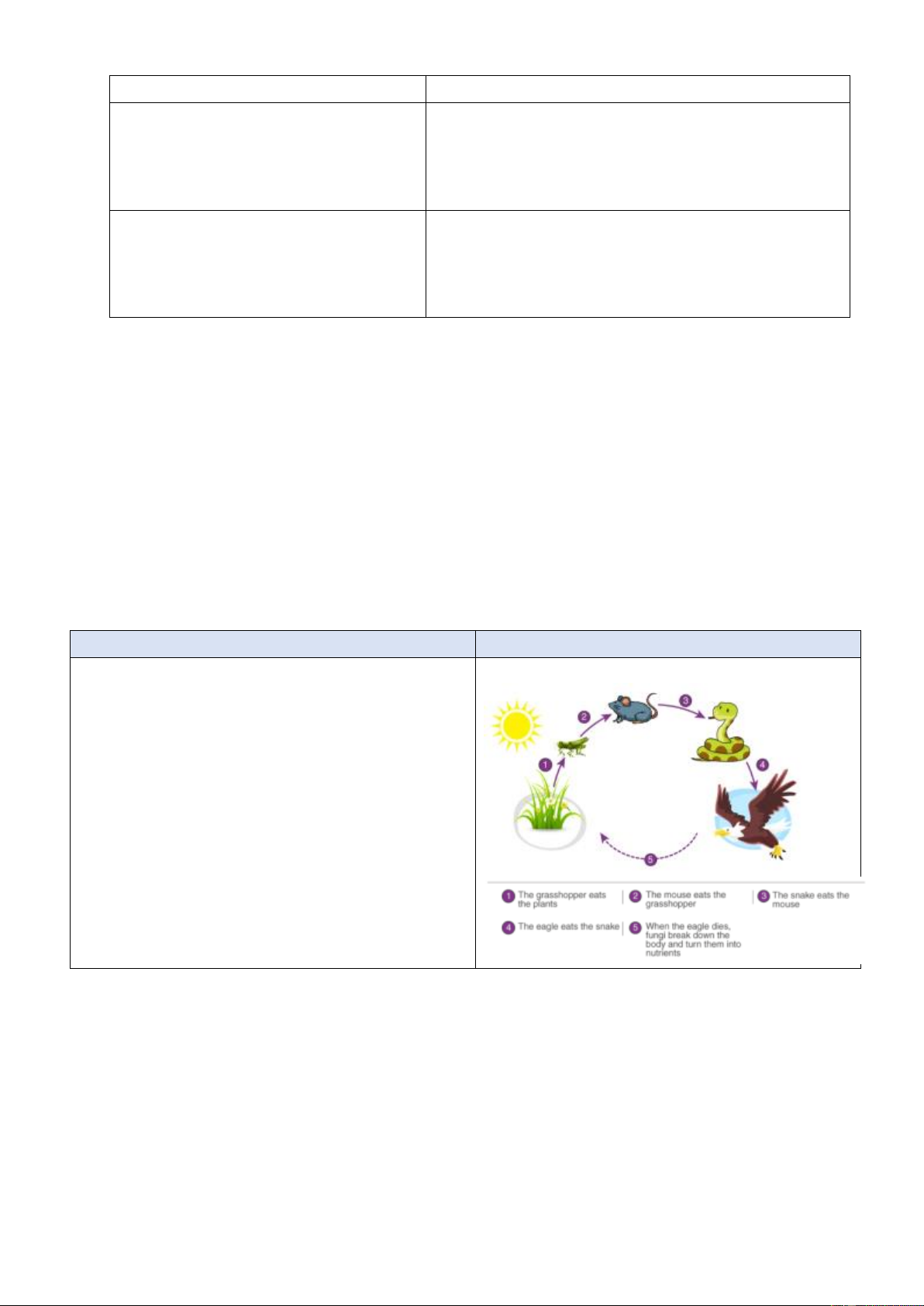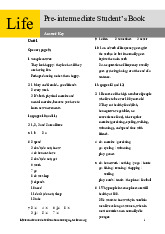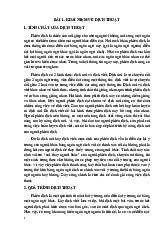



































































































































































































Preview text:
UNIT 7: EDUCATION OPTIONS FOR SCHOOL-LEAVERS
Lesson 1: Getting started – Planning our education I. OBJECTIVES
By the end of this lesson, students will be able to: 1. Knowledge
- Gain an overview about the topic Education options for school-leavers;
- Gain vocabulary to talk about plan the education;
- Get to know the language aspects: Perfect gerunds. 2. Competences
- Develop communication skills and creativity;
- Be collaborative and supportive in pair work and teamwork.
- Actively join in class activities 3. Personal qualities
- Familiarize with the ways to plan the education. II. MATERIALS
- Grade 11 textbook, Unit 7
- Computer connected to the Internet
- Projector / TV/ pictures and cards - hoclieu.vn Language analysis Form Pronunciation Meaning 1. (university) /ˈentrəns ɪɡˌzæm/
an exam that you take to be accepted into a entrance exam university 2. option (n) /ˈɒpʃən/
one thing that can be chosen from a set
of possibilities, or the freedom to make a choice 3. academic (adj) /ˌækəˈdemɪk/
connected with education, especially
studying in schools and universities 4. vocational (adj) /vəʊˈkeɪʃənəl/
connected with the skills, knowledge, etc.
that you need to have in order to do a particular job 5. mechanic (n) /məˈkænɪk/
someone whose job is repairing the
engines of vehicles and other engines 6. sensible (adj) /ˈsensəbəl/
able to make good judgements based on
reason and experience rather than emotion Assumption
Anticipated difficulties Solutions
Students may find the lesson boring
- Encourage students to work in pairs and in groups
due to a large number of language
so that they can help each other. exercises.
- Provide feedback and help if necessary.
- Explain expectations for each task in detail. Have
Some students will excessively talk in
excessive talking students practice. the class.
- Continue to explain task expectations in small
chunks (before every activity). III. PROCEDURES 1. WARM-UP (5 mins) a. Objectives:
- To stir up the atmosphere and activate students’ knowledge on the topic of Education
options for school-leavers;
- To set the context for the listening and reading part;
- To enhance students’ skills of cooperating with teammates. b. Content:
- Guessing game: Guess the name of famous universities in Viet Nam c. Expected outcomes:
- Students can identify famous universities in Viet Nam d. Organisation
TEACHER’S AND STUDENTS’ ACTIVITIES CONTENTS GUESSING GAME Lists of university: - Ss work in 4 big groups.
+ Foreign Trade University
- Teacher shows the pictures of 5 famous university in Vietnam and
+ University of Languages and International Studies
lets students in each group raise their hands to answer
+ National Economics University
- The fastest team will give the answer and get the point with the
+ Hanoi University of Science and Technology correct answer. + Thuongmai University
- The first team with more correct answers will be the winner. e. Assessment
- Teacher observes the groups and gives feedback.
2. ACTIVITY 1: PRESENTATION (7 mins) a. Objectives:
- To get students learn vocabulary related to the topic. b. Content:
- Pre-teach vocabulary related to the content of the dialogue. c. Expected outcomes:
- Students can use key language more appropriately before they read. d. Organisation
TEACHER’S AND STUDENTS’ ACTIVITIES CONTENTS
Vocabulary pre-teaching Word list:
- Teacher introduces the vocabulary.
1. (university) entrance exam
- Teacher explains the meaning of the new vocabulary by pictures. 2. option (n)
- Teacher checks students’ understanding with the “Rub out and 3. academic (adj) remember” technique. 4. vocational (adj)
- Teacher reveals that these five words will appear in the reading 5. mechanic (n)
text and asks students to open their textbook to discover further. 6. sensible (adj) e. Assessment
- Teacher checks students’ pronunciation and gives feedback.
- Teacher observes Ss’ writing of vocabulary on their notebooks.
3. ACTIVITY 2: PRACTICE (20 mins) a. Objectives:
- To help students get to know the topic.
- To introduce words and phrases related to education.
- To help Ss identify the perfect gerunds. b. Content:
- Task 1: Listen and read (p.76)
- Task 2: Read the conversation again. Decide whether the following statements are true (T) or false (F). (p.77)
- Task 3: Find phrases in the conversation that mean the following. (p.77)
- Task 4: Complete the sentences using phrases from the conversation. (p.77) c. Expected outcomes:
- Students can thoroughly understand the content of the text and complete the tasks successfully. d. Organisation
TEACHER’S AND STUDENTS’ ACTIVITIES CONTENTS
Task 1: Listen and read. (5 mins)
- Teacher asks Ss to look at the pictures in the book as well as the
dialogue and answer the questions.
- Ss answer the questions in pairs.
- Teacher plays the recording twice. Ss listen and read.
- Teacher checks Ss’ prediction. T calls 2 Ss to read the conversation aloud. Questions: - What can you see?
- What does Mai want to do after finishing school?
- What does Nam want to do after finishing school?
Suggested answers:
- A female scientist and a male mechanic
- She wants to go to university, study biology and become a scientist.
- Nam wants to go to a vocational school because he
wants to become a car mechanic.
Task 2: Read the conversation again. Decide whether the following statements are true (T) or false (F). (5 mins)
- Teacher tells Ss to read the conversation again and work
independently to find the answers. Remind Ss to underline the Key:
information and correct the false statements. 1. F
- Ss work independently to find the answers. 2. T
- Teacher has Ss compare the answers in pairs before checking 3. T with the whole class. 4. F
- Teacher checks the answers as a class and gives feedback.
Task 3: Find phrases in the conversation that mean the following. (5 mins)
- Teacher asks Ss to read the definitions, then scan the
conversation looking for words or phrases matching the Answer key: meanings. 1. education fair
- Teacher has Ss compare and share their answers with the class. 2. entrance exam - Check answers as a class. 3. academic education
Extension: Put Ss into groups and have each group write as
many phrases as they can with the words education, school and 4. vocational school
exam (e.g. primary/ vocational/ university education, pursue/ get/
receive (your/an) education, education system/ programme; go
to/ start/quit/ leave school, primary/ secondary school; take/ do/
sit/ pass/ fail an exam, revise for an exam, exams in Maths/
English, exam paper/ results). Set a time limit of five minutes.
When the time is up, put up their lists of phrases on the board.
Ask Ss from different groups to read them aloud and count the
correct ones. The winner is the group with most correct phrases.
Task 4. Complete the sentences using phrases from the conversation. (5 mins)
- Teacher has Ss read each sentence individually. Encourage Answer key:
them to try to complete it with an appropriate verb phrase
without referring to the conversation. Then ask them to find the 1. Having won
answers in the conversation. 2. having gone
- Teacher checks answers: first ask the class to call out the 3. Having watched
correct perfect gerund or perfect participle clause, then call on
individual Ss to read the complete sentences.
- Teacher tells Ss that they will learn more about the grammar
point in the following lesson. e. Assessment
- Teacher’s observation on Ss’ performance.
- Teacher’s feedback and peers’ feedback.
4. ACTIVITY 3: PRODUCTION (10 mins) a. Objectives:
- To help Ss practice speaking skills;
- To help Ss memorize the basic knowledge of the topic. b. Content: - Role-play c. Expected outcomes:
- Students can give a short talk about their options after finishing school. d. Organisation
TEACHER’S AND STUDENTS’ ACTIVITIES CONTENTS Task 5. Role-play
- Teacher asks Ss to work in groups.
Students’ own creativity.
- In each group, one student plays the role of
teacher and others will be students
- Teacher asks the students about their plans after
high school and students will share their plans.
- Ss have 3 minutes to prepare for the role-play.
- Teacher invites 1 or 2 groups to come to the stage and do the role-play.
- Teacher asks other groups to listen and give comments.
- Teacher gives feedback and give marks to the best group. e. Assessment
- Teacher’s observation on Ss’ performance.
- Teacher’s feedback and peers’ feedback.
4. CONSOLIDATION (3 mins) a. Wrap-up
- T asks Ss to talk about what they have learnt in the lesson. b. Homework - Do workbook exercises
- Prepare for Lesson 2 - Unit 7.
- Prepare for the project in Lesson 8 Board Plan Date of teaching
Unit 7: Education options for school-leavers
Lesson 1: Getting started – Planning our education * Warm-up: Guessing game * Vocabulary 1. (university) entrance exam 2. option (n) 3. academic (adj) 4. vocational (adj) 5. mechanic (n) 6. sensible (adj) - Task 1: Listen and read. - Task 2: True or false.
- Task 3: Find phrases in the conversation that mean the following.
- Task 4: Complete the sentences. - Task 5: Role-play *Homework
UNIT 7: EDUCATION OPTIONS FOR SCHOOL-LEAVERS Lesson 2: Language I. OBJECTIVES
By the end of this lesson, Ss will be able to: 1. Knowledge
- Use the lexical items related to the topic education options after leaving school;
- Recognise and practise intonation in Wh- and Yes/ No questions;
- Review the use of Perfect gerunds and. Perfect participle clauses. 2. Core competence
- Be collaborative and supportive in pair work and team work;
- Access and consolidate information from a variety of sources;
- Actively join in class activities. 3. Personal qualities
- Be ready to decide education options after leaving school II. MATERIALS
- Grade 11 textbook, Unit 7, Language
- Computer connected to the Internet
- Projector / TV/ pictures and cards - hoclieu.vn Language analysis Perfect gerunds
The perfect gerund (having done) always refers to a time before that of the verb in the main clause. It is used
to emphasise that the action was completed in the past. It can be used as:
• the subject of a sentence.
Example: Having studied science subjects made it easy for me to choose a university degree.
• an object after some verbs, e.g. admit, deny, forget, mention, regret, and remember or after prepositions.
Example: My friend didn’t remember having lent me his English textbook.
My cousin often talked about having studied for five years at a top university.
Perfect participle clauses
The perfect participle has the same form as the perfect gerund, e.g. having asked, having studied.
We can use perfect participle clauses to:
• describe an action that happened before the action in the main clause.
Example: Having finished their course, they started looking for jobs.
• talk about the reason for the action in the main clause.
Example: Not having read the book, he can’t give us his opinion. Assumption
Anticipated difficulties Solutions
- Encourage students to work in pairs and in groups so
Students are reluctant to work in
that they can help each other. groups.
- Provide feedback and help if necessary.
- Explain expectations for each task in detail.
- Continue to explain task expectations in small
chunks (before every activity).
Students may lack vocabulary to
- Provide vocabulary and useful language before deliver a speech assigning tasks
- Encourage students to work in groups so that they can help each other. III. PROCEDURES 1. WARM-UP (5 mins) a. Objectives:
- To stir up the atmosphere and activate students’ knowledge on intonation;
- To enhance students’ skills of cooperating with teammates. b. Content:
- Watch a video about intonation in wh- and yes/no questions. c. Expected outcomes:
- Students can listen and find out the rules for intonation in wh- and yes/no questions. d. Organisation
TEACHER’S AND STUDENTS’ ACTIVITIES CONTENTS Watch a video
Link: https://youtu.be/1-yjtPZTDuc
- Teacher plays the video and asks Ss to pay attention to the intonation rules in the video
- Ss watch the video and note down the rules.
- Teacher calls some Ss to share and confirm the answers.
- Teacher leads in the new lesson. e. Assessment
- Teacher observes the groups and gives feedback.
2. ACTIVITY 1: PRONUNCIATION (10 mins) a. Objectives:
- To help Ss recognise and practise intonation in wh- and yes/no questions.
- To help Ss practise intonation in wh- and yes/no questions. b. Content:
- Task 1: Listen and repeat. Pay attention to the falling or rising intonation in each of the following questions. (p.77)
- Task 2: Listen and mark the intonation in these questions, using (rising intonation) or
(falling intonation). Then practise saying them in pairs. (p.77) c. Expected outcomes:
- Students can practise intonation in wh- and yes/no questions. d. Organisation
TEACHER’S AND STUDENTS’ ACTIVITIES CONTENTS
Task 1: Listen and repeat. Pay attention to the falling or rising intonation in each of the following questions. (5 mins)
- Teacher asks Ss to listen to the recording. Have them pay attention Audio script:
to the rising or falling intonation in the given sentences.
- Teacher asks Ss to work in pairs and take turns to read the 1. Did anyone go?
sentences with correct intonation.
2. Would you like to share some of it with the class?
- Teacher checks the answers as a class.
- Teacher has Ss read the explanation in the Remember! box Ask
questions to check understanding of the use of rising and falling 3. What are your plans for the future?
intonation in Wh- and Yes/No questions.
4. When does the course start?
Task 2: Listen and mark the intonation in these questions, using (rising intonation) or (falling intonation). Then
practise saying them in pairs. (5 mins) Answer key:
- Teacher asks Ss to listen to the Wh- and Yes/No questions and
mark the correct intonation pattern (rising or falling) at the end of 1. Do you want to go to university? each question.
2. Have you talked with your parents about your
- Teacher plays the recording several times, if necessary, pause after
each sentence for Ss to repeat. plans?
- Teacher checks answers as a class.
3. How much does it cost to study at university?
- Teacher puts Ss into pairs and have them practise saying these
questions. Walk round the class, praising pairs for good effort and
using the appropriate intonation pattern.
4. What’s your favourite subject at school?
Extension: In stronger classes, put Ss into groups and have each
group write three Wh-questions and three Yes/No questions. Invite
each group to read out their questions in front of the class. Have the
other groups say if they use the appropriate intonation. e. Assessment
- Teacher checks students’ pronunciation and gives feedback.
- Students in class listen and give feedback on their friends’ performance.
3. ACTIVITY 2: VOCABULARY (12 mins) a. Objectives:
- To introduce words / phrases related to education after leaving school.
- To help Ss practise the words in meaningful contexts. b. Content:
- Task 1: Match the words and phrases with their meanings. (p.78)
- Task 2: Complete the sentences using the correct forms of the words and phrases in 1. (p.78) c. Expected outcomes:
- Students understand the meaning of words, memorise them and are able to use them in meaningful context. d. Organisation
TEACHER’S AND STUDENTS’ ACTIVITIES CONTENTS
Task 1. Match the words and phrases with their meanings. (6 mins)
- Teacher asks Ss to read the definitions of the phrases first and checks understanding. Answer key:
- Teacher has Ss match each word with the definition right next to it. 1. c
- In weaker classes, do the first one as an example before asking Ss to
match the rest individually or in pairs. 2. d - Check answers as a class. 3. a 4. e 5. b
Task 2. Complete the sentences using the correct forms of the words and phrases in 1. (6 mins)
- Teacher tells Ss to read the sentences carefully and decide which word in
Task 1 can be used to complete each of the sentences. Tell them to change Answer key:
the forms of some words if necessary. 1. higher education
- Teacher checks answers as a class. Have Ss call out the word they have used in each sentence first. 2. qualifications
- Teacher confirms the correct answers. Ask Ss to explain the meaning of
each word using the definitions in Activity 1. 3. school-leavers
- Teacher asks some Ss to read the complete sentences.
4. vocational education
Extension: In stronger classes, have Ss play a game individually or in
pairs. Each student or pair writes a short meaningful text in which all four 5. graduation
phrases have been used. Give a time limit of three minutes and have each
student or pair read out their texts. The other Ss give a mark out of 10. Suggested answer:
Have Ss add up their marks. The winner is the student or pair with the Every year, thousands of school-leavers finish highest score.
secondary education. Most of them choose to
continue their study in either higher
education institutions or vocational education
institutions. These students believe that with
the right qualifications from these institutions,
they will have a better chance of getting good jobs after graduation. e. Assessment
- Teacher’s observation on Ss’ performance.
- Teacher’s feedback and peers’ feedback.
4. ACTIVITY 3: GRAMMAR (15 mins) a. Objectives:
- To help Ss recognise and practice perfect gerunds
- To help Ss recognise and practice perfect participle clauses
- To help Ss practice perfect gerunds and perfect participle clauses in a speaking activity b. Content:
- Task 1: Find and correct the mistakes in the following sentences. (p.78)
- Task 2: Rewrite these sentences using perfect participle clauses. (p.79)
- Task 3: Work in pairs. Make sentences, using perfect gerunds and perfect participle clauses. (p.79) c. Expected outcomes:
- Students know how to use the perfect gerunds or perfect participle clauses and can apply
them to give a short talk on the given topic. d. Organisation
TEACHER’S AND STUDENTS’ ACTIVITIES CONTENTS
Task 1. Find and correct the mistakes in the following sentences. (5 mins) Answer key:
- Teacher asks Ss to look at the Remember! box and read the rules for
using perfect gerunds. Check understanding by asking, e.g. Which verbs 1. I forgot have discussed this topic with you. �
are often followed by a perfect gerund? (admit, deny, forget, and having
remember); Can a perfect gerund be used as a subject / an object? (Yes);
What are the similarities between gerunds and perfect gerunds?(They 2. Had won many maths competitions helped me
both can be used as subjects and objects); What are the differences to win a place at university.
between gerunds and perfect gerunds? (Their forms; perfect gerunds
refer to the actions that were completed in the past) � Having
- Teacher tells Ss to work in pairs or individually to complete the 3. Nam regretted not having choose a more activity.
interesting course at university.
- Teacher checks answers as a class. � chosen
- Extension: Write more sentences with mistakes in using perfect 4. He was proud of had won the first place in a
gerunds on the board and have Ss correct them in pairs, e.g. The thief
denied stolen the expensive watch (denied having stolen); I remember biology competition.
saw this advertisement (remember having seen) � having
Task 2. Rewrite these sentences using perfect participle clauses. (6 mins)
- Teacher has Ss read the Remember box and ask questions to check Ss’ Answer key:
understanding of the form and uses of perfect participle clauses.
1. Having listened to an introduction to the
- Teacher asks Ss to read each sentence carefully and decide how they course
2. Having failed the university entrance exams
can complete another sentence with a participle clause that still has the
3. Not having studied hard enough
same meaning as the given one.
4. Having answered the job interview questions
- Teacher has Ss work in pairs to write the sentences.
- Teacher checks answers as a class. Invite individual Ss to write the sentences on the board.
Extension: Have Ss work in pairs. Ask Ss to study these sentences
again. One student says the original sentence. The other students,
without looking at the book, says the new sentence. The student who
says the original sentence should keep the book open to check if the
partner says the correct sentence.
Task 3. Work in pairs. Make sentences, using perfect gerunds and perfect participle clauses. (4 mins)
- Teacher lets Ss work in pairs. Example:
- Teacher asks Ss to make sentences using perfect gerunds and perfect
Having completed the project gave us a feeling participle clauses. of satisfaction.
- Teacher encourages Ss to apply the vocabulary they have learnt in the
Having finished school, I can apply to lesson. university. e. Assessment
- Teacher’s observation on Ss’ performance.
- Teacher’s feedback and peers’ feedback. 4. CONSOLIDATION (3 mins) a. Wrap-up
- T asks Ss to talk about what they have learnt in the lesson. b. Homework
- Do exercises in the workbook.
- Prepare for Lesson 3 - Reading. Board Plan Date of teaching
Unit 7: Education options for school-leavers Lesson 2: Language *Warm-up Watch a video * Pronunciation
- Task 1: Listen and repeat.
- Task 2: Listen and mark the intonation in these questions. * Vocabulary
- Task 1: Match the words and phrases with their meanings. (p.78)
- Task 2. Complete the sentences. * Grammar
- Task 1. Find and correct the mistakes.
- Task 2. Rewrite these sentences. - Task 3. Make sentences. *Homework
UNIT 7: EDUCATION OPTIONS FOR SCHOOL-LEAVERS
Lesson 3: Reading – Options for school-leavers I. OBJECTIVES
By the end of this lesson, Ss will be able to: 1. Knowledge
- Develop reading skills for general ideas and for specific information about options for school-leavers. 2. Competences
- Develop communication skills and creativity;
- Be collaborative and supportive in pair work and teamwork;
- Develop presentation skills;
- Actively join in class activities. 3. Personal qualities
- Be ready to decide education options after leaving school II. MATERIALS
- Grade 11 textbook, Unit 7, Reading
- Computer connected to the Internet
- Projector / TV/ pictures and cards - hoclieu.vn Language analysis Form Pronunciation Meaning
1. opportunity (n) /ˌɒp.əˈtʃuː.nə.ti/
a time when a particular situation makes it possible to do or achieve something 2. independently
/ˌɪn.dɪˈpen.dənt.li/ without being connected with or influenced by (adv) something or by each other
3. hands-on (adj) /ˌhændˈzɒn/
doing something rather than just talking about it 4. salary (n) /ˈsæl.ər.i/
money that employees receive for doing their job,
especially professional employees or people working
in an office, usually paid every month Assumption
Anticipated difficulties Solutions
1. Students may lack knowledge about
Provide students with the meaning and pronunciation some lexical items. of words.
- Let students read the text again (if necessary).
- Create a comfortable and encouraging environment
2. Students may have underdeveloped for students to speak.
reading, speaking and co-operating
- Encourage students to work in pairs, in groups so skills.
that they can help each other.
- Provide feedback and help if necessary. III. PROCEDURES 1. WARM-UP (5 mins) a. Objectives:
- To activate Ss’ background knowledge about the topic and get Ss involved in the lesson;
- To set the context for the reading part;
- To enhance students’ skills of cooperating with teammates. b. Content:
- Task 1: Answer the questions c. Expected outcomes:
- Students can talk about the options after leaving school. d. Organisation
TEACHER’S AND STUDENTS’ ACTIVITIES CONTENTS
Task 1: Answer the questions
- Teacher asks Ss look at the pictures of a university
student and a vocational school student. Have them to
work in pairs and discuss which of the two options is
more common in the area they live in.
- Teacher encourages Ss to think of other options.
A vocational school student A university student
- Teacher invites some pairs to share their answers with the class. Questions:
1. Which of the two options for school-leavers is more common in your town?
2. Can you think of other options? Students’ answers e. Assessment
- Teacher observes the groups, collects their answers and gives feedback.
2. ACTIVITY 1: PRE-READING (6 mins) a. Objectives:
- To get students learn vocabulary related to the topic;
- To activate prior knowledge about the topic and get Ss involved in the lesson. b. Content:
- Lead students in the reading passage;
- Pre-teach vocabulary related to the content of the reading passage. c. Expected outcomes:
- Students can use key language more appropriately before they read. d. Organisation
TEACHER’S AND STUDENTS’ ACTIVITIES CONTENTS
Vocabulary pre-teaching (5 mins)
- Teacher introduces the vocabulary. Word list:
- Teacher explains the meaning of the new vocabulary by pictures. 1. opportunity (n)
- Teacher checks students’ understanding with the “Rub out and 2. independently (adv) remember” technique. 3. hands-on (adj)
- Teacher reveals that these four words will appear in the reading 4. salary (n)
text and asks students to open their textbook to discover further. e. Assessment
- Teacher checks students’ pronunciation and gives feedback.
- Teacher observes Ss’ writing of vocabulary on their notebooks.
3. ACTIVITY 2: WHILE-READING (20 mins) a. Objectives:
- To help Ss practise guessing the meaning of words from context;
- To develop reading skills for general information;
- To develop reading skills for specific information. b. Content:
- Task 2. Read the article. Match the highlighted words with their meanings. (p.79)
- Task 3. Read the article again. Match the headings (1–3) with the paragraphs (A–B). There is one extra heading. (p.80)
- Task 4. Read the article again and complete each gap with ONE word. (p.80) c. Expected outcomes:
- Students can thoroughly understand the content of the text and complete the tasks successfully d. Organisation
TEACHER’S AND STUDENTS’ ACTIVITIES CONTENTS
Task 2. Read the article. Match the highlighted words with their meanings. (6 mins)
- Teacher has Ss read the text, paying attention to the context of each Answer key:
highlighted word, and looking for clues that they can use to guess the 1. e
meaning, e.g. the first word "formal" in this context is used as an adjective to 2. c
describe the ‘learning’ to get ‘an academic degree’. Among the given options, 3. a
option ‘e’ (received in a school, college, or university, with lessons, exams, 4. b
etc.) is the best match for this word. 5. d
- Teacher tells Ss to work in groups to discuss the clues and compare answers.
- Teacher checks answers as a class.
Extension: Choose other words from the text and write them on different
pieces of paper. Give a word to each student, have them check its meaning in a
dictionary and write a short definition on another piece of paper. Collect all
definitions and place them face up on a table. Have Ss swap their words, come
to the table and find the definition of their new word.
Task 3. Read the article again. Match the headings (1–3) with the paragraphs (A–B). There is one extra heading. (7 mins) Answer key:
- Teacher elicits strategies Ss can use to read texts for main ideas, e.g. paying A - 3
attention to the topic sentence in each paragraph, highlighting key information, B - 1
or searching for conclusions.
- Teacher tells Ss that they will have to choose the correct heading for each
paragraph. In weaker classes, read through the three options first and check understanding.
- Teacher asks Ss to work in pairs to compare their answers.
- Teacher checks answers as a class. In stronger classes, ask Ss to explain their choices.
Task 4. Read the article again and complete each gap with ONE word. (7 mins)
- Teacher tells Ss that the information in the table is a summary of the main Answer key:
points of the two body paragraphs. 1. formal 2. degree
- Teacher has Ss read the points in the table and predict the words they will 3. trade
need to complete the gaps. 4. apprenticeship 5. training
- Teacher reminds Ss of the maximum number of words they can use in each gap.
- Teacher asks Ss to scan the text and choose the correct words or phrases to complete each gap.
- Teacher has Ss compare answers in pairs or groups.
- Teacher checks answers as a class.
- Teacher invites some Ss to give evidence from the text for each of the
answer, e.g. 1. formal (from the first sentence of the second paragraph.) e. Assessment
- Teacher’s observation on Ss’ performance.
- Teacher’s feedback and peers’ feedback.
4. ACTIVITY 3: POST-READING (11 mins) a. Objectives:
- To check students’ understanding about the reading passage;
- To help some students enhance presentation skills; - To practise team working;
- To give students authentic practice in using target language. b. Content:
- Discussion: Which of the two options will be appropriate for you after leaving school? Why? c. Expected outcomes:
- Students can use the language and ideas from the unit to reflect on their own opinions. d. Organisation
TEACHER’S AND STUDENTS’ ACTIVITIES CONTENTS Task 5. Discussion
- Teacher asks Ss to read the questions and choose their option. In Suggested answers:
weaker classes, ask Ss to write down the reasons for their option.
A: Which option will be appropriate for you after leaving school, B?
- Teacher has Ss work in pairs to discuss their options
B: Well, I’m very interested in chemistry and want
- Teacher encourages Ss to explain why they think this is the option
to become a chemistry teacher. That’s why I think
for them. Walk round the class and offer help with any words or
I will study chemistry at a university. How about
expressions Ss may not know. Invite some pairs of Ss to share their you, A? ideas with the whole class.
A: I’ve always wanted to become a chef in a
famous restaurant. I think a cooking course at a
- Teacher asks other students to listen and give comments.
vocational school will be the best option for me.
- Teacher gives feedback and give marks to Ss’ performance. e. Assessment
- Teacher’s observation on Ss’ performance.
- Teacher’s feedback and peers’ feedback.
4. CONSOLIDATION (3 mins) a. Wrap-up
- T asks Ss to talk about what they have learnt in the lesson. b. Homework
- Do exercises in the workbook.
- Prepare for the next lesson – Speaking. Board Plan Date of teaching
Unit 7: Education options for school-leavers
Lesson 3: Reading – Options for school-leavers *Warm-up * Vocabulary 1. opportunity (n) 2. independently (adv) 3. hands-on (adj) 4. salary (n)
- Task 2: Match the highlighted words with their meanings.
- Task 3: Match the headings with the paragraphs.
- Task 4: Complete each gap with ONE word. - Task 5: Discussion *Homework
UNIT 7: EDUCATION OPTIONS FOR SCHOOL-LEAVERS
Lesson 4: Speaking – Vocational training vs. academic study I. OBJECTIVES
By the end of this lesson, Ss will be able to: 1. Knowledge
- Talk about the benefits of vocational training and academic study;
- Know how to end a conversation or discussion. 2. Competences
- Gain some language expressions to talk about the benefits of vocational training and academic study;
- Talk about the benefits of vocational training and academic study;
- Be collaborative and supportive in pair work and teamwork;
- Develop presentation skills; 3. Personal qualities
- Be ready to decide education options after leaving school II. MATERIALS
- Grade 11 textbook, Unit 7, Speaking
- Computer connected to the Internet
- Projector / TV/ pictures and cards - hoclieu.vn Assumption
Anticipated difficulties Solutions
Students may lack more vocabulary to - Provide vocabulary and useful language before deliver a speech. assigning tasks.
- Encourage students to work in groups so that they can help each other.
- Give short, clear instructions and help if necessary. III. PROCEDURES 1. WARM-UP (7 mins) a. Objectives:
- To stir up the atmosphere and activate students’ previous knowledge on vocational training and academic study;
- To set the context for the speaking part; b. Content:
- Students complete the table using suggested and their own ideas. c. Expected outcomes:
- Students can complete the table using suggested and their own ideas. d. Organisation
TEACHER’S AND STUDENTS’ ACTIVITIES CONTENTS Task 1: Brainstorming
Suggested answers:
- Teacher asks Ss to look at the table giving some of the Benefits of Benefits of
benefits of vocational and higher education.
vocational training academic study
- Teacher has Ss work in pairs to complete them with the ● cost less ● can earn more
suggested ideas and add their own ideas.
● provide shorter duration ● develop critical
- Teacher checks comprehension and explain any phrases Ss of study thinking skills
may find hard, e.g. low cost, critical thinking skills, duration
● develop practical skills
● develop research skills of study.
● can find jobs quickly
● personal development ● easier admission ● career preparation requirements ● social experiences
● flexible programmes and start dates e. Assessment
- Teacher observes the students’ performance, collects their answers and gives feedback.
2. ACTIVITY 1: CONTROLLED PRACTICE (8 mins) a. Objectives:
- To activate prior knowledge about the topic and get Ss involved in the lesson. b. Content:
- Introducing tips to end a conversation or discussion;
- Task 2: Complete the conversation with the sentences in the box. Then practise it in pairs. (p. 80) c. Expected outcomes:
- Students can use key language more appropriately when they speak;
- Students have an overview on how to talk about the benefits of vocational training. d. Organisation
TEACHER’S AND STUDENTS’ ACTIVITIES CONTENTS
Task 2: Complete the conversation with the sentences in the box. Then practise it in pairs.
- Teacher asks Ss to read the first part of the conversation. Have Ss
make predictions about what the speakers will talk about next, e.g. Answer key:
the third benefit, summary of the benefits. 1. D 2. A 3. B 4. C
- Teacher puts Ss into pairs to discuss and decide on the order of the
speakers’ lines in the word box to complete the conversation.
- Teacher tells Ss to read the useful expressions in the Tips box and Tips to end a conversation or discussion:
ask if the speakers have used any of them to end their conversation. We can end a conversation or discussion by: •
- Teacher checks answers as a class.
summarising it, e.g. We’ve decided …/ We’ve
agreed to …/ We’ve covered everything/ all points.
• concluding it, e.g. Bye./ Great, we’re now ready for
…/ That’s all we have today./ It was a very useful
discussion/meeting. e. Assessment
- Teacher checks students’ answers and gives feedback.
3. ACTIVITY 2: LESS CONTROLLED PRACTICE (15 mins) a. Objectives:
- To help Ss practise structures to end a conservation or discussion;
- To give Ss an opportunity to practice talking about the benefits of academic study;
- To provide Ss with some benefits of academic study. b. Content:
- Task 3: Work in pairs. Talk about the benefits of academic study. Use the ideas in 1, the
model in 2, and the tips above to help you. (p.81) c. Expected outcomes:
- Students know how to talk about the benefits of academic study and use structures to end a conversation or discussion. d. Organisation
TEACHER’S AND STUDENTS’ ACTIVITIES CONTENTS
Task 3: Work in pairs. Talk about the benefits of academic study. Use the ideas in 1, the model in 2, and the tips
above to help you. (7 mins)
- Teacher explains the task and focus Ss´ attention on the useful phrases Suggested answer:
to end a conversation or discussion. Ask Ss to look at the conversation A: Now, let’s decide on the three main benefits of
and the Tips box in activity 2 again to see how these phrases are used.
academic study. First, I think it will help students
- Teacher has Ss list the benefits of academic study from Activity 1: develop critical thinking skills.
develop critical thinking skills, develop research skills, give
opportunities for further studies, can earn more.
B: I agree. Students can also develop research skills.
- Teacher has Ss work in their pairs from 2 and make their conversation. A: That’s right. These skills are very im
Give a time limit of 8-10 minutes. Walk round the class to monitor Ss’ portant
preparation and make sure that shy Ss also have the opportunity to for university students.
contribute, e.g. ask Ss to look at the list and put them in the order of B: So, what do you think is the third benefit? importance.
A: I think it’s the opportunities for further
- In weaker classes, ask Ss to look at the model conversation in Activity studies. University students get more
2, underline the benefits of vocational training, then they can replace opportunities to continue their studies after
with the benefits of academic study. T can also write some prompts on graduation.
the board, e.g. Now
B: I can’t agree more. So, we’ve decided on the
- Teacher invites some pairs of Ss to role-play their conversations in three main benefits: developing critical thinking
front of the whole class. When Ss finish their conversation, give further skills, developing research skills, and having
comments and correction if necessary. Praise for good effort, clear more opportunities for further studies.
pronunciation and natural interaction.
A: Great! We’re now ready to report to the class. e. Assessment
- Teacher’s observation on Ss’ performance.
- Teacher’s feedback and peers’ feedback.
4. ACTIVITY 3: FURTHER PRACTICE (12 mins) a. Objectives:
- To check students’ understanding about the language use in ending a conversation or discussion;
- To help some students enhance discussing and presentation skills; - To practise team working;
- To give students authentic practice in using target language. b. Content:
- Task 4. Work in groups. Discuss what kind of students/learners each option will be more suitable
for. Give reasons for your decision. Report to the whole class. (p.81) c. Expected outcomes:
- Students can use the language and ideas from the unit and develop their own ideas. d. Organisation
TEACHER’S AND STUDENTS’ ACTIVITIES CONTENTS
Task 4: Work in groups. Discuss what kind of students/learners each option will be more suitable for. Give reasons
for your decision. Report to the whole class. (12 mins)
- Teacher asks Ss to form groups and have a group discussion about what kind Suggested answer:
of students or learners each option will be more suitable for.
In our group, we discussed both options
- For a weaker class, T can provide a sample plan as follows:
and agreed on the following. Academic
+ group members take turns expressing their opinion about which option is
study is suitable for hard-working suitable for which students
students who are highly motivated and
+ groups decide on the most common opinion
want to achieve their goals. Gifted
+ groups prepare an outline of their summary and decide how to present it
students who have a particular talent,
- Teacher tells groups to choose a group leader whose role is to keep the
such as a maths or music talent can also
discussion going and ensure that everyone has a chance to speak. Remind
benefit from university education.
members that they need to listen without interrupting their classmates, wait for
their turn to speak, and contribute ideas.
Vocational training is more suitable for
- Teacher walks around to offer help Ss, if necessary, and encourage quiet
students who learn through practical
group members to get involved.
experience or by doing. It is also suitable
- Teacher invites some groups to report the summary of their discussion and
for students who have decided on a
answer any questions from the rest of the class.
specific trade job, such as a restaurant
- Teacher encourages the rest of the class to follow their friends’ performance
cook, a mechanic, or a hairstylist.
and compare with their own ideas.
- Teacher gives feedback and give marks to Ss’ performance. e. Assessment
- Teacher’s observation on Ss’ performance.
- Teacher’s feedback and peers’ feedback.
4. CONSOLIDATION (3 mins) a. Wrap-up
- T asks Ss to talk about what they have learnt in the lesson. b. Homework
- Do exercises in the workbook.
- Prepare for the next lesson – Listening. Board Plan Date of teaching
Unit 7: Education options for school-leavers
Lesson 4: Speaking – Vocational training vs. academic study *Warm-up - Task 1: Brainstorming
- Task 2: Complete the conversation
- Task 3: Talk about the benefits of academic study. - Task 4: Discussion. *Homework
UNIT 7: EDUCATION OPTIONS FOR SCHOOL-LEAVERS
Lesson 5: Listening – Vocational courses I. OBJECTIVES
By the end of this lesson, Ss will be able to: 1. Knowledge
- Gain more knowledge about vocational courses;
- Memorize vocabulary to talk about vocational courses. 2. Competences
- Develop listening skills: listening for the main idea and listening for specific details
- Be collaborative and supportive in pair work and teamwork;
- Develop presentation skills; 3. Personal qualities
- Be ready to decide education options after leaving school II. MATERIALS
- Grade 11 textbook, Unit 7, Listening
- Computer connected to the Internet
- Projector / TV/ pictures and cards - hoclieu.vn Assumption
Anticipated difficulties Solutions
Students may lack more vocabulary to - Explain the meaning of new words and useful deliver a speech.
language before assigning tasks.
- Encourage students to work in groups so that they can help each other.
- Give short, clear instructions and help if necessary.
Students cannot follow the speed of the - Make sure they understand the meaning and recording.
pronunciation of important words.
- Teach them the skill of underlining key words in the questions before they listen.
- Play more time if necessary. III. PROCEDURES 1. WARM-UP (5 mins) a. Objectives:
- To stir up the atmosphere and activate students’ knowledge on family the topic and get Ss involved in the lesson;
- To set the context for the listening part; b. Content:
- Task 1: Look at the picture and answer the questions (p.81) c. Expected outcomes:
- Students can answer the given questions. d. Organisation
TEACHER’S AND STUDENTS’ ACTIVITIES CONTENTS
Task 1: Look at the picture and answer the questions
- Teacher tells Ss to look at the picture and the questions.
Help Ss to understand the questions and prepare for their
answers by asking questions, e.g. What can you see in the
picture? (A person is showing others the way to prepare food.)
- Teacher asks Ss to work in pairs to answer the questions.
Encourage them to ask each other questions and give more
details about their answers.
- Teacher invites some Ss to share their answers or their
partner’s answers with the class. Questions:
1. What kind of vocational course are they taking?
2. Do you think students need any special qualifications to apply for this course?
3. What do you think students expect to learn from this course? Suggested answers:
1. They are taking a cooking course.
2. No, I don’t think students need any special qualifications
to apply for this course. Students just need to be passionate about food and cooing.
3. I think students expect to learn efficient and safe knife
skills, how to make sauces and stocks, and how to plate and
present dishes. They will also learn the science behind food
changes when food is cooked, and the latest food trends to stay current. e. Assessment
- Teacher observes the students’ performance, collects their answers and gives feedback.
2. ACTIVITY 1: PRE-LISTENING (7 mins) a. Objectives:
- To get students learn vocabulary related to the topic;
- To activate prior knowledge about the topic and get Ss involved in the lesson. b. Content:
- Task 2: Choose the correct meanings of the underlined words. (p.81) c. Expected outcomes:
- Students understand the meaning and know how to pronounce some words from the recording. d. Organisation
TEACHER’S AND STUDENTS’ ACTIVITIES CONTENTS
Task 2. Choose the correct meanings of the underlined words. (7 mins)
- Teacher asks Ss to read the sentences containing key vocabulary
items from the listening. Tell students to study the context clues Answer key:
carefully, then read the given options for each word in bold and try
to choose the correct one. 1. B
- Teacher has Ss check their answers in pairs. 2. A
- Teacher confirms the correct answers as a class. 3. B e. Assessment
- Teacher checks students’ pronunciation and gives feedback.
- Teacher observes Ss’ writing of vocabulary in their notebooks.
3. ACTIVITY 2: WHILE-LISTENING (20 mins) a. Objectives:
- To help Ss practise listening for the main idea;
- To help Ss practise listening for specific information;
- To provide Ss with some basic information about vocational courses. b. Content:
- Task 3. Listen to a conversation between Mai and the receptionist at ABC Vocational
School. What are they talking about? (p.81)
- Task 4. Listen to the conversation again and complete the notes below. Use no more
than TWO words for each gap. (p.81) c. Expected outcomes:
- Students can catch the main idea as well as specific details of the recording and complete the tasks successfully. d. Organisation
TEACHER’S AND STUDENTS’ ACTIVITIES CONTENTS
Task 3. Listen to a conversation between Mai and the receptionist at ABC Vocational School. What are they talking about? (8 mins) Answer key:
- Teacher asks Ss to read the instructions to find out the context of this B
activity and its aim listening for the main idea.
- Teacher has Ss read the options carefully and check if they understand all the vocabulary.
- Teacher plays the recording and have Ss listen and choose the correct option.
- Teacher asks Ss to compare their answers in pairs groups.
- Teacher checks answers as a class and let Ss listen again, if necessary,
e.g. when working with weak classes.
Task 4. Listen to the conversation again and complete the notes below. Use no more than TWO words for each gap. (12 mins)
- Teacher has Ss read through notes carefully and check if they Answer key:
understand all the vocabulary. 1. months
- Teacher asks Ss to think about the type of information they will need 2. professional
to answer each of these questions, e.g. 1. length of time; 2. type of 3. restaurant cooks
courses; 3. jobs/people in certain professions; 4. positions in a real 4. apprentice
restaurant; 5. booklet or magazine.
5. (school) brochure
- Teacher reminds Ss of the word limit they will have for each answer.
- Teacher plays the recording. Ask Ss to listen and fill in the gaps within the word limit.
- Teacher has Ss compare their answers.
- Teacher checks answers as a class and confirm the correct ones.
- Extension: Play the recording, pausing before the last word of long
sentences and have Ss recall or guess it, e.g. play the sentence until the
word ‘courses’: I’d like to ask for information about your… Have Ss
call out the last word. In stronger classes, ask Ss to write the words on the board. e. Assessment
- Teacher’s observation on Ss’ performance.
- Teacher’s feedback and peers’ feedback.
4. ACTIVITY 3: POST-LISTENING (10 mins) a. Objectives:
- To check students’ understanding and memorize the information in the recording;
- To help some students enhance presentation skills; - To practise team working;
- To give students authentic practice in using target language. b. Content:
- Task 5: Work in groups. Discuss the following questions. (p.82) c. Expected outcomes:
- Students can use the language and ideas from the listening to discuss other information about the courses d. Organisation
TEACHER’S AND STUDENTS’ ACTIVITIES CONTENTS
Task 5: Work in groups. Discuss the following questions. (10 mins)
- Teacher asks Ss to recall what information Mai received when talking
Suggested answers:
to the receptionist at ABC Vocational School (names of courses, length
I’d be interested in a cooking course because
of study, apprenticeship, brochure about the courses).
cooking has always been my hobby. In addition,
- Teacher puts Ss into groups to answer the question. Walk round the
I think the time of training is quite short, and the
class and offer help. For weaker classes, give them some suggestions,
cost is also affordable for me and my family.
e.g. cost, number of students in a class, job opportunities after finishing
I like the fact that this course also provides
the course, … Make sure Ss take notes of their ideas.
apprenticeship opportunities. This will help me
- Teacher invites Ss from some groups to share their ideas with the
fіnd a suitable job immediately after I fіnish the whole class. course. e. Assessment
- Teacher’s observation on Ss’ performance, provide help if necessary.
- Teacher’s feedback and peers’ feedback.
4. CONSOLIDATION (3 mins) a. Wrap-up
- T asks Ss to talk about what they have learnt in the lesson. b. Homework
- Do exercises in the workbook.
- Prepare for the next lesson – Writing. Board Plan Date of teaching
Unit 7: Education options for school-leavers
Lesson 5: Listening – Vocational courses *Warm-up
Task 1: Look at the picture and answer the questions.
Task 2: Choose the correct meanings of the underlined words.
Task 3: Listen to a conversation.
Task 4: Complete the notes.
Task 5: Discussion. *Homework
UNIT 7: EDUCATION OPTIONS FOR SCHOOL-LEAVERS
Lesson 6: Writing – A request letter about a course I. OBJECTIVES
By the end of this lesson, Ss will be able to: 1. Knowledge
- Gain an overview about how to write a letter requesting information about a course;
- Apply structures to request information. 2. Competences
- Develop writing skills, in terms of vocabulary, grammar, coherence and cohesion.
- Be collaborative and supportive in pair work and teamwork;
- Develop presentation skills; 3. Personal qualities
- Be ready to decide education options after leaving school II. MATERIALS
- Grade 11 textbook, Unit 7, Writing
- Computer connected to the Internet
- Projector / TV/ pictures and cards - hoclieu.vn Assumption
Anticipated difficulties Solutions
Students may have underdeveloped
- Guide students to make an outline before they write. writing skills.
- Encourage students to work in pairs and in groups so
that they can help each other.
- Provide feedback and help if necessary. III. PROCEDURES 1. WARM-UP (5 mins) a. Objectives:
- To stir up the atmosphere and activate students’ reading comprehension of short messages;
- To set the context for the writing part; b. Content:
- Do a quiz game to get to know authentic short messages. c. Expected outcomes:
- Students can join the quiz and gain knowledge on the topic. d. Organisation
TEACHER’S AND STUDENTS’ ACTIVITIES CONTENTS Game: Hidden picture Clues: - Ss work in groups.
1. Connected with a job that needs special training and skills
- There are 4 questions which relate to a key picture.
2. A person working for an employer to learn a skill or a job
- T asks Ss to guess the word in each puzzle and guess the key
3. A small book giving information about something
picture behind after each puzzle is opened.
4. A person who has just left school
- The group which gets the correct answer of the key picture is Answer key: the winner. 1. professional 2. (an) apprentice 3. (a) brochure 4. (a) school-leaver KEY WORD: LETTER e. Assessment
- Teacher observes the students’ performance, collects their answers and gives feedback.
2. ACTIVITY 1: PRE-WRITNG (11 mins) a. Objectives:
- To get students to build up ideas that they can later use for their writing
- To provide students with useful structures and tips to write letters asking for information. b. Content:
- Task 1: Look at the advertisement about a vocational school and its tour guide training
courses. You want to ask for more information. Complete the enquiries. (p.82) c. Expected outcomes:
- Students build up ideas for their writing. d. Organisation
TEACHER’S AND STUDENTS’ ACTIVITIES CONTENTS
Task 1. Look at the advertisement about a vocational school and its tour guide training courses. You want to ask for
more information. Complete the enquiries. (6 mins)
Suggested answers:
- Teacher asks Ss to look at the advertisement about a vocational 1. if/whether I need to take a test?
school and its tour guide training courses.
2. if/whether there are discounts for poor students.
3. how much the daily wage is.
- Teacher asks Ss to read the information about the course and
check understanding, e.g. Do applicants need any qualifications?
Are the courses expensive?
- Teacher focuses Ss’ attention on the text in the three boxes and
ask, Does the advert provide this information? Then put Ss in pairs
and have them work together to complete the enquiries under the advert.
- Teacher walks around and offer help if necessary.
- Teacher has some pairs read the completed sentences. Write the correct ones on the board. Tips (5 mins)
- Teacher asks Ss to look at the given outline of the letter, the Tips Formal emails or letters asking for information
box and the information from Activity 1
usually have the following structure:
- Teacher explains more about the structure of the letter and useful 1. Greeting. Example: Dear Sir/Madam, (or name if known) expressions.
2. Reason(s) for writing. Example: I would like to
- Students note down the information.
have more information about …/I am writing to enquire about …
3. Enquiries (one paragraph for each of the things you
want to ask about, using linking words or phrases).
Example: First, I would like to know … /In addition, I
wonder if …/I would appreciate it if you could tell me
…/It would be great if you…
4. Closing line. Example: I look forward to hearing
from you/receiving your reply.
5. Signature. Example: Yours sincerely, (if you know
the name of the person you are writing to)/ Yours
faithfully, (if you don’t know the name) e. Assessment
- Teacher observes Ss’ work and gives feedback.
3. ACTIVITY 2: WHILE-WRITING (15 mins) a. Objectives:
- To help Ss familiarize with the structure and language of an opinion essay; b. Content:
- Task 2. Write a letter (140–170 words) to request information about the courses in 1. Use
the information in 1, your ideas, and the outline to help you. c. Expected outcomes:
- Students can write a complete essay of an opinion essay. d. Organisation
TEACHER’S AND STUDENTS’ ACTIVITIES CONTENTS
Task 2. Write a letter (140–170 words) to request information about the courses in 1. Sample letter:
- Teacher tells Ss that the letter is to request the information about the Dear Sir or Madam, courses in Activity 1.
I am writing to ask for more information about
the tour guide training courses at the SGV
- In stronger class, encourage student to make more enquiries.
Vocational School. I am over 18 years now and I
am very interested in travelling and exploring
- Teacher has Ss work individually to write their draft.
different cultures. I would really like to apply for one of your courses.
- Teacher collects Ss’ writings to mark and provide written feedback in First, I would appreciate it if you could tell me the next lesson.
what the entry requirements are. I finished
upper-secondary school last summer. Could you
- Extension: Put Ss in pairs and ask them to swap their draft letter for please let me know if I need to take a test? If
there is one, please let me know where I can find
peer feedback. Encourage Ss to revise their letter and correct any detailed information about it.
mistakes before submitting.
Next, I would like to know the course fee and the
daily wage for the apprenticeship. It is very
important for me to have this information so that
I can decide if I can afford to study at your school.
Finally, it would be great if you write back to me
with details about what topics the course will
cover and how long it will take.
I look forward to hearing from you soon. Yours faithfully, Hoang Bao Nam e. Assessment
- Teacher’s observation on Ss’ performance.
- Teacher’s feedback and peers’ feedback.
4. ACTIVITY 3: POST-WRITING (10 mins) a. Objectives:
- To do a cross-check and final check on students’ writing. b. Content:
- Students exchange their work for cross-checking. c. Expected outcomes:
- Students can evaluate others’ work as well as improve their own pieces of writing. d. Organisation
TEACHER’S AND STUDENTS’ ACTIVITIES CONTENTS CROSS-CHECKING Writing rubric
- Teacher has the pairs swap and give feedback on each other’s writing.
1. Organization: …/10
Teacher shows a writing rubric to help Ss do the peer review. 2. Legibility: …/10 - Ss do the task as required. 3. Ideas: …/10
- After peer review, Ss give the writing back to the owner and discuss 4. Word choice: …/10 how to improve it.
5. Grammar usage and mechanics: …/10
- Teacher then chooses one piece of writing and gives feedback on it as a TOTAL: …/50 model.
- Teacher chooses some useful or excellent words/ phrases/ expressions/
word choices Ss have used to give opinions to other Ss
- Teacher chooses some typical errors and correct as a whole class
without nominating the Ss’ names. e. Assessment
- Teacher’s observation on Ss’ performance, provide help if necessary.
- Teacher’s feedback and peers’ feedback.
4. CONSOLIDATION (3 mins) a. Wrap-up
- T asks Ss to talk about what they have learnt in the lesson. b. Homework
- Do exercises in the workbook.
- Prepare for the next lesson – Communication and Culture. Board Plan Date of teaching
Unit 7: Education options for school-leavers
Lesson 6: Writing – A request letter about a course
*Warm-up: Hidden picture
Task 1. Complete the enquiries. * Tips
Task 2. Write a letter to request information about the courses in 1. * Cross-checking *Homework
UNIT 7: EDUCATION OPTIONS FOR SCHOOL-LEAVERS
Lesson 7: Communication and Culture / CLIL I. OBJECTIVES
By the end of this lesson, Ss will be able to: 1. Knowledge
- Expand vocabulary with the topic of the unit;
- Know about education after leaving school in Viet Nam and in the UK;
- Review making an appointment. 2. Core competence
- Be able to make an appointment.
- Access and consolidate information from a variety of sources;
- Actively join in class activities. 3. Personal qualities
- Be ready to decide education options after leaving school II. MATERIALS
- Grade 11 textbook, Unit 7, Communication and Culture/ CLIL
- Computer connected to the Internet
- Projector / TV/ pictures and cards - hoclieu.vn Assumption
Anticipated difficulties Solutions
- Encourage students to work in pairs and in groups so
Students are reluctant to work in
that they can help each other. groups.
- Provide feedback and help if necessary.
- Explain expectations for each task in detail.
- Continue to explain task expectations in small
chunks (before every activity).
Students may lack vocabulary to
- Provide vocabulary and useful language before deliver a speech assigning tasks
- Encourage students to work in groups so that they can help each other. III. PROCEDURES 1. WARM-UP (5 mins) a. Objectives:
- To stir up the atmosphere and activate students’ knowledge on the topic of the generation gap.
- To enhance students’ skills of cooperating with teammates. b. Content:
- Watch a video and answer the questions. c. Expected outcomes:
- Students can get ready to learn how to make an appointment. d. Organisation
TEACHER’S AND STUDENTS’ ACTIVITIES CONTENTS Watch a video
Link: https://www.youtube.com/watch?v=qG9oD9qxX6g
- Teacher plays the video and asks Ss to answer the Questions: questions.
1. How many people are there in the conversation?
- Ss watch the video and note down the answers for the
2. What is the man doing? questions Answers:
- Teacher calls some Ss to share and confirm the answers.
1. There are two people in the conversation.
- Teacher leads in the new lesson.
2. The man is calling to make an appointment with the doctor. e. Assessment
- Teacher observes the groups and gives feedback.
2. ACTIVITY 1: EVERYDAY ENGLISH (20 mins) a. Objectives:
- To provide a model conversation in which speakers make an appointment
- To review expressions for making an appointment b. Content:
- Task 1: Listen and complete the conversation with the expressions in the box. Then practise it in pairs. (p.83)
- Task 2: Work in pairs. Use the model in 1 to make similar conversations for these
situations. One of you is Student A, the other is Student B. Use the expressions below to help you. (p.83) c. Expected outcomes:
- Students can use appropriate language to ask for and give permission in certain situations. d. Organisation
TEACHER’S AND STUDENTS’ ACTIVITIES CONTENTS
Task 1: Listen and complete the conversation with the expressions in the box. Then practise it in pairs. (6 mins) Answer key
- Teacher asks Ss to read through the incomplete conversation. 1. D
Check comprehension by asking questions, e.g. Who are the 2. C
speakers? What are they talking about? 3. B 4. A
- Teacher has Ss listen and complete the conversation with the expressions from the box.
- Teacher checks answers by asking two Ss to read out the conversation.
- Teacher has Ss underline expressions used to make an appointment
(Could I meet you…; What time shall I come to see you …; Would
… suit you?) and giving responses (Sorry, I’ve got another
appointment …./ OK, then. See you ...)
- Teacher puts Ss in pairs and have them practise the conversation.
Useful expressions (7 mins)
- Teacher gives students a list of expressions which are mixed Useful expressions
together. Ss have to classify them into 3 groups: making an Making an
Giving a positive
appointment, giving a positive response, giving a negative response appointment response and proposing
• Will you be available
• All right, I’ll see you another time/date. on/at …? then.
- Ss work in groups to do the task. • I’d like to
• OK, I’ll see you (next - Check as a class. make/arrange an week) (at around 3
- T asks if Ss can add some more expressions. appointment with you p.m.). on/at …
Giving a negative
• Would … suit you/be response and OK for you? proposing
• When’s convenient
another time/date for you? • Sorry, I’ve got another appointment at that time. How about …? • I’m afraid I can’t make it at that time. Are you free on/at …?
Task 2: Work in pairs. Use the model in 1 to make similar conversations for these situations. One of you is Student
A, the other is Student B. Use the expressions below to help you. (7 mins)
- Teacher asks Ss to read through the given situations, giving them Suggested answers:
further explanations if necessary. 1.
- Teacher has Ss work in pairs. In weaker classes, underline the A: Mr B, could I meet you on Monday afternoon? I
would like to discuss my education plans after
words and phrases in the conversation that Ss can replace with their leaving school.
own ideas. You can also write some prompts on the board. In B: I’m afraid I can’t make it at that time. But I’m
stronger classes, encourage them to be more creative and use the free on Tuesday afternoon.
A: That would be great for me. What time shall I
useful expressions given in the box. come to see you?
- Teacher has Ss spend a few minutes planning their conversations, B: Would 3 p.m. be OK for you?
A: Yes, it suits me fine. Thank you, Mr B.
e.g. decide on the roles (a university representative / a school B: OK, then. See you on Tuesday afternoon in my
student); plan who says what. Have Ss practise their conversation in office. pairs. 2.
B: Mrs A, will you be available on Friday
- Teacher invites several pairs of Ss to act out their conversations in afternoon? I would like your advice on vocational front of the class. courses.
A: Sorry, I’ve got another appointment at that time.
- Teacher praises for good effort, clear pronunciation, fluent delivery How about Saturday morning? and interesting ideas.
B: That suits me fine. What time shall I come to see you?
A: Will 9 a.m. be convenient for you?
B: Yes, sounds good. Thank you, Mrs A.
A: All right, I’ll see you then. e. Assessment
- Teacher obverses Ss’s work and gives feedback.
- Teacher gives score to evaluate Ss’ performance.
3. ACTIVITY 2: CULTURE (18 mins) a. Objectives:
- To help Ss practise the words in meaningful contexts.
- To help Ss learn about the UK education after secondary school.
- To help Ss relate what they have learnt in the reading text to their own context. b. Content:
- Task 1: Read the text and complete the table below with information from the text. Use
no more than TWO words or a number in each gap. (p.84)
- Task 2: Work in groups. Discuss the similarities and differences between education after
leaving school in Viet Nam and in the UK. c. Expected outcomes:
- Students understand the details in the text, memorise them and are able to use them in meaningful context.
- Students can talk about the similarities and differences between education after leaving
school in Viet Nam and in the UK. d. Organisation
TEACHER’S AND STUDENTS’ ACTIVITIES CONTENTS
Task 1. Read the text and complete the table below with information from the text. Use
no more than TWO words or a number in each gap. (6 mins)
- Teacher asks Ss some questions to find out what they already know Answer key:
about UK education after secondary school, e.g. What do you know 1. 18
about UK education after school? What are the options for school- 2. technical education
leavers in the UK? Is higher education in the UK free? 3. higher education
- Teacher asks Ss what they want to know about the topic, e.g. At 4. university courses
what age do students leave schools? Do all school-leavers in the UK 5. bachelor’s degree
go to university? How long do Ss usually study for a bachelor’s degree?
- Teacher puts Ss into pairs. Ask them to read the text about the UK
education after secondary school and complete the notes. Walk round
the class and offer help, explaining unfamiliar words or answering questions.
- Teacher checks answers as a class by calling on pairs to write the
missing words or phrases on the board.
- Teacher goes back to the questions on the board, i.e. the things Ss
wanted to know about the topic. Ask which of the questions they can
answer now and cross them out. Assign the rest for homework.
Task 2. Work in groups. Discuss the similarities and differences between education after
leaving school in Viet Nam and in the UK.
Suggested answer:
- Teacher has Ss look back at the table in Activity 1 which Similarities
summarises the information about the UK education after leaving
Both systems provide vocational education after school. secondary school.
Students in both countries can start university at
- Teacher asks Ss to work in pairs, draw a similar table for Viet Nam, 18.
discuss and fill in this table. Differences:
In Viet Nam, students can leave school at 15 after
- In pairs, compare these two tables. Discuss the similarities and
they finish lower secondary school.
differences between education after leaving school in Viet Nam and
In some parts of the UK, students can leave school in the UK. at 16.
- Teacher invites several groups to report their discussion. Praise for
good effort, clear pronunciation, fluent delivery and interesting ideas. e. Assessment
- Teacher’s observation on Ss’ performance.
- Teacher’s feedback and peers’ feedback. 4. CONSOLIDATION (2 mins) a. Wrap-up
- T asks Ss to talk about what they have learnt in the lesson. b. Homework
- Do exercises in the workbook.
- Prepare for Lesson 8 - Looking back and project. Board Plan Date of teaching
Unit 7: Education options for school-leavers
Lesson 7: Communication and Culture / CLIL *Warm-up: Watch a video * Everyday English
- Task 1: Listen and complete the conversation.
- Task 2: Make similar conversations. * Culture
- Task 1: Read the text and complete the table. - Task 2: Discussion. *Homework
UNIT 7: EDUCATION OPTIONS FOR SCHOOL-LEAVERS
Lesson 8: Looking back and project I. OBJECTIVES
By the end of this lesson, Ss will be able to: 1. Knowledge
- Review the vocabulary and grammar of Unit 7;
- Apply what they have learnt (vocabulary and grammar) into practice through a project. 2. Core competence
- Develop communication skills and creativity;
- Develop presentation skills;
- Develop critical thinking skills;
- Be collaborative and supportive in pair work and team work;
- Actively join in class activities. 3. Personal qualities
- Be more creative when doing the project;
- Be ready to decide education options after leaving school. II. MATERIALS
- Grade 11 textbook, Unit 7, Looking back and project
- Computer connected to the Internet
- Projector / TV/ pictures and cards - hoclieu.vn Assumption
Anticipated difficulties Solutions
Students may have underdeveloped
- Encourage students to work in pairs and in groups
speaking, writing and co-operating
so that they can help each other.
skills when doing the project.
- Provide feedback and help if necessary.
Some students will excessively talk in
- Explain expectations for each task in detail. the class.
- Have excessive talking students practise.
- Continue to explain task expectations in small
chunks (before every activity). III. PROCEDURES 1. WARM-UP (5 mins) a. Objectives:
- To stir up the atmosphere and activate students’ knowledge on the topic of choosing education options.
- To enhance students’ skills of cooperating with teammates. b. Content: - Game: Lucky number c. Expected outcomes:
- Students can get ready to learn about differences among generations. d. Organisation
TEACHER’S AND STUDENTS’ ACTIVITIES CONTENTS Game: Lucky number Suggested words: - Ss work in 2 teams 1. school-leaver
- There are 7 numbers, 2 of which are lucky ones. 2. higher education
- If Ss choose a lucky number, they get one point without 3. apprenticeship answering the question. 4. institution
- If they choose the other numbers, one student of a group picks up 5. graduation
a piece of paper and sees the word on it.
- This student has to use words to describe it (without saying the word directly)
- Other Ss try to guess the words. One point for a correct answer.
- The group having more points is the winner. e. Assessment
- Teacher observes the groups and gives feedback.
2. ACTIVITY 1: LOOKING BACK (12 mins) a. Objectives:
- To help Ss review intonation in Wh- and Yes/ No questions.
- To help Ss revise words and phrases they have learnt in this unit.
- To help Ss review the use of perfect gerunds and perfect participle clauses. b. Content:
- Task 1: Listen and mark the intonation in these questions, using (rising intonation) or
(falling intonation). Then practise saying them in pairs. (p.84)
- Task 2: Complete the text. Use the correct form of the words and phrase in the box. (p.84)
- Task 3: Rewrite these sentences using perfect participle clauses or perfect gerunds. (p.85) c. Expected outcomes:
- Students can use the knowledge they have learnt in this unit to complete the tasks successfully. d. Organisation
TEACHER’S AND STUDENTS’ ACTIVITIES CONTENTS
Task 1: Listen and mark the intonation in these questions, using (rising intonation) or (falling intonation). Then
practise saying them in pairs. (4 mins) Answer key
- Teacher asks Ss to listen and mark the intonation (rising or falling) on the questions.
1. Are you interested in studying at university?
2. How much is the fee for this cooking course?
- Teacher asks several pairs of Ss to say these exchanges out loud in front of the class.
3. Did you attend the education fair?
4. Who would like to train to become a tour guide?
- Teacher confirms the correct answers. Correct Ss if necessary.
Praise for good pronunciation and fluent delivery.
Task 2: Complete the text. Use the correct form of the words and phrase in the box. (4 mins) Answer key
- Teacher has Ss read the text, and the given words and phrase in the 1. school-leavers
box. Tell Ss that all these words and phrases have been taught and 2. higher education used throughout the unit. 3. apprenticeships 4. institutions
- Teacher asks Ss to focus their attention on the gaps in the text. 5. graduation
- Teacher tells Ss to study the context carefully and decide on the
words or phrases to fill in these gaps.
- Teacher asks Ss to choose the words or phrases from the box to
complete the gaps in the text.
- Teacher has Ss check their answers in pairs/ groups.
- Teacher checks answers as a class by asking individual Ss to read the sentences.
Task 3: Rewrite these sentences using perfect participle clauses or perfect gerunds. (4 mins)
- Teacher asks Ss to read the given sentences. Then explain that they
will need to use appropriate perfect gerunds or perfect participle Answer key:
clauses to complete the new sentences without changing the 1. Having finished school, my brother meaning.
2. He did not remember having discussed
- Teacher asks Ss write their sentences first. Then ask them to check 3. Not having asked anyone for advice, my cousin
their answers in pairs / groups.
4. Having won the first prize in the competition
- Teacher checks answers as a class by asking individual Ss to read a sentence each. e. Assessment
- Teacher obverses Ss’s work and gives feedback.
3. ACTIVITY 2: PROJECT (28 mins) a. Objectives:
- To provide an opportunity for Ss to develop their research and collaboration skills, and to
practise giving an oral presentation. b. Content:
- Presentation of choosing the perfect educational institution. c. Expected outcomes:
- Students practice giving an oral presentation. d. Organisation
TEACHER’S AND STUDENTS’ ACTIVITIES CONTENTS
Project: Choosing the perfect educational institution.
Students’ presentations
- As Ss have prepared for the project throughout the unit, the focus of this lesson
should be on the final product, which is an oral presentation about an educational institution.
- Have Ss work in their groups. Give them a few minutes to prepare for the presentation.
- Give Ss checklists for peer and self-assessment. Explain that they will have to tick
appropriate items while listening to their classmates’ presentations and write
comments if they have any. The presenters should complete their self-assessment
checklists after completing their presentation. Please refer to Units 1 and 3 for the
style of poster presentation checklists, which can be adapted for a video presentation.
- If necessary, go through the criteria for assessing their talk to make sure Ss are familiar with them.
- Invite two or three groups to give their presentations. Encourage the rest of the
class to ask questions at the end.
- Give praise and feedback after each presentation. You can also give Ss marks for
their presentation as part of their continuous assessment. e. Assessment
- Teacher gives comments and feedback to all presentations and awards a prize to the group which has the most votes. 4. CONSOLIDATION (3 mins) a. Wrap-up
- T asks Ss to talk about what they have learnt in the lesson. b. Homework
- Do exercises in the workbook. - Prepare for Unit 8. Board Plan Date of teaching
Unit 7: Education options for school-leavers
Lesson 8: Looking back and project *Warm-up * Looking back - Pronunciation - Vocabulary - Language * Project
Choosing the perfect educational institution *Homework
UNIT 8: BECOMING INDEPENDENT
Lesson 1: Getting started – Earning your parents’ trust I. OBJECTIVES
By the end of this lesson, Ss will be able to: 1. Knowledge
- Gain an overview about the topic becoming independent;
- Gain vocabulary to talk about becoming independent;
- Get to know the language aspects: cleft sentences. 2. Competences
- Develop communication skills and creativity;
- Be collaborative and supportive in pair work and teamwork;
- Actively join in class activities. 3. Personal qualities
- Be prepared to be live independently; - Develop self-study skills. II. MATERIALS
- Grade 11 textbook, Unit 8, Getting started
- Computer connected to the Internet
- Projector / TV/ pictures and cards - hoclieu.vn Language analysis Form Pronunciation Meaning 1. independent /ˌɪndɪˈpendənt/
confident and free to do things without needing (adj) help from other people 2. trust /trʌst/
the belief that sb/sth is good, sincere, honest, (earn sb’s trust) etc. 3. (to) convince /kənˈvɪns/
to make someone feel certain that something is true 4. responsible (adj) /rɪˈspɔnsɪbəl/
having the job or duty of doing sth or taking care of sb/sth 5. (to) encourage /ɪnˈkʌrɪdʒ/
to give sb support, courage or hope Assumption
Anticipated difficulties Solutions
- Encourage students to work in pairs and in groups so
Students are reluctant to work in groups. that they can help each other.
- Provide feedback and help if necessary.
- Explain expectations for each task in detail.
- Continue to explain task expectations in small chunks (before every activity).
Students may lack vocabulary to deliver - Provide vocabulary and useful language before a speech assigning tasks
- Encourage students to work in groups so that they can help each other. III. PROCEDURES 1. WARM-UP (5 mins) a. Objectives:
- To stir up the atmosphere and activate students’ knowledge on the topic of becoming independent;
- To set the context for the listening and reading part;
- To enhance students’ skills of cooperating with teammates. b. Content:
- Categorizing game: Classify dependent and independent people with some activities c. Expected outcomes:
- Students can distinguish independence and dependence d. Organisation
TEACHER’S AND STUDENTS’ ACTIVITIES CONTENTS CATEGORIZING GAME Lists of activities:
- Ss work in 4 groups. Each group is given small
- Independent lifestyle
pieces of paper on which activities of dependent and + Cook for yourself
independent lifestyle are written.
+ Have good time management
- Each group has to classify them into correct
+ Know how to keep house categories. + Keep your body clean
- The first team to complete the task correctly is the
+ Think twice before deciding winner.
+ Get enough good sleep
- Teacher asks the winner to go to the board and show
- Dependent lifestyle the correct answers.
+ Ask parents for money + Wait parents to cook + Don’t do your homework
+ Need mother to drop you off at school
+ communicate badly with people
+ Eat instant noodles all the time e. Assessment
- Teacher observes the groups and gives feedback.
2. ACTIVITY 1: PRESENTATION (7 mins) a. Objectives:
- To get students learn vocabulary related to the topic. b. Content:
- Pre-teach vocabulary related to the content of the dialogue. c. Expected outcomes:
- Students can use key language more appropriately before they read. d. Organisation
TEACHER’S AND STUDENTS’ ACTIVITIES CONTENTS
Vocabulary pre-teaching New words:
- Teacher introduces the vocabulary. 1. independent (adj)
- Teacher explains the meaning of the new vocabulary
2. trust (earn sb’s trust) by pictures, or explanations. 3. (to) convince
- Teacher checks students’ understanding with the “Rub 4. responsible (adj)
out and remember” technique. 5. (to) encourage
- Teacher reveals that these five words will appear in the
reading text and asks students to open their textbook to discover further. e. Assessment
- Teacher checks students’ pronunciation and gives feedback.
- Teacher observes Ss’ writing of vocabulary on their notebooks.
3. ACTIVITY 2: PRACTICE (20 mins) a. Objectives:
- To help students get to know the topic.
- To introduce words and phrases related to becoming independent.
- To help Ss identify the cleft sentences with “it is/was …. who/that…”. b. Content:
- Task 1: Listen and read (p.86)
- Task 2. Read the conversation again and decide who has these skills. (p.87)
- Task 3. Find words and a phrase in 1 that have the following meanings. (p.87)
- Task 4. Match the two halves to make sentences used in 1. (p.87) c. Expected outcomes:
- Students can thoroughly understand the content of the text and complete the tasks successfully. d. Organisation
TEACHER’S AND STUDENTS’ ACTIVITIES CONTENTS
Task 1. Listen and read. (5 mins)
- Teacher asks Ss to look at the picture in the book
as well as the dialogue and answer the questions.
- Ss answer the questions in pairs.
- Teacher plays the recording twice. Ss listen and read.
- Teacher checks Ss’ prediction. T calls 2 Ss to read the conversation aloud. Questions:
- What can you see in the picture?
- What do you think they are discussing?
Suggested answers:
- 3 friends, pan, mob,...
- They are discussing housework and how to earn parents’ trust.
Task 2. Read the conversation again and decide who has these skills. (5 mins)
- Go through the three skills and ask for each one,
e.g. Who can manage their money? Who helps Answer key:
with the household chores? Who is good at 1. Mark managing their time? 2. Mai
- Have Ss write their answers. Then give them 3. Nam
time to read the conversation again and locate the
speaker’s line that contains information for each skill.
- Check answers as a class. Encourage Ss to
provide evidence from the conversation, e.g. Mark
is good at managing money because he uses a
money-management app that taught him how to be
responsible with money. Extension: Call out sentences from the
conversation or other statements related to it, but
make mistakes, e.g. Mai doesn’t have a mobile
phone. Have Ss stand up when they hear a false
statement and say No! Invite a student to correct
the mistake. In stronger classes, vary the game by
having Ss say the false statements.
Task 3. Find words and a phrase in 1 that have the following meanings. (5 mins)
- Have Ss read the definitions and check
understanding. Explain that the words or phrases Answer key:
Ss need to find in the conversation to match are 1. confidence
related to earning parents’ trust. 2. independent
- In weaker classes, provide some extra clues, e.g. 3. responsibilities
No 1 is a noun beginning with the letter ‘c’. No 2 4. money-management
is an adjective containing four syllables. No 3 is a
plural noun ending in ‘-ilities’. No 4 is a phrase
consisting of two nouns linked with a hyphen.
- Have Ss work individually first. Then check answers as a class.
Extension: In stronger classes, ask Ss to choose
other words or phrases from the conversation. In
pairs, Ss write short definitions of them or other
clues to help guess the words/phrases. Ask pairs to
take turns reading their definitions or clues for the
rest of the class to guess the word/phrase or find it
in the conversation, e.g. a person’s mother and
father (parent), Nam says that he uses this to
manage his time. (time-management app).
Task 4. Match the two halves to make sentences used in 1. (5 mins)
- Tell Ss to read the sentence halves and check comprehension. Answer key: - Have Ss work individually. 1. d
- Check answers by having individual Ss read out 2. a the sentences. 3. b
- Focus attention on the beginning of each 4. c
sentence half on the left (It’s/It was ...) and on the
first word of each sentence half on the right
(that/who). Ask Ss if they can identify the
grammar structure, i.e. cleft sentences with It is/was ... that/who ... e. Assessment
- Teacher’s observation on Ss’ performance.
- Teacher’s feedback and peers’ feedback.
4. ACTIVITY 3: PRODUCTION (10 mins) a. Objectives:
- To help Ss practice speaking skills;
- To help Ss memorize the basic knowledge on how to become independent. b. Content: - Role-play c. Expected outcomes:
- Students can give a short talk about how to live independently. d. Organisation
TEACHER’S AND STUDENTS’ ACTIVITIES CONTENTS Task 5. Role play
- Teacher asks Ss to work in groups.
Students’ own creativity.
- In each group, one student plays the role of a student. Others are advisors.
- Advisors are giving advice on how to live independently.
- Ss have 3 minutes to prepare for the role-play.
- Teacher invites 1 or 2 groups to come to the stage and do the role-play.
- Teacher asks other groups to listen and give comments.
- Teacher gives feedback and gives marks to the best group. e. Assessment
- Teacher’s observation on Ss’ performance.
- Teacher’s feedback and peers’ feedback.
4. CONSOLIDATION (3 mins) a. Wrap-up
- T asks Ss to talk about what they have learnt in the lesson. b. Homework
- Write a short paragraph about how to live independently.
- Prepare for the project in Lesson 8 Board Plan Date of teaching
Unit 8: BECOMING INDEPENDENT
Lesson 1: Getting started *Warm-up * Vocabulary 1. independent (adj) 2. trust (earn sb’s trust) 3. (to) convince 4. responsible (adj) 5. (to) encourage - Task 1: Listen and read.
- Task 2: Decide who has these skills.
- Task 3: Find words and a phrase.
- Task 4: Match the two halves to make sentences. - Task 5: Role-play *Homework
UNIT 8: BECOMING INDEPENDENT Lesson 2: Language I. OBJECTIVES
By the end of this lesson, Ss will be able to: 1. Knowledge
- Use the lexical items related to the topic Becoming independent;
- Identify and pronounce fall-rise intonation in invitations, suggestions and polite requests;
- Review the use of cleft sentences. 2. Core competence
- Be collaborative and supportive in pair work and team work;
- Access and consolidate information from a variety of sources;
- Actively join in class activities. 3. Personal qualities
- Be ready to have independent lifestyle; - Develop self-study skills. II. MATERIALS
- Grade 11 textbook, Unit 8, Language
- Computer connected to the Internet
- Projector / TV/ pictures and cards - hoclieu.vn Language analysis Structure Example
Cleft sentences with It is/was … who/that…
1. It was Nam that/who taught Mai how to use the
app in the library last weekend. (Focus on Nam - S)
- A cleft sentence is used to focus on a
2. It was the app that Nam taught Mai how to use in
particular part of the sentence and to
the library last weekend. (Focus on the app - O)
emphasize what we want to say.
3. It was in the library that Nam taught Mai how to
use the app last weekend. (Focus on Nam - A)
It is/was + S/O/A + that/who …. Assumption
Anticipated difficulties Solutions
- Encourage students to work in pairs and in groups so
Students are reluctant to work in groups. that they can help each other.
- Provide feedback and help if necessary.
- Explain expectations for each task in detail.
- Continue to explain task expectations in small chunks
Students may lack vocabulary to deliver (before every activity). a speech
- Provide vocabulary and useful language before assigning tasks
- Encourage students to work in groups so that they can help each other. III. PROCEDURES 1. WARM-UP (5 mins) a. Objectives:
- To stir up the atmosphere and activate students’ knowledge on the topic of independent lifestyle;
- To enhance students’ skills of cooperating with teammates. b. Content:
- Watch a video and list out what to do to become independent. c. Expected outcomes:
- Students can listen and find out some ways to become independent. d. Organisation
TEACHER’S AND STUDENTS’ ACTIVITIES CONTENTS Watch a video Link:
- Ss work in 4 groups. Each group is given a big-sized
https://www.youtube.com/watch?v=VLCgM piece of paper and markers. kTIdLA
- Ss watch the video once and list out what to do to be Suggested answers: independent. - Learn how to save
- All teams stick the paper on the board.
- Set rules for yourself
- Teacher checks answers of each group. - Cap your spending
- The group that has the most correct answers is the
- Respect to be respected as an individual winner. e. Assessment
- Teacher observes the groups and gives feedback.
2. ACTIVITY 1: PRONUNCIATION (12 mins) a. Objectives:
- To help Ss recognise and practise fall-rise intonation in invitations, suggestions and polite requests.
- To help Ss practise fall-rise intonation in invitations, suggestions and polite requests. b. Content:
- Task 1: Listen and repeat. Pay attention to the fall-rise intonation in the following sentences. (p.87)
- Task 2: Listen and pay attention to the fall-rise intonation in the following sentences. Then
practice saying them in pairs. (p.87) c. Expected outcomes:
- Students can pronounce correctly fall-rise intonation in invitations, suggestions and polite requests. d. Organisation
TEACHER’S AND STUDENTS’ ACTIVITIES CONTENTS
Task 1: Listen and repeat. Pay attention to the fall-rise intonation in the following sentences. (5 mins)
- Ask Ss to listen to the sentences. Have them pay
attention to the fall-rise intonation in invitations, 1. Would you like a cup of tea?
suggestions and polite requests.
- Ask Ss to listen to the sentences again, but this time,
have them repeat the sentences.
2. WWhy don’t you answer your phone?
- Have Ss read the notes in the Remember! box.
3. Would you like me to help you install the
- Ask Ss to work in pairs and take turns to read the
sentences. Call on some Ss to read them out loud. software?
- In stronger classes, T can explain that the fall-rise
intonation helps make invitations, suggestions, and
4. Can you show me the money-management
requests sound friendlier or more polite. app you told me about?
Task 2: Listen and pay attention to the fall-rise intonation in the following sentences. Then
practice saying them in pairs. (7 mins)
- Ask Ss to listen and pay attention to the sentences 1. Shall we now talk about other learning
with the fall-rise intonation. methods?
- Have Ss listen to the recording again, pausing after 2. Could you please pay attention when I’m
each sentence for Ss to repeat. Correct any wrong pronunciation. talking to you?
- In stronger classes, ask individual Ss to read each 3. Why don’t we use public transport to go to
sentence first, and then play the recording for them to
check if they have correctly said the sentences. school?
- Ask Ss to work in pairs and take turns to practise 4. Would you like to join our cooking
reading the sentences. Call on some Ss to read them out loud. course?
Extension: In stronger classes, have Ss write their
own sentences expressing invitations, suggestions,
and requests. Encourage them to say the sentences in
front of the class. Have the rest of the class say if
they are using the correct fall-rise intonation to sound friendlier or more polite. e. Assessment
- Teacher checks students’ pronunciation and gives feedback.
- Students in class listen and give feedback on their friends’ performance.
3. ACTIVITY 2: VOCABULARY (12 mins) a. Objectives:
- To introduce words / phrases related to “Teens and independence”.
- To help Ss practise the words in meaningful contexts. b. Content:
- Task 1: Match the words with their meanings. (p.88)
- Task 2: Complete the sentences using the correct forms of the words in 1. (p.88) c. Expected outcomes:
- Students understand the meaning of words, memorise them and are able to use them in meaningful context. d. Organisation
TEACHER’S AND STUDENTS’ ACTIVITIES CONTENTS
Task 1. Match the words with their meanings. (6 mins)
- Ask Ss to work individually to do the matching. Then put them in
pairs to compare their answers and discuss the meaning of each Answer key: word. 1. e
- In weaker classes, make sure Ss understand the abbreviations in 2. d
brackets (v, n, adj). Read each word and elicit the part of speech they 3. b
need to look for in the given definitions, e.g. What part of speech do
you need to look for in the definition of ‘self 4. c -motivated’? Which
definition begins with an adjective? 5. a
- Have Ss match each word with its meaning.
- If necessary, do the first one as an example before asking Ss to
match the rest individually or in pairs.
- Weaker Ss may look up the words in the glossary. - Check answers as a class.
Task 2. Complete the sentences using the correct forms of the words in Task 1 (6 mins)
- Tell Ss to read the sentences carefully and decide which word in
Activity 1 can be used to complete each of the sentences. Tell them Answer key:
to change the forms of some of the words if necessary. 1. trust
- Ask Ss to work individually to complete the sentences. Remind 2. life skills
them to use the context clues to help them decide on each word. 3. self-study
Then put Ss into pairs to compare their answers with a partner. 4. manage
- Have Ss call out the word they have used in each sentence before 5. self-motivated checking answers as a class.
Extension: In stronger classes, have Ss play a game. Put them into
groups and have each group create a short meaningful text using the
five words. They can do that orally or in written form. Give groups a
time limit of three minutes. The group with a coherent text and
grammatically correct sentences is the winner. Example: My friend is
highly self-motivated. She studies hard, does a lot of self-study, and
gets very good marks at school. She has also learnt many basic life
skills like cooking meals, cleaning the house, managing time and
money. She has earned her parents’ trust. e. Assessment
- Teacher’s observation on Ss’ performance.
- Teacher’s feedback and peers’ feedback.
4. ACTIVITY 3: GRAMMAR (13 mins) a. Objectives:
- To help Ss recognise cleft sentences with it is/was … that/who.
- To help Ss practise cleft sentences with it is/was … that/who. b. Content:
- Task 1. Rewrite the sentences using cleft sentences focusing on the underlined parts. (p.88)
- Task 2. Ask and answer questions about the chores you and your family members do at
home. Use cleft sentences. (p.87) c. Expected outcomes:
- Students know how to use the cleft sentence and can apply it to give a short talk on the given topic. d. Organisation
TEACHER’S AND STUDENTS’ ACTIVITIES CONTENTS
Task 1. Rewrite the sentences using cleft sentences focusing on the underlined parts. (6 mins)
- Focus Ss’ attention on the Remember! box. Ask them to Answer key:
read the explanations and the examples.
1. is John that/who is saving his pocket
- Check understanding by asking questions, e.g. When do money
speakers/writers use cleft sentences? (when they want to
2. is 20 dollars that he gets every week
focus on a particular part of the sentence), What is the
3. was last weekend that John earned
structure of this type of cleft sentence? (begins with It and
4. was gifts for friends and family
the focus of the sentence is put after is / was). members that
- Have Ss do the sentences individually or in pairs.
5. is by doing household chores with - Check answers as a class. children that parents
- In weaker classes, write the sentences on the board and
explain the structures, e. g. ‘It was at the age of seven that I
started getting pocket money’ has the same meaning as ‘I
started getting pocket money at the age of seven’ but the
former focuses on ‘at the age of seven’ while the latter does not.
- In stronger classes, explain that there are other cleft
sentences (What they like is …, All I need is …) and give Ss examples if necessary.
Task 2. Ask and answer questions about the chores you and your family members do at home.
Use cleft sentences. (7 mins)
- Have Ss read the instructions and example, and make sure
Suggested answer:
they understand the context and what they have to do. In
A: Is it your mom who does the laundry
weaker classes, model a short conversation with a student. at home?
- Have Ss first brainstorm verbs that can be used in the
B: No, it is my brother who does the
clauses, and write them down as prompts, e.g. do the
laundry. Is it you who tidies up your
laundry, vacuum the floor, water the plants, walk the dog, room?
make the beds, iron the clothes.
A: Yes, it is who tidies up my own room.
- Put Ss in pairs and have them take turns to ask and answer
the questions. Encourage Ss to respond to their partners’
statement, e.g. That’s great! Amazing! Good for you. Really? I can’t believe it.
- Walk round and help if necessary.
- Invite some Ss to report back to the class, e.g. This is what
I found out. It's Nam's mum who does the laundry in his
family. It's Nam who vacuums the floor. e. Assessment
- Teacher’s observation on Ss’ performance.
- Teacher’s feedback and peers’ feedback. 4. CONSOLIDATION (3 mins) a. Wrap-up
- T asks Ss to talk about what they have learnt in the lesson. b. Homework
- Do exercises in the workbook.
- Prepare for Lesson 3 - Reading. Board Plan Date of teaching
Unit 8: BECOMING INDEPENDENT Lesson 2: Language *Warm-up Watch a video Pronunciation
- Task 1: Listen and repeat. - Task 2: Read the sentences, Vocabulary
- Task 1: Match the words with their meanings.
- Task 2. Complete the sentences. Grammar
- Task 1. Rewrite the sentence..
- Task 2. Ask and answer questions. *Homework
UNIT 8: A LONG AND HEALTHY LIFE
Lesson 3: Reading – How to become independent I. OBJECTIVES
By the end of this lesson, Ss will be able to: 1. Knowledge
- Develop reading skills for general ideas and for specific information about how to live independently. 2. Competences
- Develop communication skills and creativity;
- Be collaborative and supportive in pair work and teamwork;
- Develop presentation skills;
- Actively join in class activities. 3. Personal qualities
- Acknowledge and be able to apply the tips on how to develop independent lifestyle in their own life; - Develop self-study skills. II. MATERIALS
- Grade 11 textbook, Unit 8, Reading
- Computer connected to the Internet
- Projector / TV/ pictures and cards - hoclieu.vn Assumption
Anticipated difficulties Solutions
1. Students may lack knowledge about
Provide students with the meaning and pronunciation of some lexical items. words.
- Let students read the text again (if necessary).
- Create a comfortable and encouraging environment
2. Students may have underdeveloped for students to speak.
reading, speaking and co-operating
- Encourage students to work in pairs, in groups so that skills. they can help each other.
- Provide feedback and help if necessary. III. PROCEDURES 1. WARM-UP (5 mins) a. Objectives:
- To stir up the atmosphere and activate students’ knowledge on the topic of becoming independent;
- To set the context for the reading part;
- To enhance students’ skills of cooperating with teammates. b. Content: - guessing c. Expected outcomes:
- Students can find out all the words as well as the key word based on the definitions given by the teacher. d. Organisation
TEACHER’S AND STUDENTS’ ACTIVITIES CONTENTS Guessing game
Suggested words: cook, live alone, get around, - Ss work in groups.
relax, communicate, work
- Call on each group one student to the board to
pick a piece of paper, then explain the written word by using body language.
- The rest of the groups must guess the word, if
they are wrong, the chance turns to others.
- The groups with more correct answers will be the winner. e. Assessment
- Teacher observes the groups, collects their answers and gives feedback.
2. ACTIVITY 1: PRE-READING (8 mins) a. Objectives:
- To activate prior knowledge about the topic and get Ss involved in the lesson. b. Content:
- Task 1: Tick the appropriate box to see how independent you are. Add up your points. If
your total score is nine or above, you are independent. Compare with a partner. (p.89) c. Expected outcomes:
- Students can use key language more appropriately before they read. d. Organisation
TEACHER’S AND STUDENTS’ ACTIVITIES CONTENTS
Task 1. Tick the appropriate box to see how independent you are. Add up your points. If your
total score is nine or above, you are independent. Compare with a partner. (8 mins)
- Focus Ss' attention on the heading and the table. Students’ answer
- Have Ss read through the rubrics. Invite some Ss to read the
questions out loud while others follow along and tick the
correct boxes. Have Ss add up their points according to their answers.
- Ask Ss to work in pairs to compare their answers. Invite
some Ss to share their answers with the class, e.g. I have 3
points for question 1, 6 points for questions 2, 3, and 4, and 1
point for question 5. My total score is 10. I’m an independent teenager.
- Lead in to the topic of the reading text, e. g. Would you like
to become more independent as a teenager? You’ll find more
information about the skills necessary for an independent
teenager in the following article. e. Assessment
- Teacher checks students’ pronunciation and gives feedback.
3. ACTIVITY 2: WHILE-READING (21 mins) a. Objectives:
- To help Ss practise guessing the meaning of words from context;
- To develop reading skills for general information;
- To develop reading skills for specific information. b. Content:
- Task 2: Read the text. Match the paragraphs (A-C) with their headings (1-5). There are TWO extra headings. (p.89)
- Task 3: Read the text again and match the highlighted phrases in the text with their meanings. (p.90)
- Task 4: Read the text again. Complete the diagrams with information from the text. Use no
more than TWO words for each gap. (p.90) c. Expected outcomes:
- Students can thoroughly understand the content of the text and complete the tasks successfully d. Organisation
TEACHER’S AND STUDENTS’ ACTIVITIES CONTENTS
Task 2. Read the text. Match the paragraphs (A-C) with their headings (1-5). There are TWO
extra headings. (7 mins)
- Have Ss read the whole text quickly to get an overall idea. Answer key:
Walk round the class and provide help if necessary. A - 5
- In weaker classes, go through the options and check B - 4
- Ask Ss to work in pairs to discuss and compare their C - 3 answers.
- In weaker classes offer help if they cannot decide on the
correct answers. Explain that each heading should cover the
main content of the paragraph it heads. To do the matching,
Ss should read through all the headings, underline the key
words and look for them or their synonyms in the
paragraphs, e. g. heading 3 Develop time-management
skills should go with paragraph C as we can find the key
words time, management and their related words (schedule,
sleep, hours, etc.) in this paragraph. - Check answers as a class.
Task 3. Read the text again and match the highlighted phrases in the text with their meanings. (7 mins)
- Ask Ss to read the article again. Answer key:
- Focus Ss’ attention on the context of the highlighted 1. c
words and have them look for clues offering direct or 2. e
indirect suggestions about their meanings, e. g. Ss can 3. b
match ‘1. get around’ with ‘c. to be able to travel to 4. a
different places’ because they can use the words ‘transport, 5. d walking, cycling’ as clues.
- If necessary, tell Ss that all phrases are phrasal verbs and their meaning is idiomatic.
- Have Ss guess the meaning of each of the words, based on
the context. Tell them to work individually first, then
compare their choices with a partner. - Check answers as a class.
Task 4. Read the text again. Complete the diagrams with information from the text. Use no more
than TWO words for each gap. (7 mins)
- Have Ss look at the diagrams and read through the steps. Key:
Check Ss’ understanding and explain new / difficult 1. many solutions
vocabulary for them if necessary. 2. best option
- Ask Ss to read the text again. Have Ss work individually
and fill the gaps. Encourage them to discuss and compare 3. a to-do-list
their answers with a partner. 4. night’s sleep
- Check answers as a class. Have Ss explain the answers by
providing evidence from the article.
Extension: Have Ss create a diagram with information
from paragraph. Help Ss by asking questions about the
paragraph, e.g. What basic life skill should you learn first?
(Getting around using public transport, walking or cycling)
What is the next skill should you learn? (Communicating
well and developing good relationships with people). Ask
Ss work in groups and present their diagrams to the class. e. Assessment
- Teacher’s observation on Ss’ performance.
- Teacher’s feedback and peers’ feedback.
4. ACTIVITY 3: POST-READING (8 mins) a. Objectives:
- To check students’ understanding about the reading passage;
- To help some students enhance presentation skills; - To practise team working;
- To give students authentic practice in using target language. b. Content:
- Discussion: Which of the skills mentioned in the text do you have? What other skills do you
think teenagers need to become independent? c. Expected outcomes:
- Students can use the language and ideas from the unit to reflect on their own lifestyle. d. Organisation
TEACHER’S AND STUDENTS’ ACTIVITIES CONTENTS Task 5. Discussion
Suggested answer:
From the skills mentioned in the text, both of us
- Ask Ss to work in groups of three or four.
have several basic life skills such as getting
- Have Ss talk about the skills they have, brainstorm around by ourselves, cooking healthy meals for
and suggest other skills they think they need to our family, cleaning the house, and doing become independent.
laundry. Unfortunately, we don’t quite know
- In stronger classes, encourage Ss to use cleft how to manage our money and time. It is the
sentences if possible, e.g. It is getting around using money-management and time-management
public transport that teenagers need to become skills that we have to develop. Also, we agree
independent or It is the time-management skills that I that teenagers need emotional skills. It’s already have.
important for teens to understand and manage
- Ask Ss from different groups to share their ideas
their emotions. It is emotional skills that help
with the rest of the class. Praise for good answers and teenagers behave appropriately, make friends, fluent delivery.
and become independent. e. Assessment
- Teacher’s observation on Ss’ performance.
- Teacher’s feedback and peers’ feedback.
4. CONSOLIDATION (3 mins) a. Wrap-up
- T asks Ss to talk about what they have learnt in the lesson. b. Homework
- Write a short paragraph about some skills teenagers should have to live independently.
- Do exercises in the workbook.
- Prepare for the next lesson – Speaking. Board Plan Date of teaching
Unit 8: Becoming Independent
Lesson 3: Reading – How to become independent *Warm-up
- Task 2: Match the paragraphs with their headings.
- Task 3: Match the highlighted phrases in the text with their meanings.
- Task 4: Complete the diagrams. - Task 5: Discussion *Homework
UNIT 8: BECOMING INDEPENDENT
Lesson 4: Speaking – Learning basic life skills I. OBJECTIVES
By the end of this lesson, Ss will be able to: 1. Knowledge
- Give detailed instructions on learning basic life skills;
- Memorize vocabulary to talk about a basic life skill. 2. Competences
- Gain some language expressions to talk about life skill;
- Talk about the steps to give instructions for learning a life skill;
- Be collaborative and supportive in pair work and teamwork;
- Develop presentation skills; 3. Personal qualities
- Acknowledge and be able to give instructions on learning basic life skills; - Develop self-study skills;
- Actively join in class activities. II. MATERIALS
- Grade 11 textbook, Unit 8, Speaking
- Computer connected to the Internet
- Projector / TV/ pictures and cards - hoclieu.vn Language analysis
To give instructions, you should use:
• the imperative form of the verb.
Example: Don’t …/Avoid …/Make sure … • modal verbs.
Example: You could …/You should …/ You mustn’t …
• linking words or phrases.
Example: First,/To begin with,/First of all, … Second,/Secondly, …
Then,/After that,/In addition, … Last but not least,/Finally, … Assumption
Anticipated difficulties Solutions
Students may lack more vocabulary to - Provide vocabulary and useful language before deliver a speech. assigning tasks.
- Encourage students to work in groups so that they can help each other.
- Give short, clear instructions and help if necessary. III. PROCEDURES 1. WARM-UP (5 mins) a. Objectives:
- To stir up the atmosphere and activate students’ knowledge on a basic life skill;
- To set the context for the speaking part; b. Content:
- Watch a video on how to boil eggs. c. Expected outcomes:
- Students can follow the instructions and memorize some of the steps. d. Organisation
TEACHER’S AND STUDENTS’ ACTIVITIES CONTENTS Watch a video
- Teacher ask ss to watch a video about how to boil Link: eggs.
https://www.youtube.com/watch?v=FTha4zA
- Students watch the video and note down the steps of RGN4
how to boil eggs. Ss raise hands to answer the questions: + What should we prepare?
+ What are the steps to boil eggs? e. Assessment
- Teacher observes the students’ performance, collects their answers and gives feedback.
2. ACTIVITY 1: CONTROLLED PRACTICE (10 mins) a. Objectives:
- To introduce more ideas for the main speaking task and get Ss involved in the lesson.
- To help Ss learn how to give detailed instructions on how to do the laundry. b. Content:
- Task 1: Work in pairs. Discuss these questions. (p. 90)
- Task 2: Read the following instructions on how to do laundry. Circle the correct answers. (p.90) c. Expected outcomes:
- Students can use key language more appropriately when they speak;
- Students have an overview on how to give instructions on a basic life style. d. Organisation
TEACHER’S AND STUDENTS’ ACTIVITIES CONTENTS
Task 1. Work in pairs. Discuss these questions. (4 mins)
- Ask Ss to have a look at the pictures and ask, What is the man Key:
doing? What life skill are the pictures showing? (He’s loading 1. B
a washing machine. He’s adding washing detergent to the 2. D
detergent drawer. They are showing how to use a washing 3. E machine.) 4. C
- Have Ss work in pairs to discuss the first question. Set a time 5. A
limit of two minutes and invite some pairs to share their answers with the class.
- Tell Ss to look at the diagram and read through the steps.
Explain any new words or phrases.
- Have Ss put the steps in order. Encourage them to work with a partner. - Check answers as a class.
- Give Ss two minutes to memorise the steps, then ask them to
close their books. Then call out a number, e.g. Two. Have the
class say the correct step, e.g. Add the washing powder or
liquid. In stronger classes, have Ss test each other in pairs.
Task 2. Read the following instructions on how to do laundry. Circle the correct answers. (6 mins)
- Ask Ss to read the instructions and the tips carefully, focusing Key:
on how to do the laundry and check their comprehension. 1. sort
- Have Ss decide on the right choices. Tell them to work in 2. Secondly
pairs to check and discuss their answers. 3. load - Check answers as a class. 4. remove 5. Finally
- Alternatively, call on some Ss to take turns and share their
answers with the whole class. Correct any wrong answers. In
stronger classes, ask other Ss to decide if the answers are
correct and give explanations. e. Assessment
- Teacher checks students’ pronunciation and gives feedback.
3. ACTIVITY 2: LESS CONTROLLED PRACTICE (10 mins) a. Objectives:
- To give Ss an opportunity to practise giving instructions on how to cook rice in a rice cooker. b. Content:
- Task 3. Work in pairs. Read the steps in cooking rice in a rice cooker. Use the model in 2
and the tips above to ive instructions. (p.91) c. Expected outcomes:
- Students know how to give instructions on a basic life skill. d. Organisation
TEACHER’S AND STUDENTS’ ACTIVITIES CONTENTS
Task 3. Work in pairs. Read the steps in cooking rice in a rice cooker. Use the model in 2 and the
tips above to give instructions. (10 mins)
- Ask Ss to study the pictures with steps in cooking rice in a Suggested answer:
rice cooker. Tell them that this is one of the basic life skill There are several steps in cooking rice in
teenagers need to become independent.
a rice cooker. First of all, rinse the rice
- Check to make sure Ss understand the vocabulary used in to remove any dirt. Secondly, measure
the pictures. Explain any difficult words / phrases or the rice and the water. You should add
two cups of water for every cup of structures.
regular rice. Then, combine the rice and
the water in the non-stick bowl that
- Have Ss refer back to the sample and tips in Activity 2 to
help them. Ask Ss to work in pairs. They should give comes with the rice cooker. Finally, turn
instructions to each other on how to cook rice in a rice on the rice cooker and wait for a few cooker.
minutes until the rice is cooked.
- Walk round to provide help if necessary.
Extension: Have Ss think of another life skill and write
detailed instructions, e. g. cleaning your bedroom. There are
several steps in cleaning your bedroom. First of all, pick up
all rubbish and throw it away. Secondly, pick up any dirty
clothes and put them in the laundry basket. Next, remove
your bed sheets, put them in the laundry basket, and put the
new ones on. Then, wipe all surfaces clean with a wet cloth
or dust the furniture. Finally, clean the floor or vacuum the
carpet. You could also sweep the floor with a broom and clean it with a wet cloth. e. Assessment
- Teacher’s observation on Ss’ performance.
- Teacher’s feedback and peers’ feedback.
4. ACTIVITY 3: FURTHER PRACTICE (17 mins) a. Objectives:
- To give Ss an opportunity to further practise giving instructions.
- To help some students enhance presentation skills;
- To give students authentic practice in using target language. b. Content:
- Task 4. Work in groups. Add more steps or tips, and report to the whole class. Vote for the
best recipe for cooking rice in a rice cooker. (p.91) c. Expected outcomes:
- Students can use the language and ideas from the unit to be more independent. d. Organisation
TEACHER’S AND STUDENTS’ ACTIVITIES CONTENTS
Task 4. Work in groups. Add more steps or tips, and report to the whole class. Vote for the best
recipe for cooking rice in a rice cooker. (17 mins)
- Ask Ss to work in groups of three to discuss and
Suggested answer:
decide on the additional steps or tips in cooking rice
Additional steps in a rice cooker.
1. Use cold water to rinse the rice to remove
- In weaker classes, provide more help by making
dirt and starch. For best results, rinse the rice
suggestions of the steps and tips by asking questions,
e.g. Do you use a non-stick container in the cooker?
until the water runs clean.
Do you have to clean the container? Should you
2. Read the rice cooker instruction manual.
check if the rice cooker works? Is it necessary to
3. There are different types of rice so make
identify the type of rice to find out how much water it sure you adjust the rice to water ratio
needs? etc. You can offer help by writing or accordingly.
projecting the questions / steps / tips on the board.
4. Measure the rice and water: 2 cups of water
- Walk round the class to provide help when
for 1 cup of white rice. necessary.
5. Combine the rice and water in the non-stick
- Invite some groups to present their instructions with
additional steps / tips clearly in front of the class. bowl.
6. Turn the cooker on and wait until the rice is
- Praise groups for good effort and clear, detailed cooked. instructions.
7. Let the rice sit in the rice cooker for 10
minutes after cooking to make it fluffy.
8. Do not leave the cooked rice in the rice cooker overnight.
9. Clean the non-stick bowl with a soft sponge.
Additional recipe tips
1. Use chicken broth or coconut juice instead
of water to add flavour.
2. Put dried spices in the water before turning the cooker on.
3. Add fresh herbs to the rice before cooking. e. Assessment
- Teacher’s observation on Ss’ performance.
- Teacher’s feedback and peers’ feedback.
4. CONSOLIDATION (3 mins) a. Wrap-up
- T asks Ss to talk about what they have learnt in the lesson. b. Homework
- Do exercises in the workbook.
- Prepare for the next lesson – Listening. Board Plan Date of teaching
Unit 8: Becoming independent
Lesson 4: Speaking – Learning basic life skills *Warm-up
- Task 1: Discuss these questions.
- Task 2: Choose the correct answers.
- Task 3: Give instructions on how to cook rice.
- Task 4: Add more steps or tips, and report to the whole class. *Homework
UNIT 8: BECOMING INDEPENDENT
Lesson 5: Listening – Becoming independent learners I. OBJECTIVES
By the end of this lesson, Ss will be able to: 1. Knowledge
- Listen for main ideas and specific information in a conversation about becoming independent learners. 2. Competences
- Develop listening skills: listening for the main idea and listening for specific details
- Be collaborative and supportive in pair work and teamwork;
- Develop presentation skills; 3. Personal qualities
- Be aware of how to become independent learners; - Develop self-study skills;
- Actively join in class activities. II. MATERIALS
- Grade 11 textbook, Unit 8, Listening
- Computer connected to the Internet
- Projector / TV/ pictures and cards - hoclieu.vn Assumption
Anticipated difficulties Solutions
Students may lack more vocabulary to - Provide vocabulary and useful language before deliver a speech. assigning tasks.
- Encourage students to work in groups so that they can help each other.
- Give short, clear instructions and help if necessary.
Students cannot follow the speed of the - Make sure they understand the meaning and recording.
pronunciation of important words.
- Teach them the skill of underlining key words in the questions before they listen.
- Play more time if necessary. III. PROCEDURES 1. WARM-UP (5 mins) a. Objectives:
- To stir up the atmosphere and activate students’ knowledge on becoming independent learners;
- To set the context for the listening part. b. Content:
- Reorder steps when you want to learn a new thing. c. Expected outcomes:
- Students gain knowledge on the topic. d. Organisation
TEACHER’S AND STUDENTS’ ACTIVITIES CONTENTS Reorder the steps Steps:
- Show some jumbled sentences on the screen.
1. Reward yourself at important milestones.
- Ss discuss in pairs to put the steps in the correct
2. Learn through practical experience.
order when they want to learn a new thing.
3. Teach yourself using many sources. - Ss raise hands to answer.
4. Compare your work with an expert's.
- Teacher checks answers as a class.
Suggested answer: 3-2-4-1 e. Assessment
- Teacher observes the students’ performance, collects their answers and gives feedback.
2. ACTIVITY 1: PRE-LISTENING (4 mins) a. Objectives:
- To introduce the topic of the listening and set the context. b. Content:
- Task 1. Tick the columns to complete the following table about you. Compare your answers in pairs. (p.91) c. Expected outcomes:
- Students can classify characteristics of independent learners. d. Organisation
TEACHER’S AND STUDENTS’ ACTIVITIES CONTENTS
Task 1. Tick the columns to complete the following table about you. Compare your answers in pairs. (4 mins)
- Ask Ss to look at the title and the table.
- Have Ss read through the questions in the table and check
Students’ answer.
comprehension. Explain or teach any difficult vocabulary.
- Ask Ss to tick the columns and compare their answers with
a partner. If Ss have 3 ‘yes’ answers or more, they have
characteristics of independent learners.
- Invite some pairs to share their answers with the whole
class, e.g. I can say that my partner / classmate / friend Ngoc
Minh has characteristics of an independent learner. She said
‘yes’ to questions all the 4 questions. e. Assessment
- Teacher checks students’ pronunciation and gives feedback.
3. ACTIVITY 2: WHILE-LISTENING (20 mins) a. Objectives:
- To help Ss practise listening for the main idea and specific information
- To provide Ss with some basic information about becoming independent learners. b. Content:
- Task 2. Listen to a conversation between Mai and Mike, and choose the correct answers A, B, or C. (p.91)
- Task 3. Listen to the conversation again and answer each of the following questions using
no more than THREE words or numbers. (p.92) c. Expected outcomes:
- Students can catch the main idea as well as specific details of the recording and complete the tasks successfully. d. Organisation
TEACHER’S AND STUDENTS’ ACTIVITIES CONTENTS
Task 2. Listen to a conversation between Mai and Mike, and choose the correct answers A, B, or C. (6 mins)
- Tell Ss that they are going to listen to a conversation between Answer key: Mai and Mike. 1. C
- Ask Ss to read through the questions and the choices before 2. A they listen to the talk. 3. B
- Make sure that Ss understand the vocabulary. Elicit or explain 4. B
any unfamiliar or difficult words.
- Play the recording and have Ss do the activity. - Check answers as a class.
- If necessary, play the recording again, pausing at the places
where they can get the correct information. Remind Ss that
incorrect choices are often “irrelevant” (i.e., not meet the
requirements) or “too narrow” (i.e., only representing part of the
talk) or “too general” (i.e., too broad or too vague). In question
1, choices A and B are too narrow, while in question 4 (which
asks for the information not mentioned in the recording) choices
A and C are irrelevant as they are mentioned in the recording.
- In stronger class, invite some Ss to give answers and have the
rest of the class check if they are correct. Ask them to provide
explanations for their answers.
Task 3. Listen to the conversation again and answer each of the following questions using no
more than THREE words or numbers. (7 mins)
- Give Ss some time to read through the questions and underline Answer key:
key words to help them work out the answers. 1. Four / 4
- Focus Ss’ attention on the instruction ‘using no more than 2. Their own learning THREE words or a number’.
3. (Detailed) study plans
- Ask Ss if they can answer any of the questions without 4. Asking difficult questions
listening to the recording again. Write their answers on the board.
- Play the recording once in stronger classes and twice in weaker classes.
- If time allows, ask Ss to discuss their answers in pairs.
- Check answers as a class. Play the recording, pausing at the
places where Ss can hear the answers. e. Assessment
- Teacher’s observation on Ss’ performance.
- Teacher’s feedback and peers’ feedback.
4. ACTIVITY 3: POST-LISTENING (8 mins) a. Objectives:
- To check students’ understanding and memorize the information in the recording;
- To help some students enhance presentation skills; - To practise team working;
- To give students authentic practice in using target language. b. Content:
- Task 4: Work in groups. Discuss the following questions. (p.92) c. Expected outcomes:
- Students can use the language and ideas from the unit to become an independent learner. d. Organisation
TEACHER’S AND STUDENTS’ ACTIVITIES CONTENTS
Task 4: Work in groups. Discuss the following questions.
- Ask Ss to work in groups. Have Ss decide which of the
Suggested answer:
characteristics of independent learners mentioned in the
Hi, I’m Khoi. There are three students conversation they have.
in our group: Minh, Quang, and me. We
- Tell Ss to make a list and add the names of the people next
are all self-motivated, responsible,
to the relevant characteristics.
hard-working, and curious. However,
- In stronger classes, have Ss discuss why they think they
we think independent learners need
have these characteristics and note down the answers on the
more skills. Minh wants to develop list.
critical thinking skills because these
- Brainstorm some more characteristics of independent
skills will help her make better
learners and write them as prompts, e.g. critical thinking,
decisions. Quang needs time-
self-confident, discipline, self-evaluation. Ask Ss to explain
management skills to get more done in
each one or give examples, e.g. They think critically of a
less time. I’d like to be more self-
situation, analyse all possible sides and come up with
confident so as to deal with challenges, different solutions.
overcome difficulties, and better
- Give Ss some time to discuss and decide on the
communicate with people.
characteristics they want to develop in the future. Encourage
them to provide reasons, e.g. I want to develop critical
thinking skills because these skills will help me make better decisions.
- Invite Ss from each group to present a summary of their discussions to the class. e. Assessment
- Teacher’s observation on Ss’ performance, provide help if necessary.
- Teacher’s feedback and peers’ feedback.
4. CONSOLIDATION (3 mins) a. Wrap-up
- T asks Ss to talk about what they have learnt in the lesson. b. Homework
- Do exercises in the workbook.
- Prepare for the next lesson – Writing. Board Plan Date of teaching
Unit 8: Becoming independent
Lesson 5: Listening – Becoming independent learners *Warm-up - Task 1: Tick the columns.
- Task 2: Choose the correct answers A, B, or C.
- Task 3: Answer the questions. - Task 5: Discussion. *Homework
UNIT 8: BECOMING INDEPENDENT
Lesson 6: Writing – An article about pros and cons of self-study I. OBJECTIVES
By the end of this lesson, Ss will be able to: 1. Knowledge
- Gain an overview about how to write an article;
- Write an article about the pros and cons of self-study. 2. Competences
- Develop writing skills, in terms of vocabulary, grammar, coherence and cohesion.
- Be collaborative and supportive in pair work and teamwork;
- Develop presentation skills; 3. Personal qualities
- Be aware of characteristics of an independent learner. II. MATERIALS
- Grade 11 textbook, Unit 8, Writing
- Computer connected to the Internet
- Projector / TV/ pictures and cards - hoclieu.vn Assumption
Anticipated difficulties Solutions
Students may have underdeveloped
- Guide students to make an outline before they write. writing skills.
- Encourage students to work in pairs and in groups so
that they can help each other.
- Provide feedback and help if necessary. III. PROCEDURES 1. WARM-UP (5 mins) a. Objectives:
- To stir up the atmosphere and inspire students by a video;
- To set the context for the writing part; b. Content: - Watch a video c. Expected outcomes:
- Students feel excited about self-study. d. Organisation
TEACHER’S AND STUDENTS’ ACTIVITIES CONTENTS Watch a video Link:
- Teacher asks Ss to watch a video.
https://www.youtube.com/watch?v=mtYahZh
- Ss watch the video and note down as many ways of self-learning as possible. sy0M
- Teacher calls students randomly to give the ideas of
self-learning by asking some questions:
Students’ answer
+ Name some ways of self-learning mentioned in the video?
+ Which ways have you applied to learn by yourself?
+ Can you name other ways of self-learning? e. Assessment
- Teacher observes the students’ performance, collects their answers and gives feedback.
2. ACTIVITY 1: PRE-WRITNG (9 mins) a. Objectives:
- To help students develop ideas for their writing;
- To help students revise some common expressions in writing an article. b. Content:
- Task 1: Work in pairs. Read the following ideas and decide if they are pros or cons of self-
study. Think of other pros and cons to add. (p.92) c. Expected outcomes:
- Students understand the structure and are familiar with the language of an article. d. Organisation
TEACHER’S AND STUDENTS’ ACTIVITIES CONTENTS
Task 1. Work in pairs. Read the following ideas and decide if they are pros and cons of self-study.
Think of other pros and cons to add. (9 mins)
- Have Ss work in pairs. Focus their attention on the title and the Answer key:
picture and ask questions, e.g. What does the picture show? What Pros: 1, 3, 5
is he doing? Is he studying on his own? Do you know what pros
and cons mean? Elicit Ss’ answers. Cons: 2, 4, 6
- Tell them to look at the table and read through the statements. Explain any new words.
- Put them in pairs to discuss and decide if they are pros or cons of self-study.
- Ask Ss to tick the columns, then discuss and check their answers with a partner.
- Encourage Ss to think of other pros and cons of self-study, e.g.
pros: Ss can learn at their own pace. Cons: Ss miss the
opportunity to learn things from teachers and peers. - Check answers as a class. e. Assessment
- Teacher observes Ss’ work and gives feedback.
3. ACTIVITY 2: WHILE-WRITING (16 mins) a. Objectives:
- To help Ss practise writing some common structures in an article;
- To help Ss write a complete an article about the pros and cons of self-study. b. Content:
- Task 2. Write an article about the pros and cons of self-study. Use the ideas in 1 and the
outline with useful expressions below to help you. (p.92) c. Expected outcomes:
- Students can write a complete article. d. Organisation
TEACHER’S AND STUDENTS’ ACTIVITIES CONTENTS
Task 2. Write an article about the pros and cons of self-study. Use the ideas in 1 and the outline
with useful expressions below to help you. (16 mins)
- Explain the task. Ask Ss to refer back to the
Suggested answer:
suggested ideas in 1, and study the outline with the expressions in the box.
Pros and cons of self-study
- If necessary, ask Ss to go back to the model on page
34 in Unit 3 and revise the different parts of an article. Independent learning often involves self-study
- Remind Ss that writers often provide detailed
– learning at home without a teacher. Let’s
explanations or examples to support each idea in a
look at its pros and cons.
paragraph, e.g. Self-study gives learners more
First of all, self-study gives learners more
freedom. They decide what they should study and
freedom. They decide what they should study
how to study depending on their abilities.
and how to study depending on their abilities.
- Set a time limit for Ss to write in class.
Secondly, it can make learners responsible.
- In weaker classes, put Ss in pairs or groups to help
They set their learning goals and make study
each other. Walk round the class to provide help.
plans to achieve them. Finally, it makes them
- If time allows, encourage Ss to swap their writing
more confident. Completing tasks and solving
with a partner for peer feedback. Ask them to
problems on their own boost learners’
focus on the content, language, and structure in their confidence.
comments. Encourage Ss to make some revisions
On the other hand, learners may need more
based on their partners’ suggestions before they
time to learn things. They study at their own produce a final draft.
pace, with no one to push them or help them.
- Collect Ss’ articles and give face-to-face feedback in Moreover, they may not develop certain life
private, or give them back with some written
skills. For example, as they always study feedback.
alone, they may have difficulty communicating
or developing relationships. Finally, they may
not learn practical skills. Focusing too much
on theoretical knowledge, they may fail to
apply their academic skills in real life.
In conclusion, learners should understand
both the advantages and disadvantages to
choose the right option. However, as
education is changing all the time, they may
have to get used to the challenges of independent learning. e. Assessment
- Teacher’s observation on Ss’ performance.
- Teacher’s feedback and peers’ feedback.
4. ACTIVITY 3: POST-WRITING (12 mins) a. Objectives:
- To do a cross-check and final check on students’ writing. b. Content:
- Students exchange their work for cross-checking. c. Expected outcomes:
- Students can evaluate others’ work as well as improve their own pieces of writing. d. Organisation
TEACHER’S AND STUDENTS’ ACTIVITIES CONTENTS CROSS-CHECKING Writing rubric
- Teacher has the pairs swap and give feedback on each
1. Organization: …/10
other’s writing. Teacher shows a writing rubric to help Ss 2. Legibility: …/10 do the peer review. 3. Ideas: …/10 - Ss do the task as required. 4. Word choice: …/10
- After peer review, Ss give the writing back to the owner
5. Grammar usage and mechanics:
and discuss how to improve it. …/10
- Teacher then chooses one piece of writing and gives TOTAL: …/50 feedback on it as a model.
- Teacher chooses some useful or excellent words/ phrases/
expressions/ word choices Ss have used to give suggestions to other Ss
- Teacher chooses some typical errors and correct as a whole
class without nominating the Ss’ names. e. Assessment
- Teacher’s observation on Ss’ performance, provide help if necessary.
- Teacher’s feedback and peers’ feedback.
4. CONSOLIDATION (3 mins) a. Wrap-up
- T asks Ss to talk about what they have learnt in the lesson. b. Homework
- Do exercises in the workbook.
- Prepare for the next lesson – Communication and Culture. Board Plan Date of teaching
Unit 8: BECOMING INDEPENDENT
Lesson 6: Writing – An article about pros and cons of self-study *Warm-up
- Task 1. Decide if the ideas are pros and cons of self-study.
- Task 2. Write an article about the pros and cons of self-study. * Cross-checking *Homework
UNIT 8: BECOMING INDEPENDENT
Lesson 7: Communication and Culture / CLIL I. OBJECTIVES
By the end of this lesson, Ss will be able to: 1. Knowledge
- Expand vocabulary with the topic of the unit;
- Review expressions for expressing best wishes and responding to them;
- Learn how teenagers in the US become independent. 2. Core competence
- Be able to express best wishes and respond to them;
- Access and consolidate information from a variety of sources;
- Actively join in class activities. 3. Personal qualities
- Be ready to express best wishes to others when necessary;
- Relate what they have learnt about teen independence in the US to their country. II. MATERIALS
- Grade 11 textbook, Unit 8, Communication and Culture
- Computer connected to the Internet
- Projector / TV/ pictures and cards - hoclieu.vn Assumption
Anticipated difficulties Solutions
- Encourage students to work in pairs and in groups so
Students are reluctant to work in groups. that they can help each other.
- Provide feedback and help if necessary.
- Explain expectations for each task in detail.
- Continue to explain task expectations in small chunks (before every activity).
Students may lack vocabulary to deliver - Provide vocabulary and useful language before a speech assigning tasks
- Encourage students to work in groups so that they can help each other. III. PROCEDURES 1. WARM-UP (5 mins) a. Objectives:
- To stir up the atmosphere and activate students’ knowledge on the topic of the unit.
- To enhance students’ skills of cooperating with teammates. b. Content: - Video watching c. Expected outcomes:
- Students can identify the pros and cons of living alone. d. Organisation
TEACHER’S AND STUDENTS’ ACTIVITIES CONTENTS Video watching Link:
- Teacher ask Ss to watch a video about living alone.
https://www.youtube.com/watch?v=FzAX_PTT
- Ss watch the video and note down the pros and cons nOk
of living alone, e.g: the problems they might face
Suggested answer:
when living alone, the solutions for them,...
- Cons: have to make dinner while you’re tired,
- Ss work in pairs to brainstorm the ideas.
repair or fix broken thing by yourself, feel
- Teacher calls some Ss randomly to present the ideas bored sometimes,... to the whole class.
- Pros: there will be your favorite food only,
live quietly, dress up your space,... e. Assessment
- Teacher observes the groups and gives feedback.
2. ACTIVITY 1: EVERYDAY ENGLISH (18 mins) a. Objectives:
- To provide Ss with example conversations in which people express best wishes and respond to them;
- To review expressions for expressing best wishes and responding to them. b. Content:
- Task 1: Listen and complete the conversation with the expressions in the box. Then practice it in pairs (p.93)
- Task 2: Work in pairs. Make similar conversation for these situations (p.93) c. Expected outcomes:
- Students can use appropriate language to express help and respond to offers in certain situations. d. Organisation
TEACHER’S AND STUDENTS’ ACTIVITIES CONTENTS
Task 1: Listen and complete the conversation with the expressions in the box. Then practice it in pairs (8 mins)
- Ask Ss to think about when people express best wishes, e.g. for Answer key
formal occasions such as weddings and anniversaries, and less 1. B
formal ones like birthdays, holidays, and exams. 2. D 3. C
- Tell Ss that they are going to listen to two conversations in 4. A
which speakers give best wishes and respond to them. While
listening, Ss should complete the conversations with the
expressions they hear. Remind them that the expressions are also in the word box.
- Give Ss a few minutes to skim through the conversations and
look for context clues for the missing expressions. In stronger
classes, encourage them to work out the answers based on the
context clues before they listen.
- Play the recording once (in stronger classes) or twice (in weaker classes).
- Check answers as a class. Play the recording again, pausing
after each gap to confirm the correct answers.
- Put Ss into pairs and have them practise the conversations.
Task 2: Work in pairs. Make similar conversation for these situations. (10 mins)
- Remind Ss that the expressions they used to fill in the gaps in 1 Suggested answers:
are set expressions for expressing best wishes and responding to 1. them.
B: I heard you’re taking an English
- Ask Ss to read the list of useful expressions in the box and exam tomorrow. Good luck! check understanding. A: Thanks so much.
- Put Ss in pairs and explain the situations. 2.
- Give Ss a few minutes to plan their conversations, e.g. who A: Are you OK? You look very
will be Student A, who will be Student B, tired.
how they are going to start their conversations, what kind of B: I’m afraid I’m not feeling well.
exam they will be talking about, and
A: I’m sorry to hear that. Hope you
what expressions they are going to use. feel better soon.
- In weaker classes, model a conversation for one of the B: Thanks.
situations with a student and write some prompts on the board,
e.g. I heard your exam is coming soon/you are not feeling well.
- If time allows, have Ss swap roles so that they have a chance to
role-play both Students A and B in each situation.
- Walk round the class and provide help when necessary.
- Invite some pairs to role-play their conversations in front of the
class. Praise for good effort, appropriate use of the expressions
for good wishes, and fluent delivery. e. Assessment
- Teacher obverses Ss’s work and gives feedback.
- Teacher gives score to evaluate Ss’ performance.
3. ACTIVITY 2: CULTURE (20 mins) a. Objectives:
- To help Ss learn how teenagers in the US become independent.
- To help Ss relate what they have learnt about teen independence in the US to their country. b. Content:
- Task 1: Read the text below and complete the diagram. Use no more than THREE words for each gap. (p.93)
- Task 2: Work in groups. Discuss the following questions. (p.93) c. Expected outcomes:
- Students understand the meaning of words, memorise them and are able to use them in meaningful context. d. Organisation
TEACHER’S AND STUDENTS’ ACTIVITIES CONTENTS
Task 1: Read the text below and complete the diagram. Use no more than THREE words for each gap. (10 mins)
- Focus Ss’ attention on the heading and the pictures. Ask
some questions to find out what Ss already know about the Key: 1. English, maths
topic, e.g. Do you know how teenagers in the US become 2. sports, clubs
independent? What do they do at school? What activities do
3. fast-food restaurants
they do outside school? 4. local hospitals
- Ask Ss what they want to know about the topic. Write their
questions on the board, e.g. What subjects do teenagers in the
US study at school? (They study required subjects like
English, maths, science, or social studies.) Do they have
extracurricular activities? (Yes, they take part in sports, clubs,
and bands.) What is community service for? (It counts towards
the volunteer hours required for university admission.)
- Explain or elicit any new or difficult words, e.g. diploma,
(subjects) required/selected, extracurricular activities,
babysitting, university admission. In stronger classes,
encourage Ss to guess the words from context.
- Ask Ss to read the diagram and remind them to use no more
than three words for each gap.
- Have Ss read the text and fill the gaps individually. Then
encourage them to discuss and compare their answers with a partner. - Check answers as a class.
- Go back to the questions on the board, i.e. the things Ss
wanted to know about the topic. Ask which of the questions
they can answer now and cross them out. Assign the rest for homework.
Task 2: Work in groups. Discuss the following questions. (10 mins)
- Put Ss in groups and give them enough time to discuss the
Suggested answer:
questions. Alternatively, have them create a similar diagram We made a diagram about
Vietnamese teens, and we can see
about Vietnamese teens. This will help them see the
both similarities and differences. To similarities and differences.
begin with, I’ll talk about the
- In weaker classes, offer help by reading sections from the
similarities at school. We also have
text and asking questions, e.g. American teenagers often start
required subjects like Vietnamese
high school with a basic plan of classes they need to take to
literature, maths, natural sciences
(physics, biology, chemistry), and
get a high school diploma. How about Vietnamese students?
social sciences (geography, history,
Some subjects like English, maths, science, or social studies
civic education) to get a high school
are required, others can be selected. What subjects are
diploma. Extracurricular activities
compulsory in Viet Nam? Can students select any subjects?
are also becoming popular in
- Ask some groups to share their ideas with the whole class.
Vietnamese secondary schools.
However, there are differences too. In Viet Nam, all subjects are
compulsory for students while in the US, some school subjects can
be selected. Also, in the US, emphasis
is placed on providing a well-rounded education whereas Vietnamese
education focuses more on grades
and academic achievements. e. Assessment
- Teacher’s observation on Ss’ performance.
- Teacher’s feedback and peers’ feedback.
4. CONSOLIDATION (2 mins) a. Wrap-up
- T asks Ss to talk about what they have learnt in the lesson. b. Homework
- Do exercises in the workbook.
- Prepare for Lesson 8 - Looking back and project. Board Plan Date of teaching
Unit 8: Becoming independent
Lesson 7: Communication and Culture / CLIL *Warm-up * Everyday English
- Task 1: Listen and complete the conversation.
- Task 2: Make similar conversations. * Culture
- Task 1: Complete the diagram. - Task 2: Discussion. *Homework
UNIT 8: BECOMING INDEPENDENT
Lesson 8: Looking back and project I. OBJECTIVES
By the end of this lesson, Ss will be able to: 1. Knowledge
- Review the vocabulary and grammar of Unit 8;
- Apply what they have learnt (vocabulary and grammar) into practice through a project. 2. Core competence
- Develop communication skills and creativity;
- Develop presentation skills;
- Develop critical thinking skills;
- Be collaborative and supportive in pair work and team work;
- Actively join in class activities. 3. Personal qualities
- Be more creative when doing the project;
- Be ready to live independently. II. MATERIALS
- Grade 11 textbook, Unit 8, Looking back and project
- Computer connected to the Internet
- Projector / TV/ pictures and cards - hoclieu.vn Assumption
Anticipated difficulties Solutions
Students may have underdeveloped
- Encourage students to work in pairs and in groups so
speaking, writing and co-operating skills that they can help each other. when doing the project.
- Provide feedback and help if necessary.
Some students will excessively talk in
- Explain expectations for each task in detail. the class.
- Have excessive talking students practise.
- Continue to explain task expectations in small chunks (before every activity). III. PROCEDURES 1. WARM-UP (5 mins) a. Objectives:
- To stir up the atmosphere and activate students’ knowledge on the topic of becoming independent.
- To enhance students’ skills of cooperating with teammates. b. Content: - Video watching c. Expected outcomes:
- Students describe the reasons why they should do chores. d. Organisation
TEACHER’S AND STUDENTS’ ACTIVITIES CONTENTS Video watching Link:
- Teacher lets Ss watch a video and answer the question: https://www.youtube.com/watch?v=hBkwCy Why should we do chores? iIvmc
- Ss watch the video, note down some of the reasons Suggested answer:
why doing chores is essential for kids and teens.
- Benefits: develop teamwork skills,
- Ss raise hands to share the ideas. Ss may include some
strengthen bond with siblings, high self-
detailed information, e.g: At which age should children
esteem when completed tasks,...
do chores? What are the benefits of doing chores at
- Chores for different age:
young age? What kind of chores should parents assign children?
+ Pre-school: pick up toys, put dirty
clothes into laundry bags, ...
+ 7-12: clean study table, help to set the dinning table, …
+ Teenagers: clean the garage, keep the house clean, … e. Assessment
- Teacher observes and gives feedback.
2. ACTIVITY 1: LOOKING BACK (12 mins) a. Objectives:
- To help Ss review fall-rise intonation in invitations, suggestions and polite requests.
- To help Ss revise words and phrases they have learnt in this unit.
- To help Ss review cleft sentences. b. Content:
- Task 1: Read the sentences using fall-rise intonation. Then listen and compare. Practise saying them in pairs. (p.94)
- Task 2: Choose the correct answers A, B, or C to complete the sentences. (p.94)
- Task 3: Complete the answers to these questions using cleft sentences focusing on the
words or phrases in brackets. (p.95) c. Expected outcomes:
- Students can use the knowledge they have learnt in this unit to complete the tasks successfully. d. Organisation
TEACHER’S AND STUDENTS’ ACTIVITIES CONTENTS
Task 1: Read the sentences using fall-rise intonation. Then listen and compare. Practise saying them in pairs. (4 mins)
- Ask Ss to work individually. Have them read the Audio script:
sentences and mark the fall-rise intonation at the 1. Shall we look for a part-time job to earn some pocket money? appropriate words.
2. Do you feel like doing a vegetarian
- Play the recording, pausing after each sentence for Ss cooking course? to listen and repeat.
3. Would you please give me some advice on how to set my goals?
- Have Ss practise reading the sentences in pairs, 4. Could you help me improve my
focusing on the fall-rise intonation. communication skills?
Task 2: Choose the correct answers A, B, or C to complete the sentences. (4 mins)
- Have Ss read each sentence and decide which word Key
best completes it. Make sure that they know all the 1. A words. 2. A 3. C
- In weaker classes, have Ss work in pairs or groups. 4. B - Check answers as a class.
Extension: If time allows, ask Ss to find the place where
each word / phrase first appears in the unit and call out
the section of the unit where it appears, e.g. manage first
appears in the Getting started section.
Task 3: Complete the answers to these questions using cleft sentences focusing on the words or
phrases in brackets. (4 mins)
- Explain to Ss that they are going to review the use of Key: cleft sentences.
1. is the dog walking job that
2. was a new motorbike that
- In weaker classes, have Ss review the grammar rules in 3. is Tuan that/who
the Language section before they do the exercise. If 4. is the day after tomorrow that
necessary, complete the first sentences on the board as an
example and explain the sentence structure.
- Walk round the class to provide help if necessary.
- If time allows, ask Ss to work in pairs to compare answers.
- Check answers as a class. e. Assessment
- Teacher obverses Ss’s work and gives feedback.
3. ACTIVITY 2: PROJECT (28 mins) a. Objectives:
- To provide an opportunity for Ss to develop their communication and collaboration skills,
and to practise giving an oral presentation. b. Content:
- Project: A life skills workshop (p.95) c. Expected outcomes:
- Students apply what they have learnt into practice through a project. d. Organisation
TEACHER’S AND STUDENTS’ ACTIVITIES CONTENTS
Project: A life skills workshop
- As Ss have prepared for the project throughout the unit, the focus of Students’ presentations
this lesson should be on the final product, which is an oral presentation.
- Have Ss work in their groups. Give them a few minutes to get ready for the presentation.
- Give Ss checklists for peer and self-assessment. Explain that they
will have to tick appropriate items while listening to their classmates’
presentation and write comments if they have any. The presenters
should complete their self-assessment checklists after completing their presentation.
- If necessary, go through the criteria for assessing their talk to make
sure Ss are familiar with them.
- Invite two or three groups to give their presentations. Encourage the
rest of the class to ask questions at the end.
- Give praise and feedback after each presentation. You can also give
Ss marks for their presentation as part of their continuous assessment. e. Assessment
- Teacher gives comments and feedback to the presentations, and awards a prize to the group which has the most votes. 4. CONSOLIDATION (3 mins) a. Wrap-up
- T asks Ss to talk about what they have learnt in the lesson. b. Homework
- Do exercises in the workbook. - Prepare for Unit 9. Board Plan Date of teaching
Unit 8: BECOMING INDEPENDENT
Lesson 8: Looking back and project *Warm-up * Looking back
- Pronunciation: Fall-rise intonation
- Vocabulary: Choose the correct answer.
- Language: Complete the answers.
* Project: A life skills workshop *Homework REVIEW 3 Lesson 1 - Language I. OBJECTIVES
By the end of this lesson, Ss will be able to: 1. Knowledge
- Revise the language and Ss have learnt in Units 6-7-8: practice speaking with a
correct intonation, the phrases related to preserving heritage, education after leaving
schools and teen independence and life skills.
- Summarise Ss’ answers and add some more information if necessary. 2. Core competence
- Develop communication skills and creativity;
- Develop critical thinking skills;
- Be collaborative and supportive in pair work and team work;
- Actively join in class activities. 3. Personal qualities
- Develop self-study skills. II. MATERIALS
- Grade 11 textbook, Review 3
- Computer connected to the Internet
- Projector / TV/ pictures and cards - hoclieu.vn Assumption
Anticipated difficulties Solutions
Students may have underdeveloped
- Encourage students to work in pairs and in groups so
speaking, writing and co-operating skills
that they can help each other. when doing the project.
- Provide feedback and help if necessary.
Some students will excessively talk in the
- Explain expectations for each task in detail. class.
- Have excessive talking students practise.
- Continue to explain task expectations in small chunks (before every activity). III. PROCEDURES 1. WARM-UP (5 mins) a. Objectives:
- Revise what students have learnt in the three units.
- To enhance students’ skills of cooperating with teammates. b. Content: - Game: Listing c. Expected outcomes:
- Students can remember all about sentence stress, intonation and vocab related to topics in Units 6,7,8. d. Organisation
TEACHER’S AND STUDENTS’ ACTIVITIES CONTENTS Game: Listing Suggested answer: - Ss work in 2 teams. 1. Intonation
- In turns, in each team one student stands up and says a
2. Words and phrases related to preserving
key word that they can remember from units 6, 7 ,8.
heritage, education after school and teen
- Then that student can point at any student of the other independence
team to continue saying. The game goes on.
3. To infinitive, perfect gerunds and
- If one student cannot remember any word, that team
participle clauses and cleft sentences loses. e. Assessment
- Teacher observes the groups and gives feedback.
2. ACTIVITY 1: PRONUNCIATION (6 mins) a. Objectives:
- To help Ss review intonation and sentence stress. b. Content:
Mark the intonation in the following sentences, using falling intonation, rising intonation,
level-rising intonation or fall-rise intonation symbols. Then listen and check. Practice saying them in pairs. (p.96) c. Expected outcomes:
- Students can practise speaking with a correct intonation. d. Organisation
TEACHER’S AND STUDENTS’ ACTIVITIES CONTENTS
Mark the intonation in the following sentences, using falling intonation, rising intonation, level-
rising intonation or fall-rise intonation symbols. Then listen and check. Practice saying them in pairs. (6 mins)
- Ask Ss to read the sentences and mark the changes in Suggested answer:
intonation using appropriate arrows to indicate 1. Could you show me the way to the Museum
different patterns of intonation. of History?
- Play the recording and have Ss check their answers. 2. What do you want to see during the Check answers as a class. festival?
- Play the recording again, pausing after each sentence 3. How about going on a boat trip this
for Ss to repeat as naturally as possible. weekend?
4. I want to go to a vocational school after
fіnishing secondary school.
5. Would you like to go to the cinema with me?
6. Why don’t you join the cooking classes?
7. During my trip, I visited a historic monument , an ancient pagoda , and an old village.
8. Are you good at time management? e. Assessment
- Teacher obverses Ss’s work and gives feedback.
2. ACTIVITY 2: VOCABULARY (29 mins) a. Objectives:
- To help Ss revise words and phrases they have learnt in 3 units. b. Content:
- Task 1. Complete the following sentences using the words and phrases in the box. (p.96)
- Task 2. Choose the correct word to complete each of the following sentences. (p.96) c. Expected outcomes:
- Students can use all the vocabulary they have learnt in the three units to complete the tasks. d. Organisation
TEACHER’S AND STUDENTS’ ACTIVITIES CONTENTS
Task 1: Complete the following sentences using the words and phrase in the box. (7 mins)
- Have Ss do this activity individually and then share Answer key:
their answers with a partner. 1. manage 2. school-leavers
- Call on one or two Ss to write their answers on the 3. vocational school board. 4. heritage
- Check and confirm the correct ones. 5. qualifications 6. self-motivated 7. folk singing 8. preserve
Task 2: Choose the correct word or phrase to complete each of the following sentences. (6 mins)
- Have Ss do this activity individually or in pairs. Answer key:
- Call on some Ss to give their answers. 1. historic 2. degree
- Ask Ss to provide reasons for their answers 3. money-management
e.g. for question 1, the correct word is ‘historic’ because 4. vocational
it means ‘very important in history’. 5. Decision-making
- Check answers as a class. 6. graduation 7. restored 8. academic e. Assessment
- Teacher obverses Ss’s work and gives feedback.
3. ACTIVITY 3: GRAMMAR (16 mins) a. Objectives:
- To help Ss review the use of to-infinitive clauses, perfect participle clauses and cleft sentences. b. Content:
- Task 1. Choose the correct answers A, B, C, or D to complete each of the following sentences. (p.97)
- Task 2. Rewrite the sentences beginning with the words given. (p.97) c. Expected outcomes:
- Students can use to-infinitive clauses, perfect participle clauses and cleft sentences to complete the tasks. d. Organisation
TEACHER’S AND STUDENTS’ ACTIVITIES CONTENTS
Task 1: Choose the correct answers A, B, C, or D to complete each of the following sentences. (6 mins)
- Review to-infinitive clauses, perfect gerunds, perfect Suggested answers:
participle clauses and cleft sentences by providing 1. A
examples of each grammatical structure. 2. B
- Ask Ss to do the activity individually.
- Have Ss compare their answers in pairs. 3. A
- Call on some Ss to read their sentences aloud or call on 4. D
some Ss to write their answers on the board. 5. A - Check answers as a class. 6. C 7. A 8. B
Task 2: Rewrite the sentences beginning with the words given. (10 mins)
- Ask Ss to do the exercise individually. Key:
- Have Ss compare their answers in pairs.
1. a university in Canada that I applied to study
- Call on some Ss to read their sentences aloud or write them on the board.
2. watched the documentary, I came up with some ideas for my project - Check answers as a class.
3. see the beautiful old bridge and the French houses
4. completed the project, I felt more confident in my abilities
5. work that gave many young people of
Gen Z real-life experiences
6. woman to win the Nobel Prize in Chemistry in 1911
7. done the course, I got better at managing my study time
8. 2010 that the Imperial Citadel of Thang
Long was recognised as a World Heritage Site e. Assessment
- Teacher obverses Ss’s work and gives feedback.
4. CONSOLIDATION (3 mins) a. Wrap-up
- T asks Ss to talk about what they have learnt in the lesson. b. Homework
- Do exercises on workbook. - Prepare for Skills 1. Board Plan Date of teaching REVIEW 3 Language *Warm-up - Pronunciation - Vocabulary - Grammar *Homework REVIEW 3
Skills (1) - Listening and Speaking I. OBJECTIVES
By the end of this lesson, Ss will be able to: 1. Knowledge
- Revise the listening skills for main and specific information and improve speaking skills of discussion.
- Summarise Ss’ answers and add some more information if necessary. 2. Core competence
- Develop communication skills and creativity;
- Develop critical thinking skills;
- Be collaborative and supportive in pair work and team work;
- Actively join in class activities. 3. Personal qualities - Develop self-study skills. II. MATERIALS
- Grade 11 textbook, Review 3
- Computer connected to the Internet
- Projector / TV/ pictures and cards - hoclieu.vn Assumption
Anticipated difficulties Solutions
Students may have underdeveloped
- Encourage students to work in pairs and in groups so
speaking, writing and co-operating skills
that they can help each other. when doing the project.
- Provide feedback and help if necessary.
Some students will excessively talk in the
- Explain expectations for each task in detail. class.
- Have excessive talking students practise.
- Continue to explain task expectations in small chunks (before every activity). III. PROCEDURES 1. WARM-UP (5 mins) a. Objectives:
- To stir up the atmosphere and activate students’ knowledge on a basic life skill;
- To set the context for the speaking part; b. Content:
- Choosing the essential things to live on an island alone. c. Expected outcomes:
- Students choose and explain why they choose those things. d. Organisation
TEACHER’S AND STUDENTS’ ACTIVITIES CONTENTS
- T shows some items on the screen (or may use relia),
Students’ own creativity
then asks students to name two things they need if they
intend to live on an island alone.
- Students name things and explain.
- T listens, observes and gives comments. e. Assessment
- Teacher observes the groups and gives feedback.
2. ACTIVITY 2: LISTENING (15 mins) a. Objectives:
- To help students revise the listening skills for main and specific information. b. Content:
- Task 1: Listen to a short talk by a student advisor. What is it about? (p.98)
- Task 2: Listen again and complete the notes with no more than TWO words for each answer. (p.98) c. Expected outcomes:
- Students use all the skills to do the exercises. d. Organisation
TEACHER’S AND STUDENTS’ ACTIVITIES CONTENTS
Task 1: Listen to a short talk by a student advisor. What is it about? (7 mins)
- Tell Ss that they are going to listen to a talk by a student Key: A
advisor and ask them to predict what the talk is about.
- Call on some Ss to share their predictions.
- Have Ss read the three options about the main idea of the talk.
- Play the recording for Ss to listen for the first time and
check if their guesses are correct.
- Confirm the correct answer. Ask Ss to give the clues
that help them work out the answer, e.g. The word ‘Tips’
in A means ‘Advice’ so the answer is A. In option C, we
have ‘Advice’ but it is about how to learn a foreign
language, not about how to become independent.
- For weaker classes, play the recording again if Ss can’t
find the answers after the first time of listening.
Task 2: Listen again and complete the notes with no more than TWO words for each answer. (8 mins)
- Ask Ss to look at the notes, underline the keywords and Key:
decide what part of speech they need to fill in each blank 1. study for
(e.g. 1: verb; 2: noun (phrase); 3: noun (phrase); 4: noun 2. conversations with (phrase); 5: noun (phrase). 3. pocket money
- Play the recording again and have Ss write down their 4. work experience answers. in their notebooks. 5. independence
- Have Ss work in pairs to compare their answers. - Check answers as a class.
- In weaker classes, play the recording again, pausing
after the sentences containing the - missing word. e. Assessment
- Teacher observes the groups and gives feedback.
3. ACTIVITY 3: SPEAKING (20 mins) a. Objectives:
- To help students improve the skills of discussion in pairs and groups. b. Content:
- Task 1: Work in pairs. What can you do to become more independent while studying
abroad? Give your reasons? (p.98)
- Task 2: Work in groups. What skills do you think you will gain while studying abroad?
Report your group's answer to the class. (p.98) c. Expected outcomes:
- Students use all the skills to do the exercises. d. Organisation
TEACHER’S AND STUDENTS’ CONTENTS ACTIVITIES
Task 1: Work in pairs. What can you do to become more independent while studying abroad?
Give your reasons? (10 mins)
- Have Ss work in pairs and discuss things Ss can Suggested answer:
do to become independent while studying
- Learn the language of the country where you abroad. study
- Ask Ss to read the example and ask if cooking - Get a part-time job
for oneself was mentioned in the talk in the
- Learn how to cook for yourself
listening (Yes, as the last tip).
- Travel in your host country and any neighbouring
- Remind them of the other two tips in the countries
listening. In weaker classes, write them as
- Make lifelong friends and meet people from
discussion prompts on the board. across the globe.
- In stronger classes, encourage Ss to come up Example:
with more ideas and discuss how each activity
I think I’ll become more independent by learning to
will benefit them, e.g. I’ll be able to explore my
cook for myself. It’s very expensive and unhealthy
host country and travel to any neighbouring
to eat out frequently. Besides, the food in the
countries. This will help me engage in cultures
country where I’ll be studying may not suit me.
and broaden my world view.
Therefore, it’d be nice if I could prepare dishes
- Go round the class and provide help when from my own country. necessary.
Task 2: Work in groups. What skills do you think you will gain while studying abroad?
Report your group's answer to the class. (10 mins)
- Ask Ss to work in groups and explain that
Suggested answers:
while in Task 1 they discussed activities of
We think that while studying abroad we will be able
young people studying abroad, here they will
to develop and improve some very useful
focus on the skills they gain.
life skills. First, we will be able to learn how to
- Tell Ss to think about what skill each activity
cook for ourselves. This is very important for teens
helps international students gain, e.g. Activity:
to become independent. It is the life skill we must
Students meet people from different cultures.
have because it will save us money. By cooking
Skill: This helps them gain intercultural
national dishes, we can also introduce our communication skills.
country’s culture to our international friends.
- Call on some Ss to present their ideas in front
Second, we will also learn how to take care of of the class.
ourselves. Being away from home, we will have to
- Praise for interesting ideas and fluent delivery.
do the laundry, clean our new home, shop, and iron
our clothes. We have to make sure we stay
healthy and fit, and seek medical help when we get sick.
Finally, we discussed the development of language
and communication skills. We will learn the
language of the host country, and gain intercultural
communication skills from interacting with
people from diverse backgrounds. e. Assessment
- T gives comments and feedback to students' answers.
4. CONSOLIDATION (3 mins) a. Wrap-up
- T asks Ss to talk about what they have learnt in the lesson. b. Homework
- Do exercises on workbook.
- Prepare for Review 3 - Skills (2): Reading & Writing Board Plan Date of teaching REVIEW 3
Skills: Listening & Speaking *Warm-up Listening
- Task 1: Listen to a short talk by a student advisor. What is it about?
- Task 2: Listen and complete the notes. Speaking
- Task 1: What can you do to become more independent while studying abroad? Give your reasons?
- Task 2: What skills do you think you will gain while studying abroad? Report your group's answer to the class. *Homework REVIEW 3
Skills: Reading & Writing I. OBJECTIVES
By the end of this lesson, Ss will be able to: 1. Knowledge
- Practice reading for main idea and specific information.
- Summarize Ss’ answers and add some more information if necessary. 2. Core competence
- Develop communication skills and creativity;
- Develop critical thinking skills;
- Be collaborative and supportive in pair work and team work;
- Actively join in class activities. 3. Personal qualities - Develop self-study skills. II. MATERIALS
- Grade 11 textbook, Review 3
- Computer connected to the Internet
- Projector / TV/ pictures and cards - hoclieu.vn Assumption
Anticipated difficulties Solutions
Students may have underdeveloped
- Encourage students to work in pairs and in groups so
speaking, writing and co-operating skills
that they can help each other. when doing the project.
- Provide feedback and help if necessary.
Some students will excessively talk in the
- Explain expectations for each task in detail. class.
- Have excessive talking students practice.
- Continue to explain task expectations in small chunks (before every activity). III. PROCEDURES 1. WARM-UP (5 mins) a. Objectives:
- To stir up the atmosphere and activate students’ knowledge on a basic life skill;
- To set the context for the reading part; b. Content:
- Game: Guess the music genre c. Expected outcomes:
- Students are excited to start the lesson. d. Organisation
TEACHER’S AND STUDENTS’ ACTIVITIES CONTENTS
Game: Guess the music genre Key:
- Teacher shows some pictures and asks students to look Hip hop/rap
at the picture and guess the music genre. Electronic dance music
- Ss listen and give the the correct answer. Pop music
- Teacher encourages Ss to give further information about the genres mentioned. Rock music Don ca tai tu e. Assessment
- Teacher observes the groups and gives feedback.
2. ACTIVITY 1: READING (15 mins) a. Objectives:
- To help Ss practice reading for main idea and specific information. b. Content:
- Task 1: Read the text. Choose the best heading (1–5) for each paragraph (a–C). There are TWO extra headings. (p.98)
- Task 2: Read the text again and decide whether the statements are true (T) or false (F). (p.99) c. Expected outcomes:
- Students can use all the skills to complete the tasks successfully. d. Organisation
TEACHER’S AND STUDENTS’ ACTIVITIES CONTENTS
Task 1: Read the text. Choose the best heading (1–5) for each paragraph (A–C). There are TWO
extra headings. (7 mins)
- Ask Ss to read the whole text once to get an overall idea. Key:
- Have Ss read again paying attention to the main idea of A – 4
each paragraph and match it with appropriate heading. B – 2
- Note that there are two extra headings which are not C – 1 used.
- Tell Ss to work in groups to compare answers. - Check answers as a class.
Task 2: Read the text again and decide whether the statements are true (T) or false (F). (8 mins)
- Ask Ss to read the text again and complete the exercise. Key: - Check answers as a class. 1. T
- Ask Ss to provide evidence from the text to support each 2. F
answer, e.g. the information for question 1 is available in 3. F
the first paragraph (Recognised as UNESCO’s world 4. T cultural heritage in 2013). 5. T e. Assessment
- Teacher observes the groups and gives feedback.
2. ACTIVITY 2: WRITING (20 mins) a. Objectives:
- To help Ss develop ideas for their writing.
- To help Ss practise writing an email requesting information about a music club. b. Content:
- Task 1: Work in pairs. Read the advert below and discuss what other information you want
to know about how to become a club member. (p.99)
- Task 2: Write an email (140–170 words) to the club president asking for more information
about how to become a club member. Use the outline below to help you. (p.99) c. Expected outcomes:
- Students complete the tasks successfully. d. Organisation
TEACHER’S AND STUDENTS’ ACTIVITIES CONTENTS
Task 1: Work in pairs. Read the advert below and discuss what other information you want
to know about how to become a club member. (5 mins)
- Tell Ss to read the advertisement and check
Students' own creativity
understanding by asking questions, e.g. What kind of club
is it? Is it open to everyone? What kind of people are invited to join the club?
- Tell Ss to imagine that they want to become members of
the club. Put them in pairs and have them think about
what information they want to know before they join the club.
- In weaker classes, brainstorm some ideas as a class and
write some prompts on the board, e.g. any requirements
for becoming a club member including age and musical
skills, if members will have to pay a fee, benefits of becoming a member.
Task 2: Write an email (140–170 words) to the club president asking for more information
about how to become a club member. use the outline below to help you. (15 mins)
- Ask Ss to work individually and write an email
Suggested answer :
requesting information about becoming a member of the Dear Sir/Madam, Don ca tai tu Club.
I am writing this email to ask for
- Tell Ss that they can use the ideas they discussed in
information about joining the Don ca tai tu
Task 1 and outline in the box. Remind them to pay
Club. I enjoy listening to folk music
attention to word choice, linking words, sentence
because it keeps me connected to my past structures, and punctuation. and culture.
- In weaker classes, read the suggested answer below and
First, I would like to know if there is an
write some keywords from it as additional prompts on the application form that I need to complete. If board.
not, do you need any other information
- Give Ss enough time to complete their email. Walk
about me, such as age, school, interests,
round the class and offer help. and musical skills?
- Call on some Ss to read their paragraphs to the class.
Second, I wonder whether there is a club
Encourage the rest of the class to ask questions or make
fee. If there is one, how much is it and how comments.
often do I need to make payments? Are
- Collect Ss’ writing to mark and provide written
there any discounts for students? feedback in the next lessons.
Finally, I want to know what benefits I will
get for my membership. Will I get any
training in don ca tai tu singing? Will I get
any free tickets to enjoy don ca tai tu performances?
I look forward to hearing from you. Yours faithfully, Nguyen Van An e. Assessment
- T gives comments and feedback to all presentations, and awards a prize to the group which has the most votes.
4. CONSOLIDATION (5 mins) a. Wrap-up
- T asks Ss to talk about what they have learnt in the lesson. b. Homework
- Do exercises on workbook. - Prepare for Unit 9. Board Plan Date of teaching REVIEW 3
Skills: Reading & Writing *Warm-up Reading
- Task 1: Choose the best heading for each paragraph. - Task 2: True or false. Writing - Task 1: Discussion.
- Task 2: Write an email to the club president asking for more information. *Homework UNIT 9: SOCIAL ISSUES
Lesson 1: A social awareness club meeting I. OBJECTIVES
By the end of this lesson, Ss will be able to: 1. Knowledge
- Gain an overview about the topic social issues.
- Understand and use words and phrases related to social issues. 2. Competences
- Develop communication skills and creativity.
- Be collaborative and supportive in pair work and teamwork.
- Actively join in class activities. 3. Personal qualities
- Be aware of social issues that people might face. II. MATERIALS
- Grade 11 textbook, Unit 9, Getting started
- Computer connected to the Internet
- Projector / TV/ pictures and cards - hoclieu.vn Language analysis Form Pronunciation Meaning 1. awareness (n) /əˈweənəs/
knowledge that something exists, or
understanding of a situation or subject at the
present time based on information or experience 2. campaign (n) /kæmˈpeɪn/
a planned group of especially political,
business, or military activities that are
intended to achieve a particular aim 3. bully (v) /ˈbʊli/
to hurt or frighten someone, often over a
period of time, and often forcing that person
to do something they do not want to do 4. peer pressure (n) /ˈpɪə ˌpreʃər/
the strong influence of a group, especially of
children, on members of that group to behave as everyone else does 5. body shaming (n) /ˈbɒdi ˌʃeɪmɪŋ/
criticism of someone based on the shape, size, or appearance of their body Assumption
Anticipated difficulties Solutions
- Encourage students to work in pairs and in groups so
Students are reluctant to work in
that they can help each other. groups.
- Provide feedback and help if necessary.
- Explain expectations for each task in detail.
- Continue to explain task expectations in small
chunks (before every activity).
Students may lack vocabulary to deliver - Provide vocabulary and useful language before a speech assigning tasks
- Encourage students to work in groups so that they can help each other. III. PROCEDURES 1. WARM-UP (5 mins) a. Objectives:
- To stir up the atmosphere and activate students’ knowledge on the topic of social issues.
- To set the context for the listening and reading part.
- To enhance students’ skills of cooperating with teammates. b. Content: - Quiz c. Expected outcomes:
- Students can have an overview of social issues. d. Organisation
TEACHER’S AND STUDENTS’ ACTIVITIES CONTENTS Quiz (PPT slides) Key: - Teacher shows the quiz. 1. Homelessness
- Ss work in 4 groups. Each group raise hands to take 2. Climate change
turn and answer the multiple-choice questions. The team 3. School violence/ bullying
gains bonus with every correct answer. 4. Childhood obesity
- The team with highest points is the winner. e. Assessment
- Teacher observes the groups and gives feedback.
2. ACTIVITY 1: PRESENTATION (7 mins) a. Objectives:
- To get students learn vocabulary related to the topic. b. Content:
- Pre-teach vocabulary related to the content of the dialogue. c. Expected outcomes:
- Students can use key language more appropriately before they read. d. Organisation
TEACHER’S AND STUDENTS’ ACTIVITIES CONTENTS
Vocabulary pre-teaching New words:
- Teacher introduces the vocabulary. 1. awareness (n)
- Teacher explains the meaning of the new vocabulary 2. campaign (n) by pictures. 3. bully (v)
- Teacher checks students’ understanding. 4. peer pressure (n)
- Teacher reveals that these words will appear in the 5. body shaming (n)
reading text and asks students to open their textbook to discover further. e. Assessment
- Teacher checks students’ pronunciation and gives feedback.
- Teacher observes Ss’ writing of vocabulary in their notebooks.
3. ACTIVITY 2: PRACTICE (20 mins) a. Objectives:
- To help students get to know the topic.
- To introduce words and phrases related to social issues.
- To help Ss identify linking words and phrases. b. Content:
- Task 1: Listen and read (p.100)
- Task 2: Who suggests the following ideas? Tick (✓ ) the correct box. (p.101)
- Task 3: Find five social issues in 1. use the pictures and hints below to help you. (p.101)
- Task 4: Complete the summary with words from task 1. (p.101) c. Expected outcomes:
- Students can thoroughly understand the content of the text and complete the tasks successfully. d. Organisation
TEACHER’S AND STUDENTS’ ACTIVITIES CONTENTS
Task 1. Listen and read. (5 mins) - Ask Ss to open their books.
- Ask Draw Ss’ attention to the photos. Ask questions, e.g.
1. Why is the boy saying no?
2. Why is the girl in school uniform hiding her face?
3. What are the other people around her doing?
4. Why is the girl in casual clothes looking sad?
Suggested answer:
5. Is this behaviour acceptable?
1. He doesn’t want to smoke.
- Ask Ss to skim through the conversation and ask, e.g. Who are
2. Because she is feeling helpless
the speakers? (Nam, Mai and Mark) What do you think they are and frightened. discussing? (Social issues).
3. Taking photos and poking her.
- Play the recording twice for Ss to listen and read silently along. 4. Because her friends are talking
Have Ss underline words / phrases related to social issues. behind her back.
- Put Ss in pairs and ask them to compare the words and phrases
5. No, it’s bullying.
they have underlined and discuss their meaning. Then check comprehension as a class.
- Call on two or three pairs of Ss to read the conversation aloud.
Task 2. Who suggests the following ideas? Tick (✓ ) the correct box. (5 mins)
- Ask Ss to read the conversation again.
- Ask Ss to identify and underline the key words in the Key:
statements in the tables. Then have them read the conversation 1. Mai
again and locate the part that contains information about each 2. Nam
statement. Have them compare the information with each 3. Mark/Nam statement in the table.
- Have Ss work in pairs to discuss and compare their answers. - Check answers as a class.
Task 3. Find five social issues in 1. use the pictures and hints below to help you. (5 mins)
- Have Ss look at the pictures and the first letters of the missing
words. Explain that these words are related to social issues and Answer key:
they are all in the conversation in Activity 1. 1. crime
- Ask Ss to write down the words. 2. overpopulation - Check answers as a class. 3. bullying
- Explain the meaning of any words Ss don’t know or find hard 5. peer pressure
to understand, e.g. What is peer pressure? (Pressure from people 6. body shaming
of your age or social group to behave like them to be liked or accepted)
Task 4. Complete the summary with words from task 1. (5 mins)
- Tell Ss to read the summary.
- Ask Ss to complete the sentences, using words from Activity 1. Answer key:
- Check answers as a class. 1. although
- Elicit what type of linking words and phrases there are, i.e., to 2. However
show contrast (although, however), and to indicate reasons 3. because (because). e. Assessment
- Teacher’s observation on Ss’ performance.
- Teacher’s feedback and peers’ feedback.
4. ACTIVITY 3: PRODUCTION (10 mins) a. Objectives:
- To help Ss practice speaking skills.
- To help Ss memorize the basic knowledge on the effect of social issues. b. Content: - Discussion c. Expected outcomes:
- Students can plan activities for a campaign to raise people's awareness about a social issue. d. Organisation
TEACHER’S AND STUDENTS’ ACTIVITIES CONTENTS Discussion
- Teacher divides the class into groups of 4 and ask Ss the
Students’ own creativity.
question: Can you think of other social issues that directly
affect teenagers? What can we do to stop them or help the victims?
- Ss work in groups to discuss the questions.
- Ss raise hands to share their ideas.
- Teacher listens and gives feedback if necessary. e. Assessment
- Teacher’s observation on Ss’ performance.
- Teacher’s feedback and peers’ feedback.
4. CONSOLIDATION (3 mins) a. Wrap-up
- T asks Ss to talk about what they have learnt in the lesson. b. Homework
- Do exercises in the workbook
- Prepare for Lesson 2 - Unit 9.
- Prepare materials for the project in lesson 8. Board Plan Date of teaching UNIT 9: SOCIAL ISSUES
Lesson 1: A social awareness club meeting *Warm-up * Vocabulary 1. awareness (n) 2. campaign (n) 3. bully (v) 4. peer pressure (n) 5. body shaming (n) - Task 1: Listen and read.
- Task 2: Tick the correct box.
- Task 3. Find five social issues.
- Task 4. Complete the summary. - Task 5: Discussion *Homework UNIT 9: SOCIAL ISSUES Lesson 2: Language I. OBJECTIVES
By the end of this lesson, Ss will be able to: 1. Knowledge
- Use intonation in choice questions appropriately to speak with a natural rhythm.
- Understand and use words and phrases related to social issues.
- Use linking words and phrases correctly. 2. Core competence
- Be collaborative and supportive in pair work and team work;
- Access and consolidate information from a variety of sources;
- Actively join in class activities. 3. Personal qualities
- Be aware of social issues that people might face. II. MATERIALS
- Grade 11 textbook, Unit 9, Language
- Computer connected to the Internet
- Projector / TV/ pictures and cards - hoclieu.vn Language analysis
We use linking words and phrases to connect ideas, clauses, or sentences.
Below are some common linking words and phrases: To add ideas and information Besides (this/that), … Moreover, …
In addition (to + noun or gerund), … To contrast ideas However, … Although …, …
In spite of/ Despite (noun or gerund), … By contrast, … To give reasons Because …, …
Because of (noun or gerund), … As/Since …, …. To show results As a result, … As a consequence, … Therefore, … Assumption
Anticipated difficulties Solutions
Students are reluctant to work in
- Encourage students to work in pairs and in groups so groups.
that they can help each other.
- Provide feedback and help if necessary.
- Explain expectations for each task in detail.
- Continue to explain task expectations in small
chunks (before every activity).
Students may lack vocabulary to deliver - Provide vocabulary and useful language before a speech assigning tasks
- Encourage students to work in groups so that they can help each other. III. PROCEDURES 1. WARM-UP (5 mins) a. Objectives:
- To stir up the atmosphere and activate students’ knowledge on intonation.
- To enhance students’ skills of cooperating with teammates. b. Content: - Mini game c. Expected outcomes:
- Students can have an overview of intonation. d. Organisation
TEACHER’S AND STUDENTS’ ACTIVITIES CONTENTS Listen & Answer Answers: - Students work in 4 groups. 1. Thanks - really
- Ss will hear and find the words/ phrases with raised 2. Train - ten voice in 3 sentences below.
3. You - your sister - always argue
- Raise your hands to get a turn and answer. e. Assessment
- Teacher observes the groups and gives feedback.
2. ACTIVITY 1: PRONUNCIATION (12 mins) a. Objectives:
- To help Ss recognise and practise the intonation in choice questions.. b. Content:
- Task 1: Listen and repeat. Pay attention to the intonation. Practise saying the questions in pairs. (p.101)
- Task 2: Mark the intonation in these questions. Then listen and check. Practise saying them in pairs. (p.101) c. Expected outcomes:
- Students can ask choice questions with a natural rhythm. d. Organisation
TEACHER’S AND STUDENTS’ ACTIVITIES CONTENTS
Task 1: Listen and repeat. Pay attention to the intonation. Practise saying the questions in pairs. (5 mins)
- Tell Ss that they are going to listen to some sentences
Students’ performance from Getting started.
- Play the recording and have Ss pay attention to the
rising tone and the falling tone in each intonation pattern.
- Play the recording again and have Ss repeat.
- Ask Ss to read the notes in the Remember! box. Check
understanding by asking individual Ss to list the choices
before and after the word ‘or’ in each question.
- Ss practise saying the questions in pairs.
Task 2: Mark the intonation in these questions. Then listen and check. Practise saying them in pairs. (7 mins)
- Ask Ss to read quickly through the questions. Check Answer key: understanding.
1. Is peer pressure good ↗ or bad↘ ?
- Have Ss work in pairs to take turns to read each
question aloud. Ask them to pay attention to the rising
2. Is this a social ↗ or environmental
and falling tones on the choices. issue↘ ?
- Ask Ss to mark the falling and rising tones in each question.
3. Should our campaign focus on crime↗ ,
- Check answers by asking Ss to draw the correct arrows
overpopulation↗ , or climate change↘ ?
for each question on the board.
4. Do you talk to your parents↗ , share
- Have Ss practise them in pairs.
problems with your friends↗ or ask your teachers for advice↘ ? e. Assessment
- Teacher checks students’ pronunciation and gives feedback.
- Students in class listen and give feedback on their friends’ performance.
3. ACTIVITY 2: VOCABULARY (12 mins) a. Objectives:
- To introduce words and phrases related to social issues.
- To help Ss practise the words in meaningful contexts. b. Content:
- Task 1: Find five words in the word search and write them next to the correct definition.
Use the glossary (page 130-131) to help you. (p.102)
- Task 2: Complete the sentences using the correct forms of the words in task 1 (p.102) c. Expected outcomes:
- Students understand the meaning of words, memorise them and are able to use them in meaningful context. d. Organisation
TEACHER’S AND STUDENTS’ ACTIVITIES CONTENTS
Task 1. Find five words in the word search and write them next to the correct definition. use the
glossary (page 130) to help you. (6 mins)
- Tell Ss that the words / phrases in the activity are related to Answer key: social issues. 1. violent
- Have Ss find five words in the wordsearch. Encourage Ss to 2. poverty
look at the definitions below the wordsearch to have a better 3. alcohol understanding of the words. 4. campaign
- If necessary, T does the first one as an example before asking 5. bully Ss to do the rest. - Check answers as a class.
Task 2. Complete the sentences using the correct forms of the words in task 1. (6 mins)
- Tell Ss to read the sentences carefully and decide which Answer key:
word in Activity 1 can be used to complete each of the 1. alcohol
sentences. Tell them to change the forms of some words if 2. bullied necessary. 3. poverty
- Check answers as a class. Confirm the correct answers. 4. violent
- Ask some Ss to read the complete sentences. 5. campaign e. Assessment
- Teacher’s observation on Ss’ performance.
- Teacher’s feedback and peers’ feedback.
4. ACTIVITY 3: GRAMMAR (13 mins) a. Objectives:
- To help Ss recognise different types of linking words or and phrases.
- To help Ss practise using linking words/phrases. b. Content:
- Task 1. Connect these sentences, using linking words or phrases. (p.102)
- Task 2. Work in pairs. add more sentences to each item. use different linking words and/or phrases. (p.102) c. Expected outcomes:
- Students know how to use linking words/phrases in sentences. d. Organisation
TEACHER’S AND STUDENTS’ ACTIVITIES CONTENTS
Task 1. Connect these sentences, using linking words or phrases. (6 mins)
- Encourage Ss to study the Remember! box. Tell them that Answer key:
there are several types of linking words/phrases with 1. As a result/ As a consequence/ Therefore
different meanings, i.e. to add ideas and information, to 2. However
contrast ideas, to give reasons, and to show results. Explain 3. Moreover/ In addition/ Besides
different sentence structures, e.g. Some words/phrases are 4. However/ In spite of this/ Despite this
followed by a clause, while others are followed by nouns or
gerunds. Some are used to connect two dependent clauses of
a sentence, while others can be used to connect two
sentences or independent clauses. Give some examples to illustrate these differences.
- Ask Ss to fill in the blanks using linking words or phrases.
Tell them to pay attention to the meaning of each sentence
and the linking words/phrases.
- Check answers as a class by having individual Ss read
aloud the completed sentences and explaining why they have
used the linking word or phrase, e.g. 1. I used ‘As a result’
here because the second sentence gives the result of the
action in the first sentence (i.e. some people become violent after drinking alcohol).
Task 2. Work in pairs. add more sentences to each item. use different linking words and/or phrases. (7 mins)
⮚ - Have Ss read instructions and example, and make sure they Suggested answer:
⮚ understand the contexts and what they have to do.
2. Many people live in poverty. As a
⮚ - In weaker classes, model the first one with a student.
result, they cannot afford basic things in
⮚ - Put Ss in pairs. Have them first think of ways to expand the life such as food, clothes, and ⮚
education. Therefore, we should
ideas, e.g. by explaining the consequences or adding related ⮚
organise some charity events to help ideas or examples. them.
⮚ - Walk round the class to offer help.
3. Awareness campaigns help to draw
⮚ - Invite some Ss to report back to the class.
people’s attention to social issues.
However, more should be done to
ensure that people will actually take
actions about these issues. Therefore, I
suggest we should set up some helplines
to support people in need to deal with
social issues in the long term. e. Assessment
- Teacher’s observation on Ss’ performance.
- Teacher’s feedback and peers’ feedback. 4. CONSOLIDATION (3 mins) a. Wrap-up
- T asks Ss to talk about what they have learnt in the lesson. b. Homework
- Do exercises in the workbook.
- Prepare for Lesson 3 - Reading. Board Plan Date of teaching UNIT 9: SOCIAL ISSUES Lesson 2: Language *Warm-up Mini game * Pronunciation
- Task 1: Listen and repeat.
- Task 2: Mark the intonation. * Vocabulary
- Task 1: Word search.
- Task 2. Complete the sentences. * Grammar
- Task 1. Connect these sentences.
- Task 2. Add more sentences to each item. *Homework UNIT 9: SOCIAL ISSUES
Lesson 3: Reading- Peer pressure I. OBJECTIVES
By the end of this lesson, Ss will be able to: 1. Knowledge
- Read for main ideas and specific information in an article about peer pressure. 2. Competences
- Develop communication skills and creativity;
- Be collaborative and supportive in pair work and teamwork;
- Develop presentation skills;
- Actively join in class activities. 3. Personal qualities
- Acknowledge and understand more about the effect of peer pressure. - Develop self-study skills. II. MATERIALS
- Grade 11 textbook, Unit 9, Reading
- Computer connected to the Internet
- Projector / TV/ pictures and cards - hoclieu.vn Language analysis Form Pronunciation Meaning 1. depression (n) /dɪˈpreʃən/
the state of feeling very unhappy and without hope for the future 2. self-confidence (n)
/ˌselfˈkɒn.fɪdəns/ the belief that you can do things well and that other people respect you 3. smoker (n) /ˈsməʊkər/
someone who smokes tobacco regularly 4. hang out /ˈhæŋ ˈaʊt/
to spend a lot of time in a place or with someone Assumption
Anticipated difficulties Solutions
1. Students may lack knowledge about
Provide students with the meaning and pronunciation some lexical items. of words.
- Let students read the text again (if necessary).
- Create a comfortable and encouraging environment
2. Students may have underdeveloped for students to speak.
reading, speaking and co-operating
- Encourage students to work in pairs, in groups so skills.
that they can help each other.
- Provide feedback and help if necessary. III. PROCEDURES 1. WARM-UP (5 mins) a. Objectives:
- To stir up the atmosphere and activate students’ knowledge on the categories of peer pressure.
- To set the context for the reading part;
- To enhance students’ skills of cooperating with teammates. b. Content: - Video watching c. Expected outcomes:
- Students can find out all the words as well as the key word based on the definitions given by the teacher. d. Organisation
TEACHER’S AND STUDENTS’ ACTIVITIES CONTENTS Video watching
Link: https://youtu.be/6ZT0DAmOpWw - Students work in 4 groups
Questions & answers:
- Ss watch the video and decide if the statements
1. Teenagers are considered easily affected by below are True or False. peer pressure. - F - Ss raise hands to answer.
2. Positively, peer pressure can motivate us to try
-Teacher leads into the new lesson. and become better. - T
3. Social media always bring stress to us when we
see other peers having success and comfortable lives. - F
4. To define a clear life goal, respect yourself and
others are effective ways to avoid peer pressure. - T e. Assessment
- Teacher observes the groups, collects their answers and gives feedback.
2. ACTIVITY 1: PRE-READING (10 mins) a. Objectives:
- To get students learn vocabulary related to the topic;
- To activate prior knowledge about the topic and get Ss involved in the lesson. b. Content:
- Pre-teach vocabulary related to the content of the reading passage.
- Task 1. Work in pairs. Discuss the question. (p.103) c. Expected outcomes:
- Students can use key language more appropriately before they read. d. Organisation
TEACHER’S AND STUDENTS’ ACTIVITIES CONTENTS
Task 1. Work in pairs. Discuss the question. (5 mins)
Student’s performance
- Ask Ss to work in pairs and discuss the questions.
- Have some Ss share their answers with the whole class.
- Lead in to the topic of the reading text by explaining
that these acts of making friends do things they do not
like are examples of (i.e. Peer pressure).
Vocabulary pre-teaching (5 mins)
- Teacher introduces the vocabulary. New words:
- Teacher explains the meaning of the new vocabulary 1. depression (n) by pictures. 2. self-confidence (n)
- Teacher checks students’ understanding with the “Rub 3. smoker (n)
out and remember” technique. 4. hang out
- Teacher reveals that these five words will appear in the
reading text and asks students to open their textbook to discover further. e. Assessment
- Teacher checks students’ pronunciation and gives feedback.
- Teacher observes Ss’ writing of vocabulary in their notebooks.
3. ACTIVITY 2: WHILE-READING (20 mins) a. Objectives:
- To help Ss practise reading for main ideas in an article about peer pressure. b. Content:
- Task 2. Read the article. match the highlighted words and phrase with their meanings. (p.103)
- Task 3. Read the article again. Which paragraph contains the following information? Write A, B, or C. (p.103)
- Task 4. Read the article again and choose the best answers A, B, or C. (p.104) c. Expected outcomes:
- Students can thoroughly understand the content of the text and complete the tasks successfully d. Organisation
TEACHER’S AND STUDENTS’ ACTIVITIES CONTENTS
Task 2: Read the article. match the highlighted words and phrase with their meanings. (6 mins)
- Ask Ss to locate the words/phrase in the text by focusing Answer key: on highlighted words.
- Ask Ss to read the sentences which contain these 1. d
words/phrases carefully and try to guess the meanings of 2. c these words/phrases. 3. b
- Ask Ss to match the words with their meanings. T walks 4. a
round the class and provide help if necessary.
- Check answers as a class. If necessary, check
understanding of the words by asking Ss to make sentences with them.
Task 3. Read the article again. Which paragraph contains the following information?
Write A, B, or C. (7 mins)
- Ask Ss to read the five statements and underline key Answer key:
words, e.g., 1. definition, peer pressure 2. peer pressure, cause, social issues. 1. A
- Ask Ss to read each part of the text quicky, then match 2. B
each statement (1-4) with each part [A-C]. Encourage them 3. C
to underline clues in the reading text to explain for their 4. A answers later. - Check answers as a class.
Task 4. Read the article again and choose the best answers A, B, or C. (7 mins)
- Ask Ss to read each question and the choices given.
Encourage them to underline key words in each question Answer key: and choices. 1. C
- Ask Ss to scan through the article to locate the 2. A
information for questions 1, 3 and 4. Draw their attention to
key words in both the questions and the text which help 3. C
them to locate information faster. 4. B
- As for Question 2, ask Ss to identify which part of the text
discusses the consequence of peer pressure. Then ask them
to read the part carefully to identify which consequences
(A-C) is listed as a consequence of peer pressure. Eliminate those answers. - Check answers as a class. e. Assessment
- Teacher’s observation on Ss’ performance.
- Teacher’s feedback and peers’ feedback.
4. ACTIVITY 3: POST-READING (7 mins) a. Objectives:
- To check students’ understanding about the reading passage;
- To help some students enhance presentation skills; - To practise team working;
- To give students authentic practice in using target language. b. Content:
- Task 5: Work in pairs. Discuss the following question. (p.104) c. Expected outcomes:
- Ss can use the language and ideas from the unit to reflect on their own experiences. d. Organisation
TEACHER’S AND STUDENTS’ ACTIVITIES CONTENTS
Task 5. Work in pairs. Discuss the following question.
- Ask Ss to work in pairs. Ask them to list the
Suggested answer:
problems of peer pressure mentioned in the text, e.g.
I used to wear my hair in a ponytail to school
falling under bad influence from friends, stressful
until my friends told me that it was outdated
relationship between parents and children,
and some of them even laughed at my hairstyle. depression, low confidence.
I became so ashamed of myself and my
- Discuss if they, or someone they know, have similar hairstyle that I dyed my hair blonde, just to
problems or not. Encourage them to talk about these
make myself look ‘cool’ to my friends. But to experiences.
be honest, it cost me a lot of money and time to
- Invite some Ss to share their answers with the whole dye and take care of my hair, and when I
class. Ask questions, when necessary, e.g. When did
looked at myself in the mirror every day, I
that happen? Where did that happen? How did you
didn’t like it at all. So I stopped colouring my
feel about it? What did you do?
hair and started ignoring comments about my hairstyle. e. Assessment
- Teacher’s observation on Ss’ performance.
- Teacher’s feedback and peers’ feedback.
4. CONSOLIDATION (3 mins) a. Wrap-up
- T asks Ss to talk about what they have learnt in the lesson. b. Homework
- Do exercises in the workbook.
- Prepare for the next lesson – Speaking. Board Plan Date of teaching UNIT 9: SOCIAL ISSUES
Lesson 3: Reading - Peer pressure *Warm-up
- Task 1. Discuss the question.
- Task 2. Match the highlighted words and phrase with their meanings.
- Task 3. Which paragraph contains the following information?
- Task 4. Choose the best answers A, B, or C. - Task 5: Discussion *Homework UNIT 9: SOCIAL ISSUES
Lesson 4: Speaking – Experiencing peer pressure. I. OBJECTIVES
By the end of this lesson, Ss will be able to: 1. Knowledge
- Present ideas clearly in a discussion.
- Talk about experiences of peer pressure and responding to peer pressure situations. 2. Competences
- Gain some language expressions to ask for and give opinions.
- Talk about the steps to ask for and give opinions.
- Be collaborative and supportive in pair work and teamwork.
- Develop presentation skills. 3. Personal qualities
- Acknowledge and be able to know why peer pressure can easily affect the teenagers. - Develop self-study skills.
- Actively join in class activities. II. MATERIALS
- Grade 11 textbook, Unit 9, Speaking
- Computer connected to the Internet
- Projector / TV/ pictures and cards - hoclieu.vn Language analysis Form Pronunciation Meaning 1. positive (adj) /ˈpɒzətɪv/
full of hope and confidence, or giving cause for hope and confidence 2. permission (n) /pəˈmɪʃ.ən/
the act of allowing someone to do something, or of allowing something to happen 3. poverty (n) /ˈpɒv.ə.ti/
the condition of being extremely poor 4. make fun of /ˌmeɪk ˈfʌn əv/
to make a joke about someone or something in a way that is not kind Assumption
Anticipated difficulties Solutions
Students may lack more vocabulary to - Provide vocabulary and useful language before deliver a speech. assigning tasks.
- Encourage students to work in groups so that they can help each other.
- Give short, clear instructions and help if necessary. III. PROCEDURES 1. WARM-UP (5 mins) a. Objectives:
- To stir up the atmosphere and activate students’ knowledge on peer pressure.
- To set the context for the speaking part.
- To help Ss warm up and get ready for the lesson by providing some background information. b. Content: - Quiz: Peer pressure c. Expected outcomes:
- Students can follow the instructions and memorize some of the steps. d. Organisation
TEACHER’S AND STUDENTS’ ACTIVITIES CONTENTS Quiz (PPT slides) Answers:
- Teacher shows the questions with multiple choices. 1. B
- Ss works in 4 groups. Each group raise hands to take 2. C
turns and match the causes with the correct effect. 3. C
- The team with highest points is the winner. 4. D 5. B e. Assessment
- Teacher observes the students’ performance, collects their answers, and gives feedback.
2. ACTIVITY 1: CONTROLLED PRACTICE (9 mins) a. Objectives:
- To get students learn vocabulary related to the topic.
- To activate prior knowledge about the topic and get Ss involved in the lesson. b. Content:
- Pre-teach vocabulary related to the content of the lesson.
- Task 1. Order the examples of peer pressure below from 1 (most powerful) to 6 (least powerful). (p.104) c. Expected outcomes:
- Students understand different examples of peer pressure. d. Organisation
TEACHER’S AND STUDENTS’ ACTIVITIES CONTENTS
Vocabulary pre-teaching (4 mins)
- Teacher introduces the vocabulary. New words:
- Teacher explains the meaning of the new vocabulary with 1. positive (adj)
different techniques (pictures, actions, synonyms …) 2. permission (n)
- Teacher checks students’ understanding with the “Rub out and 3. poverty (n) remember” technique. 4. make fun of
- Teacher asks Ss to take notes in their notebooks.
Task 1. Order the examples of peer pressure below from 1 (most powerful) to 6 (least powerful). (5 mins)
- Ask Ss to work individually and look at the pictures and the
Students’ performance
examples of peer pressure. Tell them to order these types of peer
pressure from the most to the least powerful. Explain that the
most powerful peer pressure is the one that is hardest to resist.
- T walks around to provide help if necessary. e. Assessment
- Teacher checks students’ pronunciation and gives feedback.
- Teacher observes Ss’ writing of vocabulary in their notebooks.
3. ACTIVITY 2: LESS CONTROLLED PRACTICE (7 mins) a. Objectives:
- To help Ss personalize the topic.
- To help Ss review different techniques communication strategies they have learned for
starting, maintaining, and ending a conversation / discussion. b. Content:
- Task 2. Work in pairs. Talk about your experiences of peer pressure. Use the following guiding questions. (p.105) c. Expected outcomes:
- Students know how to present ideas clearly. d. Organisation
TEACHER’S AND STUDENTS’ ACTIVITIES CONTENTS
Task 2. Work in pairs. Talk about your experiences of peer pressure. Use the following guiding questions. (7 mins)
Suggested answers:
- Ask Ss to look at the questions. Tell them that they
- Among these examples, A (peer pressure to
are going to work in pairs to answer these questions.
- Before they start, quickly review communication
get good grades at school) is affecting me the
strategies for starting, maintaining, and concluding a
most, because all of my friends are getting very
conversation or discussion, e.g. Can you tell me how
good grades at school. Sometimes, I feel
can we start a conversation? When we end the
ashamed because I'm not as good as they are
conversation or discussion, what do we usually do?
at different subjects at school. Besides, my
What questions do we normally use to keep the
teachers and my parents keep telling me that I conversation going?
should try to keep up with them. It’s really
- Encourage Ss to use these strategies when they stressful!
answer the questions in pairs.
- B (peer pressure to be good at sport) is
- Walk around and provide help if necessary.
affecting me the least. I’m not keen on sport in
general, and most of my friends are not good
at sport, so I don’t feel the pressure to be good at it at all.
- I think A and D can be examples of positive
peer pressure, because I think that studying
well and staying healthy should be the most
common concerns among students today.
However, if we focus on them too much and
fail to gain a balance between different
important things in life, even A and D can also
affect us in a negative way too. e. Assessment
- Teacher’s observation on Ss’ performance.
- Teacher’s feedback and peers’ feedback.
4. ACTIVITY 3: FREE PRACTICE (21 mins) a. Objectives:
- To give Ss an opportunity to take part in a group discussion about peer pressure, then report
their discussion to the whole class. b. Content:
- Task 4. Report your answers to the whole class. Vote for the most interesting responses. (p.105)
- Task 3 Work in groups. Read the situations below and think of some possible responses.
Provide reasons for each answer. (p.105) c. Expected outcomes:
- Students can use the language and ideas from the unit to present ideas about peer pressure. d. Organisation
TEACHER’S AND STUDENTS’ ACTIVITIES CONTENTS
Task 3. Work in groups. Read the situations below and think of some possible responses. Provide
reasons for each answer. (8 mins)
Suggested answers:
- Ask Ss to read the situations and check understanding.
Draw their attention to the example answer and ask if they
2. I’m not ashamed of my old phone. We
agree with it. Brainstorm other possible responses as a class.
are students and not making any money
- Put Ss in groups and have them come up with responses to
yet, so buying the latest smartphone will
cost my parents too much money.
the other situations. Encourage them to continue using the
Besides, my phone is still working
techniques communication strategies for starting,
properly and I don’t see any reason why
maintaining, and concluding a discussion.
I should buy a new one.
- Have each group agree who will be the group note taker to
take notes of their ideas. Ss can then use the notes to
3. That’s a great idea! Learning with
formulate the final response that everyone/most people in the stronger students like you will motivate
me to study harder. Besides, I could group agree on.
learn some useful techniques from you
- Set a time limit for this activity.
and others to improve my grades.
- T walks around to provide help if necessary.
4. No way! Skipping classes without
permission is a sign of disrespect to the
teacher. Besides, I don’t want to fall
behind with my schoolwork.
Task 4. Report your answers to the whole class. Vote for the most interesting responses. (13 mins)
- Have some Ss or groups share their answers to each
situation in front of the class. Students’ practice.
- Praise for good effort, well-structured responses, and fluent delivery.
- After all groups present their responses to a situation, ask
the class to vote for the best answer. Count the votes for
each group and announce the best response for each situation. e. Assessment
- Teacher’s observation on Ss’ performance.
- Teacher’s feedback and peers’ feedback.
4. CONSOLIDATION (3 mins) a. Wrap-up
- T asks Ss to talk about what they have learnt in the lesson. b. Homework
- Do exercises in the workbook.
- Prepare for the next lesson – Listening. Board Plan Date of teaching UNIT 9: SOCIAL ISSUES
Lesson 4: Speaking – Experiencing peer pressure. *Warm-up
- Task 1. Order the examples of peer pressure from 1 to 6.
- Task 2. Talk about your experiences of peer pressure.
- Task 3. Read the situations and think of some possible responses.
- Task 4. Report your answers to the whole class. *Homework UNIT 9: SOCIAL ISSUES
Lesson 5: Listening – Types of bullying I. OBJECTIVES
By the end of this lesson, Ss will be able to: 1. Knowledge
- Listen for main ideas and specific information in a conversation about types of bullying.
- Memorize vocabulary to talk about bullying. 2. Competences
- Develop listening skills: listening for the main idea and listening for specific details.
- Be collaborative and supportive in pair work and teamwork.
- Develop presentation skills. 3. Personal qualities
- Be aware of different types of bullying that people might face.
- Actively join in class activities. II. MATERIALS
- Grade 11 textbook, Unit 9, Listening
- Computer connected to the Internet
- Projector / TV/ pictures and cards - hoclieu.vn Language analysis Form Pronunciation Meaning 1. offensive (adj) /əˈfensɪv/
causing someone to feel upset and angry, often because of being rude 2. ashamed (adj) /əˈʃeɪmd/
feeling guilty or embarrassed about something you
have done or about a quality in your character 3. physical (adj) /ˈfɪzɪkəl/
relating to things you can see or touch, or relating to the laws of nature 4. cyberbullying (n) /ˈsaɪbəˌbʊliɪŋ/
the activity of using the internet to harm or frighten
another person, especially by sending them unpleasant messages Assumption
Anticipated difficulties Solutions
Students may lack more vocabulary to - Provide vocabulary and useful language before deliver a speech. assigning tasks.
- Encourage students to work in groups so that they can help each other.
- Give short, clear instructions and help if necessary.
Students cannot follow the speed of the - Make sure they understand the meaning and recording.
pronunciation of important words.
- Teach them the skill of underlining key words in the questions before they listen.
- Play more time if necessary. III. PROCEDURES 1. WARM-UP (5 mins) a. Objectives:
- To stir up the atmosphere and activate students’ knowledge on the topic.
- To set the context for the listening part. b. Content: - Quiz: Peer pressure. c. Expected outcomes:
- Students can join the quiz and gain knowledge on the topic. d. Organisation
TEACHER’S AND STUDENTS’ ACTIVITIES CONTENTS Quiz (PPT slides) Answers:
- Teacher shows the questions with multiple choices. 1. A
- Ss works in 4 groups. Each group raise hands to take 2. C
turns and match the causes with the correct effect. 3. D
- The team with highest points is the winner. 4. D 5. B e. Assessment
- Teacher observes the students’ performance, collects their answers and gives feedback.
2. ACTIVITY 1: PRE-LISTENING (10 mins) a. Objectives:
- To get students learn vocabulary related to the topic.
- To activate prior knowledge about the topic and get Ss involved in the lesson. b. Content:
- Pre-teach vocabulary related to the content of the lesson.
- Task 1: Choose the correct meanings of the underlined words. (p.105) c. Expected outcomes:
- Students understand the meaning and know how to pronounce some words from the recording. d. Organisation
TEACHER’S AND STUDENTS’ ACTIVITIES CONTENTS
Task 1. Choose the correct meanings of the underlined words. (5 mins) Suggested answers:
- Write the phrase “bullying” on the board. Help Ss to
recall what “bullying” is. (i.e. to frighten or hurt a 1. B 2. B
weaker person). Tell Ss that they are going to learn
more about different types of bullying today. 3. B
- Ask Ss to do the exercise by choosing the words or
phrases with the closest meanings to the underlined ones. - Check answers as a class.
Vocabulary pre-teaching (5 mins)
- Teacher introduces the vocabulary. Vocabulary:
- Teacher explains the meaning of the new vocabulary 1. offensive (adj)
with different techniques (pictures, actions, synonyms 2. ashamed (adj) …) 3. physical (adj)
- Teacher checks students’ understanding with the “Rub 4. cyberbullying (n)
out and remember” technique.
- Teacher asks Ss to take notes in their notebooks. e. Assessment
- Teacher checks students’ pronunciation and gives feedback.
- Teacher observes Ss’ writing of vocabulary in their notebooks.
3. ACTIVITY 2: WHILE-LISTENING (15 mins) a. Objectives:
- To help Ss practise listening for the main idea;
- To help Ss practise listening for specific information; b. Content:
- Task 2. Listen to a conversation between two students and match the pictures with the type of bullying. (p.105)
- Task 3. Listen again. Circle the correct answers. (p.106) c. Expected outcomes:
- Students can catch the main idea as well as specific details of the recording and complete the tasks successfully. d. Organisation
TEACHER’S AND STUDENTS’ ACTIVITIES CONTENTS
Task 2. Listen to a conversation between two students and match the pictures with the
type of bullying. (7 mins) Answer key:
- Tell Ss to listen to a conversation between two students, Mai and 1. d
Mark. Explain them that this is related to the conversation they
heard in Getting started and takes place a few days after it, but 2. b
without Nam. If necessary, quickly summarize the main ideas of 3. a that conversation. 4. c
- Encourage Ss to study the pictures and the example before they listen.
- Play the recording for Ss to listen and do the matching.
- Check answers as a class. Play the recording again, pausing after
the description of each type of bullying and checking understanding.
Task 3. Listen again. Circle the correct answers. (8 mins)
- Tell Ss to study the statements. Help them identify that Questions Answer key:
1-3 are for specific information, while Question 4 is for making predictions. 1. more
- Encourage them to underline the key words in each statement. 2. was bullied by others
Remind them that they are likely to hear paraphrases of these key 3. cyberbullying words in the recording. 4. how
- Ask them to focus on the highlighted words. Make sure they
notice the differences or contrast between them. Remind them that
these are the most important key information they should pay
attention to when listening to the recording.
- As for Question 4, encourage them to pay close attention to the
last part of the talk, and recognise any clues about what they are going to do or say next.
- Tell Ss to listen again. Ask them to circle the correct answer.
- Check their answers as a class. e. Assessment
- Teacher’s observation on Ss’ performance.
- Teacher’s feedback and peers’ feedback.
4. ACTIVITY 3: POST-LISTENING (12 mins) a. Objectives:
- To check students’ understanding and memorize the information in the recording.
- To help some students enhance presentation skills.
- To give students authentic practice in using target language. b. Content:
- Task 4. Work in groups. Discuss the following questions. (p.106) c. Expected outcomes:
- Ss use the language and ideas from the listening to talk about their own experiences related to bullying. d. Organisation
TEACHER’S AND STUDENTS’ ACTIVITIES CONTENTS
Task 4. Work in groups. Discuss the following questions. (p.47)
Suggested answer: Question:
I have experienced verbal bullying
● What types of bullying have you experienced or seen before. As I was short-sighted and had
happening to people around you?
to wear glasses to school, some kids at
- Ask Ss to work in groups. Have them talk about if they school call me ‘a four-eyed monster’
have experienced or seen any type of bullying in the text. and even laughed at me. Some even took
Encourage them to talk about these experiences by giving my glasses and hid them away so that I
more specific questions (if necessary), e.g. What type of had to stay after class to look for them.
bullying did you or someone you know experience? How did It was really awful.
you/that person feel? What did you/that person do? e. Assessment
- Teacher’s observation on Ss’ performance, provide help if necessary.
- Teacher’s feedback and peers’ feedback.
4. CONSOLIDATION (3 mins) a. Wrap-up
- T asks Ss to talk about what they have learnt in the lesson. b. Homework
- Do exercises in the workbook.
- Prepare for the next lesson –Writing. Board Plan Date of teaching UNIT 9: SOCIAL ISSUE
Lesson 5: Listening – Types of bullying. *Warm-up
- Task 1: Choose the correct meanings of the underlined words.
- Task 2: Listen to a conversation match the pictures with the type of bullying.
- Task 3: Circle the correct answers. - Task 4: Discussion. *Homework UNIT 9: SOCIAL ISSUES
Lesson 6: Writing – A proposal against cyberbullying I. OBJECTIVES
By the end of this lesson, Ss will be able to: 1. Knowledge
- Gain an overview about how to write a proposal.
- Apply structures to express suggestions and request. 2. Competences
- Develop writing skills, in terms of vocabulary, grammar, coherence and cohesion.
- Be collaborative and supportive in pair work and teamwork.
- Develop presentation skills. 3. Personal qualities
- Be aware of cyberbullying and fight against it.
- Actively join in class activities. II. MATERIALS
- Grade 11 textbook, Unit 9, Writing
- Computer connected to the Internet
- Projector / TV/ pictures and cards - hoclieu.vn Assumption
Anticipated difficulties Solutions
Students may have underdeveloped
- Guide students to make an outline before they write. writing skills.
- Encourage students to work in pairs and in groups so
that they can help each other.
- Provide feedback and help if necessary. III. PROCEDURES 1. WARM-UP (5 mins) a. Objectives:
- To stir up the atmosphere and activate students’ comprehension of cyberbullying.
- To set the context for the writing part. b. Content: - Video watching c. Expected outcomes:
- Students can join the quiz and gain knowledge on the topic. d. Organisation
TEACHER’S AND STUDENTS’ ACTIVITIES CONTENTS Video watching
Questions and answers: - Students work in 4 groups
1. Online and offline bullying have no
- Ss watch the video and decide if the statements connection. - F below are true or false.
2. Gossip and rumors can be considered - Ss raise hands to answer. cyberbullying. - T
-Teacher leads into the new lesson.
3. It is difficult to stop the spread of cyberbullying. - T
4. Controlling online status and spending time
with close people in real life can help us
counteract cyberbullying. - T e. Assessment
- Teacher observes the students’ performance, collects their answers, and gives feedback.
2. ACTIVITY 1: PRE-WRITNG (10 mins) a. Objectives:
- To help Ss build up ideas that they can later use for their writing. b. Content:
- Task 1: You are planning a school campaign against cyberbullying. Work in groups to
discuss these questions. (p.106) c. Expected outcomes:
- Students can brainstorm the idea of planning a school campaign against cyberbullying. d. Organisation
TEACHER’S AND STUDENTS’ ACTIVITIES CONTENTS
Task 1. You are planning a school campaign against cyberbullying. Work in groups to discuss these questions.
- Tell Ss that they are going to write a proposal for a school campaign against cyberbullying.
Student’s performance
- Review the structure of a proposal. Writing its parts on the board,
but jumbled up, and ask Ss to put them in the correct order. Have Ss
to refer to the Writing section in Unit 4 to check their answers.
- Ask Ss to work in groups and discuss the questions. Remind them
that the questions also reflect the structure of a proposal so once they
answer the questions, they will also have a plan their writing.
- Walk around and provide help if necessary.
- Have some groups report their answers to the class. Ask questions to
clarify details, such as Who is going to organise the events? Who are
you going to invite to give the talks? or Who will benefit from this? e. Assessment
- Teacher observes Ss’ work and gives feedback.
3. ACTIVITY 2: WHILE-WRITING (17 mins) a. Objectives:
- To help Ss practise writing a proposal for a school campaign against cyberbullying. b. Content:
- Task 2. Write a proposal for the campaign (150–180 words) to your head teacher. use the
ideas in task 1 and the outline with useful expressions below to help you. (p.106) c. Expected outcomes:
- Students can write a complete message in which the language is clear, short and simple. d. Organisation
TEACHER’S AND STUDENTS’ ACTIVITIES CONTENTS
Task 2. Write a proposal for the campaign (150–180 words) to your head teacher. Use the ideas in
task 1 and the outline with useful expressions below to help you. (17 mins)
- Tell Ss that they are going to write a proposal
Suggested answer:
based on the ideas they have brainstormed in
Title: A school campaign against cyberbullying Activity 1.
To: Ms Le Thi Hoa
- Go through the outline with the useful
Date: 14 February, 20___
expressions and check understanding. In weaker
Prepared by: Vu Hoang Ha, President of the
classes, give examples of how to complete the Social Awareness Club
sentences and encourage Ss to use the sentences, Introduction:
e.g. Cyberbullying has become a common issue
Cyberbullying has become a common issue
nowadays because more students are using digital
nowadays because more students are using digital devices.
devices. Moreover, there have been many reports
- Give Ss a time limit. In weaker classes, put Ss in
of people making offensive comments about others
pairs or groups to help each other. Walk round the
online. Therefore, we would like to propose a
class to provide help when necessary.
school campaign against cyberbullying.
- Collect Ss’ proposals writing tasks and give
Details about the campaign:
face-to-face feedback in private or give them back The campaign will include a series of activities with some written feedback.
organised by the school Social Awareness Club.
They will take place in our school hall after
classes. The campaign will last for a month, from
the 1st of March until the 1st of April. All students
who are interested will be able to participate in
the activities. The main events will include several
talks by cyberbullying experts and sharing
sessions for students to talk about their
experiences of cyberbullying.
Goals and benefits of the campaign:
Our goals are to raise awareness of cyberbullying
and to promote responsible and safe use of the
Internet. The campaign will also help students
identify cyberbullying and report it when they see it. Conclusion:
We hope that you will consider our proposal. We
believe that this campaign will encourage students
to make friends and promote a positive
atmosphere in the school, which will ensure
cyberbullying does not happen. e. Assessment
- Teacher’s observation on Ss’ performance.
- Teacher’s feedback and peers’ feedback.
4. ACTIVITY 3: POST-WRITING (10 mins) a. Objectives:
- To do a cross-check and final check on students’ writing. b. Content:
- Students exchange their work for cross-checking. c. Expected outcomes:
- Students can evaluate others’ work as well as improve their own pieces of writing. d. Organisation
TEACHER’S AND STUDENTS’ ACTIVITIES CONTENTS Cross-checking
- Teacher has the pairs swap and give feedback on each Writing rubric:
other’s writing. Teacher shows a writing rubric to help Ss
1. Organization: …/10 do the peer review. 2. Legibility: …/10 - Ss do the task as required. 3. Ideas: …/10
- After peer review, Ss give the writing back to the owner 4. Word choice: …/10
and discuss how to improve it.
5. Grammar usage and mechanics:
- Teacher then chooses one piece of writing and gives …/10 feedback on it as a model. TOTAL: …/50
- Teacher chooses some useful or excellent words/ phrases/
expressions/ word choices Ss have used to give suggestions to other Ss
- Teacher chooses some typical errors and correct as a whole
class without nominating the Ss’ names. e. Assessment
- Teacher’s observation on Ss’ performance, provide help if necessary.
- Teacher’s feedback and peers’ feedback.
4. CONSOLIDATION (3 mins) a. Wrap-up
- T asks Ss to talk about what they have learnt in the lesson. b. Homework
- Do exercises in the workbook.
- Prepare for the next lesson – Communication and Culture. Board Plan Date of teaching UNIT 9: SOCIAL ISSUES
Lesson 6: Writing – A proposal against cyberbullying *Warm-up
- Task 1: Work in groups to discuss these questions.
- Task 2. Write a proposal for the campaign to your head teacher. * Cross-checking *Homework UNIT 9: SOCIAL ISSUES
Lesson 7: Communication and Culture / CLIL I. OBJECTIVES
By the end of this lesson, Ss will be able to: 1. Knowledge
- Express disappointment and sympathy.
- Understand some of the social problems facing teens in the US today. 2. Core competence
- Access and consolidate information from a variety of sources.
- Actively join in class activities. 3. Personal qualities
- Be ready to share the awareness to fight social issues. II. MATERIALS
- Grade 11 textbook, Unit 9, Communication and Culture
- Computer connected to the Internet
- Projector / TV/ pictures and cards - hoclieu.vn Language analysis Form Pronunciation Meaning 1. sympathy (n) /ˈsɪmpəθi/
(an expression of) understanding and care for someone else's suffering 2. anxiety (n) /æŋˈzaɪəti/
an uncomfortable feeling of nervousness or worry about
something that is happening or might happen in the future 3. victim (n) /ˈvɪktɪm/
someone or something that has been hurt, damaged, or
killed or has suffered, either because of the actions of
someone or something else, or because of illness or chance 4. poverty line (n) /ˈpɒvəti ˌlaɪn/
the official level of income that is needed to achieve a
basic living standard with enough money for things such
as food, clothing, and a place to live Assumption
Anticipated difficulties Solutions
- Encourage students to work in pairs and in groups so
Students are reluctant to work in
that they can help each other. groups.
- Provide feedback and help if necessary.
- Explain expectations for each task in detail.
- Continue to explain task expectations in small
chunks (before every activity).
Students may lack vocabulary to deliver - Provide vocabulary and useful language before a speech assigning tasks
- Encourage students to work in groups so that they can help each other. III. PROCEDURES 1. WARM-UP (3 mins) a. Objectives:
- To create a friendly and lively atmosphere in the classroom.
- To enhance students’ skills of cooperating with teammates. b. Content:
- Game: Positive or negative? c. Expected outcomes:
- Students can identify positivity and negativity in expressions. d. Organisation
TEACHER’S AND STUDENTS’ ACTIVITIES CONTENTS Listen to 4 speakers: Key: - Students work in 4 groups. Negativity: 1, 2
- Ss will hear and find if 4 speakers below express Positivity: 3, 4 positivity or negativity. - Raise your hands to answer. e. Assessment
- Teacher observes the groups and gives feedback.
2. ACTIVITY 1: EVERYDAY ENGLISH (20 mins) a. Objectives:
- To provide a model conversation in which express disappointment and sympathy.
- To review expressions for expressing disappointment and sympathy. b. Content:
- Task 1: Listen and complete the conversation with the expressions in the box. Then practise it in pairs. (p.107)
- Task 2: Work in pairs. Use the model in task 1 to make similar conversations for these
situations. One of you is Student a, the other is Student B. Use the expressions to help you. (p.107) c. Expected outcomes:
- Students can express disappointment and sympathy. d. Organisation
TEACHER’S AND STUDENTS’ ACTIVITIES CONTENTS
Task 1: Listen and complete the conversation with the expressions in the box. Then practise it in pairs. (6 mins)
- Ask Ss in what situations people express Answer key:
disappointment and/or sympathy, e.g., when something 1. C
bad has happened, or when people are ill or failed an 2. B exam. 3. A
- Tell Ss that they are going to listen to a conversation
between two teenagers, Mark and Mary. While listening,
they should complete the conversation with the expressions from the box.
- Give them some time to skim through the conversation.
- Play the recording once in stronger classes and twice in weaker classes.
- Check answers as a class. Play the recording again,
pausing after each blank to confirm the correct answers.
- Ask Ss to underline the phrases used by the speakers to
express disappointment and sympathy.
- Put Ss into pairs and have them practise the conversation.
Useful expressions (7 mins)
- Teacher gives students a list of expressions to prepare Useful expressions for Task 2
- Expressing disappointment ● What a pity/shame!
● It’s a pity/shame that …
● That’s (so)/How disappointing.
● That’s too bad
- Responding to compliments
● I’m (so) sorry (to hear that) …
● I (can) sympathize (with you/him/her).
● That’s so sad (that …).
● I know how it feels
Task 2: Work in pairs. use the model in task 1 to make similar conversations for these situations.
one of you is Student a, the other is Student B. use the expressions to help you. (7 mins)
- Tell Ss that the words they used to fill in the gaps in Suggested answers:
Activity 1 are expressions for expressing disappointment 1. and sympathy.
A: I’m afraid I can’t go on the school trip tomorrow.
- Ask Ss to read the list of useful expressions in the box B: What a shame! We’ve been planning for and check understanding.
the trip for weeks. What’s wrong?
- Give Ss a few minutes to plan their conversations. A: My brother’s ill and I have to take care
Have them write down some prompts to help them., e.g. of him.
how they are going to start the conversation, who the two B: I’m so sorry to hear that. I wish him a
speakers are - friends/classmates in the first situation, quick recovery.
student and teacher in the second, what is wrong with A: Thanks.
their brother/sister, what the community project is about and why they can’t finish it 2. .
B: I don’t think I’ll be able to finish the
- Ask Ss to practise their conversations. Encourage them community project on time. to swap roles.
A: That’s too bad! Is everything OK?
- Walk round the class and provide help when necessary. B: Not really. I’m so stressed about the
- Ask some pairs to role-play their conversations in front exams next week, so I don’t have time for
of the whole class. Praise for good effort, appropriate use the project. I can’t sleep well, either.
of the expressions for disappointment and sympathy, A: I can sympathise. Exams can be
clear pronunciation and fluent delivery .
stressful. Try doing yoga to feel less
stressed, and good luck with the exams. B: Good idea! Thank you. e. Assessment
- Teacher obverses Ss’s work and gives feedback.
- Teacher gives score to evaluate Ss’ performance.
3. ACTIVITY 2: CLIL (20 mins) a. Objectives:
- To help Ss learn about social problems facing teens in the US. b. Content:
- Task 1: Read the text and match each percentage in the chart with one social problem
mentioned in the text. (p.107)
- Task 2: Work in pairs. Discuss the following questions. (p.107) c. Expected outcomes:
- Students understand and can relate what they have learnt social problems to their country. d. Organisation
TEACHER’S AND STUDENTS’ ACTIVITIES CONTENTS
Pre-teach vocabulary (4 mins)
- Teacher introduces the vocabulary. New words
- Teacher explains the meaning of the new vocabulary by 1. sympathy (n) pictures. 2. anxiety (n)
- Teacher checks students’ understanding and reveals that these 3. victim (n)
words will appear in the reading text and asks students to open
4. the poverty line (n)
their textbook to discover further.
Task 1. Read the text and match each percentage in the chart with one social problem mentioned in the text. (6 mins)
- Ask Ss some questions to find out what they already know about Key:
the topic, e.g. Do you know what social issues may be facing
1. Anxiety and depression
teenagers in the US today? Are they similar to the issues we have 2. Bullying discussed in this unit? 3. Poverty
- Ask Ss what they want to know about the topic. Write their 4. Cyberbullying
questions on the board, e.g. What are the most serious issues
facing teenagers in the US today? What can be done about these issues?
- Ask Ss to study the chart. Make sure they understand the main
idea what each bar represents, i.e., the percentage of teens, and
what words they need to fill in the blanks, i.e., top social problems among teenagers.
- Explain or elicit any new or difficult words, e.g., admit, likely, poverty line.
- Have Ss read the text and complete the chart individually. - Check answers as a class.
- Go back to the questions on the board, i.e. the things Ss wanted
to know about the topic. Ask which of the questions they can
answer now and cross them out. Assign the rest for homework.
Task 2. Work in pairs. Discuss the following questions. (10 mins) Questions: Suggested answers:
- Are the problems mentioned in the text similar to those facing Anxiety and depression may be the Vietnamese teens?
most common issue for many
- Are there any other problems among teenagers in Viet Nam?
teenagers in Viet Nam. Their
anxiety and depression may come
- Put Ss in pairs. Have them discuss each problem mentioned in from schoolwork, family and
the text and decide if Vietnamese teens experience it as well, e.g., relationships. Other common
Anxiety and depression: I don’t think this is a major problem in issues facing Vietnamese teenagers
Viet Nam. There is a lot of pressure on young people to do well at may include technology/Internet
school, but they have extra support from their family and can and video game addiction as more cope better.
and more young people spend so
- Then ask groups to discuss the second questions. Alternatively, much time using technological
brainstorm the answers as a whole class activity, e.g., violence, devices and playing computer/
social media addiction, juvenile delinquency.
video games that they neglect their
studies, family, and other
- Ask some pairs to share their answers in front of the class. relationships in life. e. Assessment
- Teacher’s observation on Ss’ performance.
- Teacher’s feedback and peers’ feedback. 4. CONSOLIDATION (2 mins) a. Wrap-up
- T asks Ss to talk about what they have learnt in the lesson. b. Homework
- Do exercises in the workbook.
- Prepare for Lesson 8 - Looking back and project. Board Plan Date of teaching UNIT 9: SOCIAL ISSUES
Lesson 7: Communication and Culture / CLIL *Warm-up * Everyday English
- Task 1: Listen and complete the conversation.
- Task 2: Make similar conversations. * CLIL - Vocabulary
- Task 1: Match each percentage in the chart with one social problem. - Task 2: Discussion. *Homework UNIT 9: SOCIAL ISSUES
Lesson 8: Looking back and project I. OBJECTIVES
By the end of this lesson, Ss will be able to: 1. Knowledge
- Review the vocabulary and grammar of Unit 9;
- Apply what they have learnt (vocabulary and grammar) into practice through a project. 2. Core competence
- Develop communication skills and creativity;
- Develop presentation skills;
- Develop critical thinking skills;
- Be collaborative and supportive in pair work and team work;
- Actively join in class activities. 3. Personal qualities
- Be more creative when doing the project;
- Be aware of social issues and fight against them. II. MATERIALS
- Grade 11 textbook, Unit 9, Looking back and project
- Computer connected to the Internet
- Projector / TV/ pictures and cards - hoclieu.vn Assumption
Anticipated difficulties Solutions
Students may have underdeveloped
- Encourage students to work in pairs and in groups so
speaking, writing and co-operating
that they can help each other.
skills when doing the project.
- Provide feedback and help if necessary.
Some students will excessively talk in
- Explain expectations for each task in detail. the class.
- Have excessive talking students practise.
- Continue to explain task expectations in small
chunks (before every activity). III. PROCEDURES 1. WARM-UP (5 mins) a. Objectives:
- To stir up the atmosphere and review students’ rising and falling intonation.
- To enhance students’ skills of cooperating with teammates. b. Content: - Video watching c. Expected outcomes:
- Students can get ready to learn about differences between bacteria and viruses. d. Organisation
TEACHER’S AND STUDENTS’ ACTIVITIES CONTENTS Video watching - Ss work in 4 groups.
- Teacher shows the video about daily conversations.
- Ss watch the video and decide if the statements below
are using rising or falling intonation. Ss raise hands to answer.
- After the game, Ss practice reading the conversations
in pairs using rising and falling intonation.
- Teacher leads in the lesson. e. Assessment
- Teacher observes the groups and gives feedback.
2. ACTIVITY 1: LOOKING BACK (12 mins) a. Objectives:
- To help Ss review intonations in choice questions.
- To help Ss revise words and phrases they have learnt in this unit.
- To help Ss review the use of linking words and phrases. b. Content:
- Task 1: Mark the intonation in these questions, using (rising intonation) or (falling
intonation). Listen and check. Then practise saying them. (p.108)
- Task 2: Solve the crossword. use the words you have learnt in this unit. (p.108)
- Task 3: Choose the best answer to complete each sentence below. (p. 108) c. Expected outcomes:
- Students can use the knowledge they have learnt in this unit to complete the tasks successfully. d. Organisation
TEACHER’S AND STUDENTS’ ACTIVITIES CONTENTS
Task 1: Mark the intonation in these questions, using (rising intonation) or (falling intonation).
Listen and check. Then practise saying them. (4 mins)
- Ask students to mark the intonations in the choice Key: questions.
1. Should we report bullying to teachers ↗
or speak to our parents first↘ ?
- Check answers as a class by playing the recording and
2. Is this social awareness campaign about
writing the appropriate arrows on the board.
poverty ↗ or crime↘ ?
3. Have you ever experienced any physical
- Ask Ss to practise the questions in pairs. Ask them to
↗ , verbal ↗ , or social bullying↘ ?
use appropriate rising and falling tones.
4. Do you worry about peer pressure ↗ ,
body-shaming↗ or bullying↘ ?
- Ask some Ss to read the questions out loud in front of the class.
Task 2: Solve the crossword. use the words you have learnt in this unit. (4 mins) Key:
- Select some words from the unit to write on the board,
one letter at a time. Have individual Ss call out their guesses.
- Ask Ss to solve the crossword. Encourage them to look
at the clues and identify the parts of speech of each missing word.
- Have Ss complete the activity. - Check answers as a class.
- If time allows, ask them to find the texts where these
words first appear in the unit and call out the section of
the unit where it appears, e.g. campaign first appears in the Getting started.
Task 3: Choose the best answer to complete each sentence below. (4 mins)
- Explain to Ss that they are going to review the use of Key:
linking words and phrases. In weaker classes, give Ss 1. In addition
some time to review the grammar rules in the Language 2. Therefore
lesson before doing the activity. 3. Because
- Correct answers as a class by asking individual Ss to 4. In spite of
read the answers out loud.
- If time allows, encourage Ss to explain their choices.
E.g., ‘In addition,’ is the correct answer for Question 1
because it adds more ideas to the first sentence. e. Assessment
- Teacher obverses Ss’s work and gives feedback.
3. ACTIVITY 2: PROJECT (28 mins) a. Objectives:
- To provide an opportunity for Ss to develop their communication and collaboration skills,
and to practise reporting survey results in an oral presentation. b. Content:
Project: A social awareness campaign. c. Expected outcomes:
- Students practice working on a project. d. Organisation
TEACHER’S AND STUDENTS’ ACTIVITIES CONTENTS
Project: A social awareness campaign. (p. 109)
- As Ss have prepared for the project throughout the unit,
Students’ presentations
the focus of this lesson should be on the final product,
which is an oral presentation.
- Have Ss work in their groups. Give them a few minutes
to prepare for the presentation.
- Give Ss a checklist for peer and self-assessment.
Explain that they will have to tick appropriate items while
listening to their classmates’ presentation and write
comments if they have any. The presenters should
complete their self-assessment checklist after completing their presentation.
- If necessary, go through the assessment criteria to make
sure Ss are familiar with them.
- Invite two or three groups to give their presentations.
Encourage the rest of the class to ask questions at the end.
- Give praise and feedback after each presentation. You
can also give Ss marks for their presentation as part of
their continuous assessment. e. Assessment
- T gives comments and feedback to all posters and presentations and awards a prize to the
group which has the most votes. 4. CONSOLIDATION (3 mins) a. Wrap-up
- T asks Ss to talk about what they have learnt in the lesson. b. Homework
- Do exercises in the workbook. - Prepare for Unit 10. Board Plan Date of teaching Unit 9: SOCIAL ISSUES
Lesson 8: Looking back and project *Warm-up * Looking back - Pronunciation - Vocabulary - Language * Project
A social awareness campaign *Homework UNIT 10: THE ECOSYSTEM
Lesson 1: Getting started – Ecosystems and humans I. OBJECTIVES
By the end of this lesson, Ss will be able to: 1. Knowledge
- Gain an overview about the topic The ecosystem;
- Gain vocabulary to talk about ecosystems;
- Get to know the language aspects: Compound nouns. 2. Competences
- Develop communication skills and creativity;
- Be collaborative and supportive in pair work and teamwork.
- Actively join in class activities 3. Personal qualities
- Be aware of the responsibility for protecting the ecosystems; - Develop self-study skills. II. MATERIALS
- Grade 11 textbook, Unit 10, Getting started
- Computer connected to the Internet
- Projector / TV/ pictures and cards - hoclieu.vn Language analysis Form Pronunciation Meaning 1. flora (n) /ˈflɔːrə/
the plants of a particular area, type of environment or period of time 2. fauna (n) /ˈfɔːnə/
all the animals living in an area or in a particular period of history 3. insect (n) /ˈɪnsekt/
any small creature with six legs and a body divided
into three parts. Insects usually also have
wings. Ants, bees and flies are all insects.
4. organism (n) /ˈɔːɡənɪzəm/
a living thing, especially one that is extremely small 5. biodiversity
/ˌbaɪəʊdaɪˈvɜːsəti the existence of a large number of different kinds of (n) /
animals and plants which make a balanced environment Assumption
Anticipated difficulties Solutions
- Encourage students to work in pairs and in groups so
Students are reluctant to work in
that they can help each other. groups.
- Provide feedback and help if necessary.
- Explain expectations for each task in detail.
- Continue to explain task expectations in small
Students may lack vocabulary to deliver chunks (before every activity). a speech
- Provide vocabulary and useful language before assigning tasks
- Encourage students to work in groups so that they can help each other. III. PROCEDURES 1. WARM-UP (5 mins) a. Objectives:
- To stir up the atmosphere and activate students’ knowledge on the topic of ecosystems;
- To set the context for the listening and reading part;
- To enhance students’ skills of cooperating with teammates. b. Content:
- Game: Guess the place. c. Expected outcomes:
- Students can name the targeted place which is the topic of the lesson. d. Organisation
TEACHER’S AND STUDENTS’ ACTIVITIES CONTENTS Game: Guess the place Clues:
- Teacher divides class into 2 teams and explains the
1. This landscape forms the habitat for some rules of the games.
of Asia’s rarest animal and plant species.
- There are three clues for Ss to guess the place.
2. Visitors in April and May have the chance
- Teacher shows each clue, one by one.
to see thousands of vibrant butterflies. - If one team:
3. This place is located 120 km southwest of
+ gets the correct answer after the 1st clue � they get 3 Hanoi, and nestled between the provinces of points.
Ninh Binh, Thanh Hoa and Hoa Binh.
+ gets the correct answer after the 2nd clue � they get
� CUC PHUONG NATIONAL PARK 2 points.
+ gets the correct answer after the 3rd clue � they get 1 point.
- The team with the correct answer is the winner. e. Assessment
- Teacher observes the groups and gives feedback.
2. ACTIVITY 1: PRESENTATION (7 mins) a. Objectives:
- To get students learn vocabulary related to the topic. b. Content:
- Pre-teach vocabulary related to the content of the dialogue. c. Expected outcomes:
- Students can use key language more appropriately before they read. d. Organisation
TEACHER’S AND STUDENTS’ ACTIVITIES CONTENTS
Vocabulary pre-teaching New words:
- Teacher introduces the vocabulary. 1. flora (n)
- Teacher explains the meaning of the new vocabulary 2. fauna (n) by pictures. 3. insect (n)
- Teacher checks students’ understanding with the “Rub 4. organism (n)
out and remember” technique. 5. biodiversity (n)
- Teacher reveals that these five words will appear in the
reading text and asks students to open their textbook to discover further. e. Assessment
- Teacher checks students’ pronunciation and gives feedback.
- Teacher observes Ss’ writing of vocabulary in their notebooks.
3. ACTIVITY 2: PRACTICE (20 mins) a. Objectives:
- To help students get to know the topic;
- To introduce words and phrases related to ecosystems;
- To help Ss identify the compound nouns. b. Content:
- Task 1. Listen and read (p.110)
- Task 2. Read the conversation and decide whether these statements are True or False (p.111)
- Task 3. Complete the diagram with words and phrases in Task 1 (p.111)
- Task 4. Use the words in the box to form compound nouns mentioned in Task 1. Match
them with the meaning below (p.111) c. Expected outcomes:
- Students can thoroughly understand the content of the text and complete the tasks successfully. d. Organisation
TEACHER’S AND STUDENTS’ ACTIVITIES CONTENTS
Task 1. Listen and read. (5 mins)
- Teacher sets the context of the conversation. Have Ss
look at the picture. Ask Ss questions about it, e.g. Suggested answers:
1. Cuc Phuong National Park
+ What can you see in the picture 1?
2. Cuc Phuong National Park is situated in
+ Can you tell your friends what you know about this Ninh Binh province. This park is known as place?
the first national park and the largest
nature reserve in the country.
+ What can you see in picture 2?
3. The hands are holding different kinds of animals.
+ How do you understand the picture?
4. We should protect the wildlife.
- Teacher encourages Ss to use their imagination and
accept all answers. Then explain that Ms Hoa, Nam, and
Mai are in class and they are talking about the ecosystem.
- Teacher plays the recording twice for Ss to listen and
read along. Have Ss underline words/phrases related to
the ecosystem in the conversation.
- Teacher has Ss compare the words they have underlined
in pairs and discuss their meaning. Then check comprehension as a class.
- Teacher calls on three Ss to read the conversation aloud.
Task 2. Read the conversation and decide whether these statements are True or False. (5 mins)
- Teacher asks Ss to work in pairs and read each
statement carefully. Ask them to guess whether these Answer key:
questions are True or False, then read the conversation 1. F 2. T
and locate the part of the conversation that contains the 3. T information.
- Teacher calls out each question and has different pairs provide their answers.
- Teacher confirms the correct answers. Extension: Teacher asks Ss some additional
comprehension questions to check understanding of other
parts of the conversation, e.g., Where did Nam go last
week? What did he like about his trip? Why are many
ecosystems lost, damaged or destroyed?
Task 3. Complete the diagram with words and phrases in Task 1. (5 mins) Answer key:
- Teacher has Ss read the conversation quickly again, and 1. Living
find suitable words to complete the diagram. 2. flora
- Teacher calls on individual S to write the answers on 3. fauna
the board. Check answers as a class. 4. bacteria 5. Non-living
Task 4. Use the words in the box to form compound nouns mentioned in Task 1. Match them
with the meaning below. (5 mins)
- Teacher has Ss read the four definitions and checks Answer key: their understanding.
1. climate change
- In weaker classes, teacher encourages Ss to read the 2. natural resources
conversation again and underline the compound nouns. 3. national park
Then try to match them with the given definitions.
4. raw materials
- Teacher checks answers by calling on individual Ss to read out the compound nouns. e. Assessment
- Teacher’s observation on Ss’ performance.
- Teacher’s feedback and peers’ feedback.
4. ACTIVITY 3: PRODUCTION (10 mins) a. Objectives:
- To help Ss practice speaking skills;
- To help Ss memorize the information about ecosystems that they have learnt in the lesson. b. Content: - Role-play c. Expected outcomes:
- Students can give a short presentation about ecosystems. d. Organisation
TEACHER’S AND STUDENTS’ ACTIVITIES CONTENTS Task 5. Role-play
- Teacher asks Ss to work in groups. In each group, one student
Students’ own creativity.
will play the role of the teacher and others are students.
- The teacher and the students are going to discuss what an
ecosystem is and how important ecosystems are to our planet.
- Ss have 3 minutes to prepare for the role-play.
- Teacher invites one or two groups to come to the stage and do the role-play.
- Teacher asks other groups to listen and gives comments.
- Teacher gives feedback and gives marks to the best group. e. Assessment
- Teacher’s observation on Ss’ performance.
- Teacher’s feedback and peers’ feedback.
4. CONSOLIDATION (3 mins) a. Wrap-up
- T asks Ss to talk about what they have learnt in the lesson. b. Homework
- Do exercises in the workbook.
- Prepare for the project in Lesson 8 Board Plan Date of teaching Unit 10: The ecosystem
Lesson 1: Getting started - Ecosystems and humans *Warm-up * Vocabulary 1. flora (n) 2. fauna (n) 3. insect (n) 4. organism (n) 5. biodiversity (n) - Task 1. Listen and read. - Task 2. True or false.
- Task 3. Complete the diagram.
- Task 4. Form compound nouns mentioned in Task 1. Match them with the meaning. - Task 5: Role-play *Homework UNIT 10: THE ECOSYSTEM Lesson 2: Language I. OBJECTIVES
By the end of this lesson, Ss will be able to: 1. Knowledge
- Use the lexical items related to the topic Plants and animals;
- Revise intonation in question tags;
- Review and practise the use of compound nouns. 2. Core competence
- Be collaborative and supportive in pair work and team work;
- Access and consolidate information from a variety of sources;
- Actively join in class activities. 3. Personal qualities
- Be aware of the importance of protecting the ecosystem; - Develop self-study skills. II. MATERIALS
- Grade 11 textbook, Unit 10, Language
- Computer connected to the Internet
- Projector / TV/ pictures and cards - hoclieu.vn Language analysis
A compound noun is a noun that is made with two or more words. It is usually formed by: 1. noun + noun E.g: bus stop 2. adj + noun E.g: wildlife 3. V-ing + noun E.g: washing machine 4. noun + V-ing E.g: film-making 5. verb + preposition E.g: break-out Assumption
Anticipated difficulties Solutions
- Encourage students to work in pairs and in groups so
Students are reluctant to work in
that they can help each other. groups.
- Provide feedback and help if necessary.
- Explain expectations for each task in detail.
- Continue to explain task expectations in small
chunks (before every activity).
Students may lack vocabulary to deliver - Provide vocabulary and useful language before a speech assigning tasks
- Encourage students to work in groups so that they can help each other. III. PROCEDURES 1. WARM-UP (5 mins) a. Objectives:
- To stir up the atmosphere and activate students’ knowledge on the topic of plants and animals;
- To enhance students’ skills of cooperating with teammates. b. Content: - Categorizing game c. Expected outcomes:
- Students can learn some more new words about plants and animals. d. Organisation
TEACHER’S AND STUDENTS’ ACTIVITIES CONTENTS Categorizing game Answer keys:
- Ss work in groups. Each group is given small pieces Mammals: human, squirrel, hedgehog, deer,
of paper on which names of plants and animals are bat, dolphin
Birds: seagull, crow, owl, eagle, peacock, written. parrot
- Each group has to classify them into correct
Insects and invertebrates: wasp, butterfly, categories.
snail, beetle, worm, ant
- The first team to complete the task correctly is the
Flowers: marigold, orchid, daffodil, poppy, winner. lily, daisy
Trees and other plants: cactus, palm, bamboo,
- Teacher asks the winner to go to the board and oak, seaweed, mushroom show the correct answers.
Sea and river creatures: lobster, squid, trout, octopus, oyster, salmon e. Assessment
- Teacher observes the groups and gives feedback.
2. ACTIVITY 1: PRONUNCIATION (12 mins) a. Objectives:
- To help Ss revise intonation in question tags;
- To help Ss practise intonation in question tags. b. Content:
- Task 1: Listen to these conversations. Pay attention to the intonation of the question tags.
Then practise saying them in pairs. (p.111)
- Task 2: Mark the intonation in the question tags using rising intonation or falling intonation.
Then listen and check. Practise saying the conversations in pairs. (p.112) c. Expected outcomes:
- Students can put correct intonation in question tags. d. Organisation
TEACHER’S AND STUDENTS’ ACTIVITIES CONTENTS
Task 1: Listen to these conversations. Pay attention to the intonation of the question tags. Then
practise saying them in pairs (5 mins) Audio script:
- Teacher writes the first sentence on the board and calls 1. A: So we need to protect local
on one or two Ss to read it. Check if Ss are familiar with ecosystems, don’t we?
question tags. If necessary, explain how these questions
are formed, e.g. We add question tags to statements to B: Yes, we do.
invite a response from the listener. When the statement is 2. A: You'll take the books back to the
positive, we use a negative question tag. If the statement library, won’t you?
is negative, we use a positive question tag.
B: OK, I’ll do that tomorrow.
3. A: We don’t want our planet to lose
- Teacher reads the question and asks questions to elicit
the intonation, e.g. Did I raise or lower my voice on the biodiversity, do we?
question tag? What do you think this means? B: No, we don’t.
4. A: An ecosystem is a community of
- Teacher focuses Ss’ attention on the Remember! box living things, isn’t it?
and has Ss read the explanation and examples.
B: No, it isn’t. It’s a community of both
- Teacher plays the recording of the first exchange and living and non-living things.
ask Ss to listen and repeat, paying attention to the 5. A: You went to Cuc Phuong National
intonation of question tag. Have Ss say what intonation Park last weekend, didn’t you?
the speaker uses and why, e.g. The speaker uses falling B: Yes, I did
intonation because he/she is sure of the answer.
- Teacher plays the recording of the second exchange and
ask Ss to listen and repeat, paying attention to the
intonation of the question tag. Have Ss say what
intonation the speaker uses and why, e.g. The speaker
uses rising intonation because he/she is not sure of the answer.
- Teacher plays the rest of the recording and asks Ss to repeat.
- Teacher has Ss practise reading the sentences in pairs.
Walk round the class and encourage Ss to try to use
appropriate intonation. Call on some pairs to role-play the conversationaloud.
Task 2: Mark the intonation in the question tags using rising intonation or falling intonation.
Then listen and check. Practise saying the conversations in pairs. (7 mins)
- Teacher asks Ss to read the sentences. Then teacher Answer key:
1. A: Sorry, I didn’t hear my alarm this checks comprehension. morning.
- Teacher has Ss mark the intonation on the question tag B: So you were late again, weren’t you?
in each sentence individually. Then ask them to work in
pairs to compare their answers.
2. A: I couldn’t watch the match last night.
We won, didn’t we?
- Teacher checks answers as a class by playing the B: Yes, we did.
recording. Pause after each question tag and confirm the
intonation. Call on individual Ss to mark the intonation on 3. A: There are several ecosystems that
the question tags on the board.
can be found in Viet Nam.
- Teacher puts Ss in pairs again and has them practise B: Yes! Viet Nam is biologically diverse, isn’t it?
reading the sentences to each other.
4. A: We are running out of fossil fuels, aren’t we?
B: Yes, we are. We should find more
alternative sources of energy.
5. A: People should stop damaging the
environment, shouldn’t they?
B: Yes, I agree with you e. Assessment
- Teacher checks students’ pronunciation and gives feedback.
- Students in class listen and give feedback on their friends’ performance.
3. ACTIVITY 2: VOCABULARY (12 mins) a. Objectives:
- To help Ss understand the meanings of the words/phrases that have been introduced in
Getting Started or will be encountered in the unit.
- To help Ss practise the words in meaningful contexts. b. Content:
- Task 1: Match the words and phrases with their meanings (p.112)
- Task 2: Complete the sentences using the words and phrases in Task 1 (p.112) c. Expected outcomes:
- Students understand the meaning of words, memorise them and are able to use them in meaningful context. d. Organisation
TEACHER’S AND STUDENTS’ ACTIVITIES CONTENTS
Task 1. Match the words and phrases with their meanings (6 mins)
- Teacher reads the words on the left and makes sure Ss understand Answer key:
the abbreviations in brackets (n, np, adj). 1. e 2. d
- In weaker classes, teacher reads each word and elicits the part of 3. a
speech students need to look for in the definitions, e.g., What part of 4. b
speech do you need to look for in the definition of ‘native’’? Which 5. c
definition contains verbs?
- Teacher asks Ss to work in pairs to do the matching.
- Teacher checks answers as a class. Call on one student to read
aloud a word and on another student to read its definition.
Task 2. Complete the sentences using the words and phrases in Task 1 (6 mins)
- Teacher has Ss work in pairs. Tell them to read the sentences
carefully to decide which word in 1 can be used to complete each of Answer key:
the sentences. Remind them to use the contextual clues to decide on 1. Tropical forests the word/phrase. 2. conservation
- Teacher checks answers as a class. Have individual Ss call out the
word they have used for each sentence first. 3. native
- Teacher confirms the correct answers. 4. species
- In stronger classes, ask Ss to explain why they have chosen the 5. mammals
word for each sentence (the clues in the context), e.g. The first
sentence needs a noun and it refers to a place with different kinds of
plants and animals. The second sentence needs a noun to go with
“wildlife”, and the words ‘conservation’ is the best choice.
- Teacher asks individual Ss to read the whole sentences.
Extension: In stronger classes, have Ss play a competitive game.
Divide them into several teams. Call out one of the five words and
have teams write as many sentences with it as they can. Give a time
limit of one minute. Repeat for the other words. Invite each team to
read their words. The team with the most correct sentences is the winner. e. Assessment
- Teacher’s observation on Ss’ performance.
- Teacher’s feedback and peers’ feedback.
4. ACTIVITY 3: GRAMMAR (13 mins) a. Objectives:
- To help Ss understand how to form and use compound nouns;
- To help Ss practise forming compound nouns and using them in context. b. Content:
- Task 1. Use the words in the box to make five compound nouns. (p.112)
- Task 2. Work in pairs. Use the words in the box to make compound nouns. Then make sentences with them. (p.112) c. Expected outcomes:
- Students know how to form and use compound and can apply it to use them in context. d. Organisation
TEACHER’S AND STUDENTS’ ACTIVITIES CONTENTS
Task 1. Use the words in the box to make five compound nouns. (6 mins)
- Teacher tells Ss to look at the nouns in Activity 4 in Key:
GETTING STARTED. Elicit the formation of compound 1. endangered species
nouns e.g., How many words is a compound noun formed
from? What word combinations are most common? Are 2. nature reserve
compound nouns always written as one word? 3. life expectancy
- Teacher has Ss read the explanation and examples in the 4. rainforest
Remember! box. Check understanding and provide more examples if necessary. 5. vocational school
- Teacher asks Ss to work in pairs or individually to form
five compound nouns from words given in the box.
- Teacher calls on individual Ss to write their answers on the
board. Check answers as a class. Have Ss explain the
meaning of each compound word by giving examples or
making sentences with them, e.g. The tiger is an endangered
species. Women have a longer life expectancy than men.
Task 2. Work in pairs. Use the words in the box to make compound nouns. Then make sentences with them. (7 mins)
- Teacher has Ss read the instruction and check to make sure Suggested answers:
they all understand what they have to do. Point to the 2. wildlife (e.g. Wildlife helps maintain
ecological balance and biodiversity.)
example in the first sentence and the two words that have 3. sea level (e.g. Sea level rise is caused
been crossed out in the box. Ask questions, e.g. Can we primarily by two factors related to
make a compound from ‘globe’ and ‘warm’? What do we global warming.) need to change?
4. swimming pool (e.g. The resort is
- Teacher asks Ss to look at the words in the box and form famous for its amazing swimming
the other four compound nouns. pools.)
5. mobile phone (e.g. Mobile phones
- Teacher puts Ss in pairs to compare their answers use the are used for a variety of purposes.)
compound nouns to make sentences.
- Teacher checks answers as a class. e. Assessment
- Teacher’s observation on Ss’ performance.
- Teacher’s feedback and peers’ feedback. 4. CONSOLIDATION (3 mins) a. Wrap-up
- T asks Ss to talk about what they have learnt in the lesson. b. Homework
- Do exercises in the workbook.
- Prepare for Lesson 3 - Reading. Board Plan Date of teaching Unit 10: The ecosystem Lesson 2: Language *Warm-up Categorizing game * Pronunciation
- Task 1: Listen and practise.
- Task 2: Mark the intonation. * Vocabulary
- Task 1: Match the words and phrases with their meanings
- Task 2: Complete the sentences. * Grammar
- Task 1: Make five compound nouns.
- Task 2: Use the words to make compound nouns. Then make sentences with them. *Homework UNIT 10: THE ECOSYSTEM
Lesson 3: Reading – U Minh Thuong – A unique national park I. OBJECTIVES
By the end of this lesson, Ss will be able to: 1. Knowledge
- Develop reading skills for general ideas and for specific information about U Minh Thuong National Park. 2. Competences
- Develop communication skills and creativity;
- Be collaborative and supportive in pair work and teamwork;
- Develop presentation skills;
- Actively join in class activities. 3. Personal qualities
- Be aware of the values of U Minh Thuong National Park and ready to protect it; - Develop self-study skills. II. MATERIALS
- Grade 11 textbook, Unit 10, Reading
- Computer connected to the Internet
- Projector / TV/ pictures and cards - hoclieu.vn Language analysis Form Pronunciation Meaning 1. unique (adj) /juˈniːk/
being the only one of its kind 2. mangrove (n) /ˈmæŋɡrəʊv/
a tropical tree that grows in mud or at the edge of
rivers and has roots that are above ground 3. delta (n) /ˈdeltə/
an area of land, like a triangle in shape, where a river
has split into several smaller rivers before entering the sea 4. pangolin (n) /pæŋˈɡəʊlɪn/
a small animal from Africa or Asia that eats insects,
and has a long nose, tongue and tail, and hard scales on its body 5. floating (adj) /ˈfləʊtɪŋ/
staying on or near the surface of a liquid and not sink Assumption
Anticipated difficulties Solutions
1. Students may lack knowledge about
Provide students with the meaning and pronunciation some lexical items. of words.
- Let students read the text again (if necessary).
- Create a comfortable and encouraging environment
2. Students may have underdeveloped for students to speak.
reading, speaking and co-operating
- Encourage students to work in pairs, in groups so skills.
that they can help each other.
- Provide feedback and help if necessary. III. PROCEDURES 1. WARM-UP (5 mins) a. Objectives:
- To stir up the atmosphere and activate students’ knowledge on the topic;
- To set the context for the reading part;
- To enhance students’ skills of cooperating with teammates. b. Content:
- Quiz: National parks in Viet Nam. c. Expected outcomes:
- Students can have some knowledge about famous national parks in Viet Nam. d. Organisation
TEACHER’S AND STUDENTS’ ACTIVITIES CONTENTS
Quiz: National parks in Viet Nam Quiz content:
- Teacher divides the class into 4 groups.
1. This national park has a favorable
- Clues about national parks in Viet Nam are
geographical position: bordering with Ha Long shown on the slides.
Bay, near Hai Phong City and others Red River
- If one team know the name of the national park, Delta provinces.
they say BINGO and grab the chance to answer.
2. This national park has everything to offer, from
- If the answer is correct, they have one point.
an amazingly biodiversity area of tourist resorts, a
- If the answer is incorrect, the chance is for
string of mysterious French ruins to a host of another team.
intriguing mini-hikes and trekking trails.
- The group with the highest points will be the
3. This is a national park and UNESCO World winner.
Heritage Site. It is approximately 500km south of
- Teacher leads in the lesson.
Ha Noi or about 1,200km north of Ho Chi Minh City.
4. It is situated in Bac Kan Province, about 240km
from Hanoi. It spans over 23,000 hectares of
beautiful waterfalls, deep rivers, valleys, lakes
and caves, all set amongst towering peaks.
5. The park covers a flat plain that extends from
eastern Cambodia into northern Dak Lak and
southern Gia Lai provinces in Vietnam.
6. Located in Kien Giang Province, it is
recognized as one of the three highest priority
sites for wetland conservation in the Mekong Delta. Answer keys: 1. Cat Ba National Park 2. Ba Vi National Park
3. Phong Nha – Ke Bang National Park 4. Ba Be National Park 5. Yok Don National Park
6. U Minh Thuong National Park e. Assessment
- Teacher observes the groups, collects their answers and gives feedback.
2. ACTIVITY 1: PRE-READING (9 mins) a. Objectives:
- To get students learn vocabulary related to the topic;
- To activate prior knowledge about the topic and get Ss involved in the lesson. b. Content:
- Task 1: Work in pairs. Look at the photos and discuss the questions. (p.113)
- Pre-teach vocabulary related to the content of the reading passage. c. Expected outcomes:
- Students can use key language more appropriately before they read. d. Organisation
TEACHER’S AND STUDENTS’ ACTIVITIES CONTENTS
Task 1: Work in pairs. Look at the photos and discuss the questions. (p.113)
- Teacher shows photos of the park or shows video clips
to get Ss engaged then put them into pairs to discuss the
Suggested answer: two questions.
U Minh Thuong National Park is in the
south of Viet Nam. There you can see
+ Have you ever been to U Minh Thuong National
some rare animals and plants. You can also Park? Where is it?
go hiking and boating through the wetlands.
+ What did/can you see in the park?
- Teacher calls on some pairs to share their ideas.
- Teacher elicits the things that Ss may see in U Minh Thuong national park.
Vocabulary pre-teaching (5 mins)
- Teacher introduces the vocabulary. New words:
- Teacher explains the meaning of the new vocabulary 1. unique (adj) by pictures. 2. mangrove (n)
- Teacher checks students’ understanding with the “Rub 3. delta (n)
out and remember” technique. 4. pangolin (n)
- Teacher reveals that these five words will appear in the 5. floating (adj)
reading text and asks students to open their textbook to discover further. e. Assessment
- Teacher checks students’ pronunciation and gives feedback.
- Teacher observes Ss’ writing of vocabulary on their notebooks.
3. ACTIVITY 2: WHILE-READING (20 mins) a. Objectives:
- To help Ss practise guessing the meaning of words from context;
- To develop reading skills for general information;
- To develop reading skills for specific information. b. Content:
- Task 2. Read the article and match the headings (1-4) with the appropriate paragraph (A-D). (p.113)
- Task 3. Read the article again and complete the sentences with no more than three words. (p.114) c. Expected outcomes:
- Students can thoroughly understand the content of the text and complete the tasks successfully d. Organisation
TEACHER’S AND STUDENTS’ ACTIVITIES CONTENTS
Task 2. Read the article and match the headings (1-4) with the appropriate paragraph (A-D) (10 mins) Answer key:
- Teacher asks Ss to read the four headings and checks Ss’ understanding. 1. C
- Teacher asks Ss to skim the text and identify the main idea of 2. D
each paragrah, then match the heading with a suitable 3. A
paragraph. Remind Ss to underline key words or phrases in the
text which help them identify the correct heading. 4. B
- Teacher checks answers as a class. Ask individual Ss to call
out their answers and provide evidence for each one from the
text, e.g 1. Flora and fauna (paragraph C: plants, birds,
mammals); 2. Best time to visit (paragraph D: ideal time,
November…); 3. Location (paragragh B: located, place, site…);
4. Geography (paragraph B: large area of fresh water wetlands, surrounded by waterways…)
Task 3. Read the article again and complete the sentences with no more than three words. (10 mins) Key:
- Teacher asks Ss to read the statements and underline the key
words in each of them. 1. biodiversity
- Teacher checks whether Ss have got the right key words (e.g., 2. central part
1. famous, rare, rich; 2. waterways, surround, national park; 3. 3. species of plants
two hundred; 4. 32; 5. best time, visit. 4. types of mammals
- Teacher tells Ss to scan the text to locate the answers, then 5. August to November
read again, this time paying attention only to the parts of the text
that contain the information. Remind them to complete each
sentence with no more than THREE words.
- Teacher has Ss work in pairs or groups to compare answers.
- In weaker classes, check answers as a class and give the clues
by highlighting the phrases or sentences that contain the
information. In stronger class, ask Ss to explain their answers by
providing clues from the text.
Extension: Ask Ss to close their books. Choose three sentences
from the text and write them on the board. Have Ss read them
aloud several times. Then erase two or three words from each
sentence and have Ss say them again, including the missing
words. Erase more words and repeat until Ss are saying the full
sentences from an almost empty board. e. Assessment
- Teacher’s observation on Ss’ performance.
- Teacher’s feedback and peers’ feedback.
4. ACTIVITY 3: POST-READING (8 mins) a. Objectives:
- To check students’ understanding about the reading passage;
- To help some students enhance presentation skills;
- To help Ss use the ideas and discuss the solutions to protect the national park. b. Content:
- Task 4: Work in groups. Discuss the following questions. (p.114) c. Expected outcomes:
- Students can use the language and ideas from the unit to give ideas on how to protect the national park. d. Organisation
TEACHER’S AND STUDENTS’ ACTIVITIES CONTENTS
Task 4: Work in groups. Discuss the following questions.
Suggested answer:
- Teacher puts Ss into pairs. Have them discuss the We need national parks for several reasons.
two questions. Remind them that national parts are First, they provide habitats for thousands of
important for local ecosystems, such as U Minh species of plants and animals. Second, they boast
Thuong so they need to protect them.
unique geographical features and amazing
- Teacher invites one or two pairs of Ss to present natural beauty. That is why they provide many
their ideas to the class. Praise for interesting ideas recreational opportunities. In addition, national and fluent delivery.
parks play a vital role in preserving biodiversity
and natural resources such as minerals, wood and water.
So how can we protect our national parks? First,
we can start conservation campaigns to raise
awareness, inform the public and change human
behaviour. Second, we can raise funds for
restoring damaged natural sites. Finally, we can
encourage governments to fund scientific
research aimed at limiting the impact of climate change e. Assessment
- Teacher’s observation on Ss’ performance.
- Teacher’s feedback and peers’ feedback.
4. CONSOLIDATION (3 mins) a. Wrap-up
- T asks Ss to talk about what they have learnt in the lesson. b. Homework
- Write a short paragraph about how to protect national parks in Viet Nam.
- Do exercises in the workbook.
- Prepare for the next lesson – Speaking. Board Plan Date of teaching Unit 10: The ecosystem
Lesson 3: Reading – U Minh Thuong – A unique national park *Warm-up - Task 1: Discussion. * Vocabulary 1. unique (adj) 2. mangrove (n) 3. delta (n) 4. pangolin (n) 5. floating (adj)
- Task 2: Match the headings to the paragraphs.
- Task 3: Complete the sentences. - Task 4: Discussion. *Homework
UNIT 10: PRESERVING OUR HERITAGE
Lesson 4: Speaking – Ways to protect local biodiversity I. OBJECTIVES
By the end of this lesson, Ss will be able to: 1. Knowledge
- Gain an overview about ways to protect local biodiversity;
- Memorize vocabulary to discuss ways to protect local biodiversity. 2. Competences
- Gain some language expressions to talk about ways to protect local biodiversity;
- Make a conversation about ways to protect local biodiversity;
- Be collaborative and supportive in pair work and teamwork;
- Develop presentation skills; 3. Personal qualities
- Be aware of ways to protect local biodiversity; - Develop self-study skills;
- Actively join in class activities. II. MATERIALS
- Grade 11 textbook, Unit 10, Speaking
- Computer connected to the Internet
- Projector / TV/ pictures and cards - hoclieu.vn Language analysis Form Pronunciation Meaning 1. mass tourism
/mæs ˈtʊərɪzəm/ a kind of tourism in which there is huge gathering of (noun phrase)
tourist in a destination and creates huge impact upon its carrying capacity. 2. carbon /ˌkɑːbən
a measure of the amount of carbon dioxide that is footprint ˈfʊtprɪnt/
produced by the activities of a person or company (noun phrase) 3. shelter (n) /ˈʃeltə(r)/
a structure built to give protection, especially from the weather or from attack 4. native (adj) /ˈneɪtɪv/
(of animals and plants) existing naturally in a place Assumption
Anticipated difficulties Solutions
Students may lack more vocabulary to - Provide vocabulary and useful language before deliver a speech. assigning tasks.
- Encourage students to work in groups so that they can help each other.
- Give short, clear instructions and help if necessary. III. PROCEDURES 1. WARM-UP (5 mins) a. Objectives:
- To stir up the atmosphere and activate students’ knowledge on the topic;
- To set the context for the speaking part; b. Content: - Watch a video c. Expected outcomes:
- Students can find the correct ideas related to the topic of the lesson. d. Organisation
TEACHER’S AND STUDENTS’ ACTIVITIES CONTENTS Watch a video Link:
- Ss work in 4 groups. Each group is given a big-sized
https://www.youtube.com/watch?v=kHhspf5I piece of paper and markers. fdE
- Ss watch the video once and answer the question:
Suggested answers:
What did the group of students do in the video to
- Discuss reasons for deforestation and the protect biodiversity? effects
- All teams stick the paper on the boards.
- Develop a list of actions to restore the forest
- Teacher checks answers of each group.
- Animate a community radio program
- The group that has the most correct answers is the
- Organize role-play activities to raise winner. awareness e. Assessment
- Teacher observes the students’ performance, collects their answers and gives feedback.
2. ACTIVITY 1: CONTROLLED PRACTICE (14 mins) a. Objectives:
- To get students learn vocabulary related to the topic;
- To activate prior knowledge about the topic and get Ss involved in the lesson.
- To help Ss personalize the topic;
- To help Ss review different communication strategies they have learned for giving their
opinions and reasons in a conversation. b. Content:
- Pre-teach vocabulary related to the content of the lesson;
- Task 1: Look at the table below. Which of the following are ways to protect local
biodiversity? Tick (✓ ) the correct boxes. Add two more if you can. (p. 114)
- Task 2: Work in pairs. Choose a way to protect local biodiversity from the list in 1, and tell
your partner about it. Use the following questions. (p.114) c. Expected outcomes:
- Students can use key language more appropriately when they speak;
- Students have an overview on how to talk about ways to protect local biodiversity. d. Organisation
TEACHER’S AND STUDENTS’ ACTIVITIES CONTENTS
Vocabulary pre-teaching (5 mins)
- Teacher introduces the vocabulary. New words:
- Teacher explains the meaning of the new vocabulary with
1. mass tourism (n.phr)
different techniques (pictures, actions, synonyms …)
2. carbon footprint (n.phr)
- Teacher checks students’ understanding with the “Rub out 3. shelter (n) and remember” technique. 4. native (adj)
- Teacher asks Ss to take notes on their notebooks.
Task 1: Look at the table below. Which of the following are ways to protect local biodiversity?
Tick (✓ ) the correct boxes. Add two more if you can. (4 mins) Key:
- Teacher reminds Ss of the reading text about U Minh
Thuong National Park, and elicits what is it famous for, e.g., 1, 2, 4
rich and rare biodiversity, ecosystem conservation, many
species of birds and mammals, and what we should do, e.g., protect its biodiversity.
- Teacher asks Ss to read the list in the table and decide
which of the actions can help protect biodiversity.
- Teacher checks answer as a class.
- Teacher lets Ss brainstorm two more ideas, e.g., protect
local habitats by following walking paths or hiking trails
when outdoors, reduce the amount of water your use, educate
people about the importance of biodiversity.
Task 2:Work in pairs. Choose a way to protect local biodiversity from the list in 1, and tell your
partner about it. Use the following questions. (5 mins)
Suggested answers:
- Teacher tells Ss to refer back to the three ways of protecting 1. Banning the hunting of wild animals:
the local diversity in 1 and think of ideas to answer the three questions.
Wild animals play an important part in
different ecosystems and food chains.
- Teacher asks Ss to look at the example and note down the The hunting of some animals, such as
necessary phrases or expressions to use for their ideas
bears, tigers, or rhinos, have caused a
- Teacher asks Ss to look at the questions. Tell them that they rapid decline in their populations and
are going to work in pairs to answer these questions.
may lead to their extinction.
- Before they start, quickly review the communication 4. Educating people about the
strategies for giving their opinions and reasons in a importance of biodiversity: Human
coversation by asking, e.g. How can we give opinion and activities have direct effects on
reasons in a conversation?
ecosystems. If people are aware of the
importance of biodiversity on the
- Teacher encourages Ss to use these strategies when they
answer the questions in pairs.
planet, they may act to limit
deforestration, stop illegal hunting, and
- Teacher walks around and provide help if necessary.
protect local habitats. e. Assessment
- Teacher checks students’ pronunciation and gives feedback.
- Teacher observes Ss’ writing of vocabulary on their notebooks.
3. ACTIVITY 2: LESS CONTROLLED PRACTICE (23 mins) a. Objectives:
- To give Ss an opportunity to use the language and ideas from the unit to respond to real-life
situations related to biodiversity protection.
- To give Ss an opportunity to summarise and present a group discussion to the class. b. Content:
- Task 3: Work in groups. Your class is on a field trip to a national park. Read the situations
below and think of some possible responses. Provide reasons for each answer. (p.114)
- Task 4: Task 4. Report your answer to the whole class. Vote for the best answer. (p.114) c. Expected outcomes:
- Students can use the language and ideas from the unit to present about the protection of local biodiversity.
d. Organisation
TEACHER’S AND STUDENTS’ ACTIVITIES CONTENTS
Task 3. Work in groups. Your class is on a field trip to a national park. Read the situations below
and think of some possible responses. Provide reasons for each answer. (11 mins)
- Teacher asks Ss to read the situations and checks
Suggested answers:
understanding. Draw their attention to the example
2. You shouldn’t do that for several reasons.
answer and ask if they agree with it. Brainstorm other
First, wild animals eat their own food and
possible responses as a class.
human snacks may cause health problems
- Teacher puts Ss in groups and has them come up with
for them. Second, feeding wild animals may
responses to the other situations. Encourage them to
be dangerous as they can attack you.
use linking words and phrases to introduce their reasons 3. You shouldn’t do that for several reasons. and arguments.
First, wild animals may try to eat this plastic
- Teacher has each group agree who will be the group
waste, which may cause health problems for
note taker to take notes of their ideas. Ss can then use
them. Second, throwing rubbish can pollute
the notes to formulate the final response that most
the water and soil, and damage the natural people in the group agree on.
habitats of many species.
- Teacher sets a time limit for this activity. Walk round
4. You shouldn’t build a fіre in a national
the class and offer help if necessary.
park for several reasons. First, a fіre may
burn and damage plants in the park. Second,
a fіre can easily spread in hot, dry and
windy conditions. Open burning can also
cause wildfіres. They can kill wild animals
and burn trees, causing deforestation.
Task 4. Report your answer to the whole class. Vote for the best answer. (12 mins)
- Teacher has some Ss or groups share their answers to
each situation in front of the class. Students’ practice.
- Teacher praises for good effort, well-structured
responses and fluent delivery.
- After all groups present their responses to a situation,
ask the class to vote for the best answer. Count the
votes for each group and announce the best response for each situation.
Extension: Put Ss in groups. Have each group come up
with another situation and then “challenge” other
groups to give a response impromptu. The group which
has come up with the situation can decide which answer is best. e. Assessment
- Teacher’s observation on Ss’ performance.
- Teacher’s feedback and peers’ feedback.
4. CONSOLIDATION (3 mins) a. Wrap-up
- T asks Ss to talk about what they have learnt in the lesson. b. Homework
- Do exercises in the workbook.
- Prepare for the next lesson – Listening. Board Plan Date of teaching Unit 10: The ecosystem
Lesson 4: Speaking – Ways to protect local biodiversity *Warm-up * Vocabulary 1. mass tourism (n.phr) 2. carbon footprint (n.phr) 3. shelter (n) 4. native (adj)
- Task 1: Which of the followings are ways to protect local biodiversity?
- Task 2: Choose a way to protect local biodiversity from the list in Task 1.
- Task 3: Read the situations and think of possible responses.
- Task 4. Report your answer to the whole class. *Homework UNIT 10: THE ECOSYSTEM
Lesson 5: Listening – Human impact on ecosystems I. OBJECTIVES
By the end of this lesson, Ss will be able to: 1. Knowledge
- Gain an overview about humans’ impact on ecosystem;
- Memorize vocabulary to talk about humans’ impact on ecosystem. 2. Competences
- Develop listening skills: listening for the main idea and listening for specific details;
- Be collaborative and supportive in pair work and teamwork;
- Develop presentation skills; 3. Personal qualities
- Be aware of what people can do to restore the ecosystems; - Develop self-study skills;
- Actively join in class activities. II. MATERIALS
- Grade 11 textbook, Unit 10, Listening
- Computer connected to the Internet
- Projector / TV/ pictures and cards - hoclieu.vn Language analysis Form Pronunciation Meaning 1. coral reef (n) /ˈkɒrəl riːf/
a hard substance that is red, pink or white in colour,
and that forms on the bottom of the sea from the
bones of very small creatures. 2. expert (n) /ˈekspɜːt/
a person with special knowledge, skill or training in something 3. food chain (n) /ˈfuːd tʃeɪn/
a series of living creatures in which each type of
creature feeds on the one below it in the series 4. run out of
to use up or finish a supply of something (phrasal verb) 5. restore (v) /rɪˈstɔː(r)/
to bring back a situation or feeling that existed before Assumption
Anticipated difficulties Solutions
Students may lack more vocabulary to - Provide vocabulary and useful language before deliver a speech. assigning tasks.
- Encourage students to work in groups so that they can help each other.
- Give short, clear instructions and help if necessary.
Students cannot follow the speed of the - Make sure they understand the meaning and recording.
pronunciation of important words.
- Teach them the skill of underlining key words in the questions before they listen.
- Play more time if necessary. III. PROCEDURES 1. WARM-UP (5 mins) a. Objectives:
- To stir up the atmosphere and activate students’ knowledge on the topic;
- To set the context for the listening part; b. Content: - Game: Food chain c. Expected outcomes:
- Students can join the game and gain knowledge on the topic. d. Organisation
TEACHER’S AND STUDENTS’ ACTIVITIES CONTENTS Game: Food chain Key: - Ss work in groups.
- Teacher explains what a food chain is.
- Teacher asks Ss to put the animals in the correct positions in the food chain.
- Ss stick the animal on their paper and put the paper on the board.
- Teacher corrects and gives feedback.
- Teacher leads in the lesson. e. Assessment
- Teacher observes the students’ performance, collect their answers and give feedback.
2. ACTIVITY 1: PRE-LISTENING (9 mins) a. Objectives:
- To get students learn vocabulary related to the topic;
- To activate prior knowledge about the topic and get Ss involved in the lesson. b. Content:
- Pre-teach vocabulary related to the content of the lesson; c. Expected outcomes:
- Students understand the meaning and know how to pronounce some words from the recording. d. Organisation
TEACHER’S AND STUDENTS’ ACTIVITIES CONTENTS
Task 1. Choose the correct meaning of these words (4 mins) Key:
- Teacher asks Ss to work in pairs and guess the
meaning of the words or phrases. Explain that they will 1. B
appear in the recording. Tell them to look at the given 2. A pictures as suggestion. 3. A
- Teacher calls on some pairs to share their answers.
Correct answers as a whole class. 4. B
- Teacher elicits the topic by asking questions such as
“What the listening is about”, “What the human impact on ecosystems are”.
Vocabulary pre-teaching (5 mins)
- Teacher introduces the vocabulary. Vocabulary:
- Teacher explains the meaning of the new vocabulary 1. coral reef (n)
with different techniques (pictures, actions, synonyms 2. expert (n) …) 3. food chain (n)
- Teacher checks students’ understanding with the “Rub 4. run out of (v)
out and remember” technique. 5. restore (v)
- Teacher asks Ss to take notes on their notebooks. e. Assessment
- Teacher checks students’ pronunciation and gives feedback.
- Teacher observes Ss’ writing of vocabulary in their notebooks.
3. ACTIVITY 2: WHILE-LISTENING (15 mins) a. Objectives:
- To help Ss practise listening for the main idea;
- To help Ss practise listening for specific information;
- To provide Ss with some basic information about humans’ impact on ecosystem. b. Content:
- Task 2. Listen to a talk and choose the correct answers A, B or C. (p.115)
- Task 3. Listen to the talk again and decide the statements are True or False. (p.115) c. Expected outcomes:
- Students can catch the main idea as well as specific details of the recording and complete the tasks successfully. d. Organisation
TEACHER’S AND STUDENTS’ ACTIVITIES CONTENTS
Task 2. Listen to a talk and choose the correct answers A, B or C (6 mins)
- Teacher has Ss read each of the question and three options, Key:
and underline the most important key words in the questions, 1. B
e.g. (1. why, Dr Logan, give a talk; 2. Which, benefits, provided, 2. C
a healthy ecosystem, NOT mentioned; 3. How much, coral reef, 3. B
disappeared; 4. What, happen, result, damaging, ecosystem
balance; 5. What, Dr Logan, talk, next). Ss should also 4. B
underline the key words in the options to help them work out the 5. A
difference between the options, then think of synonyms or paraphrases they might hear.
- Teacher plays the recording and tells Ss to listen and choose
the best answer for each question.
- Teacher has Ss compare their answers in pairs / groups.
- Teacher checks answers as a class and confirm the correct
ones. Invite individual Ss to explain why they have chosen that
option and give evidence from the listening.
Task 3. Listen to the talk again and decide the statements are True or False. (9 mins)
- Teacher has Ss read each of the statements and underline key
words, e.g. (1. threat, earth, biodiversity, come, human Key:
activities; 2. Nearly half, world’s forest, destroyed; 3. 1. T
disappearance, species, cause problem, food chain; 4. Health, 2. F
human beings, depend, healthy ecosystem). Tell Ss to pay more
attention to these words and phrases, and the context around 3. T
them. Remind Ss that the statements may include paraphrased 4. F
or different information from what they hear in the recording so
they should listen for synonyms, antonyms or phrases with similar meanings.
- Teacher tells Ss to decide whether each statement is true or
false based on their listening in 2.
- Teacher plays the recording again and has Ss check whether their answers are correct.
- Teacher has Ss compare their answers in pairs / groups.
- Teacher checks answers as a class and confirms the correct
ones. Invite individual Ss to explain why each statement is true
or false, and correct the false sentences.
- Teacher lets Ss listen again, pausing at the places where Ss can find the information. e. Assessment
- Teacher’s observation on Ss’ performance.
- Teacher’s feedback and peers’ feedback.
4. ACTIVITY 3: POST-LISTENING (10 mins) a. Objectives:
- To check students’ understanding and memorize the information in the recording;
- To give Ss the opportunity to use the ideas and language in the listening to talk about their opinions and give reasons.
- To help some students enhance presentation skills; - To practise team working; b. Content:
- Task 4: Work in groups. Discuss the following question. (p.115) c. Expected outcomes:
- Students can express their opinions on the given topic and present their ideas. d. Organisation
TEACHER’S AND STUDENTS’ ACTIVITIES CONTENTS
Task 4: Work in groups. Discuss the following question. (p.115)
Suggested answer:
- Teacher asks Ss to work in groups and discuss the Below are some ways:
question. Walk round the class and offer help. For – plant trees, and ensure they grow to full
weaker Ss, provide some prompts or guiding questions,
such as How do we restore native habitats? What kind maturity –
of plants do we need to plant? (We need to plant native
volunteer on restoration projects in your
species.) How can we attract more birds? (By building community
and installing bird houses) Where can people volunteer – assist local habitats by bringing back
their time for restoration projects? (In nature reserves plants and animals that used to live there or national parks)
– eat less meat and buy organic produce
– support green businesses
- Teacher calls Ss from different groups to share their – organise or join local clean-up activities ideas with the class. of beaches and parks e. Assessment
- Teacher’s observation on Ss’ performance, provide help if necessary.
- Teacher’s feedback and peers’ feedback.
4. CONSOLIDATION (3 mins) a. Wrap-up
- T asks Ss to talk about what they have learnt in the lesson. b. Homework
- Do exercises in the workbook.
- Prepare for the next lesson –Writing. Board Plan Date of teaching Unit 10: The ecosystem
Lesson 5: Listening – Human impact on ecosystems *Warm-up * Vocabulary 1. coral reef (n) 2. expert (n) 3. food chain (n) 4. run out of (v) 5. restore (v)
- Task 1: Choose the correct meanings
- Task 2: Choose the correct answer. - Task 3: True or false. - Task 4: Discussion. *Homework UNIT 10: THE ECOSYSTEM
Lesson 6: Writing – An opinion essay about spending more money on
restoring local ecosystems I. OBJECTIVES
By the end of this lesson, Ss will be able to: 1. Knowledge
- Write an opinion essay to present their point of view on whether we should spend more
money on restoring local ecosystems. 2. Competences
- Develop writing skills, in terms of vocabulary, grammar, coherence and cohesion;
- Be collaborative and supportive in pair work and teamwork;
- Develop presentation skills. 3. Personal qualities
- Be responsible for protecting the ecosystems;
- Actively join in class activities. II. MATERIALS
- Grade 11 textbook, Unit 10, Writing
- Computer connected to the Internet
- Projector / TV/ pictures and cards - hoclieu.vn Assumption
Anticipated difficulties Solutions
Students may have underdeveloped
- Guide students to make an outline before they write. writing skills.
- Encourage students to work in pairs and in groups so
that they can help each other.
- Provide feedback and help if necessary. III. PROCEDURES 1. WARM-UP (5 mins) a. Objectives:
- To stir up the atmosphere and review vocabulary of the previous lessons;
- To set the context for the writing part; b. Content: - Jumbled words c. Expected outcomes:
- Students review some vocabulary of the previous lessons. d. Organisation
TEACHER’S AND STUDENTS’ ACTIVITIES CONTENTS Game: Jumble words Words:
- Teacher divides class into 2 groups.
- Teacher shows each jumble word on the screen.
1. R/U/N/A/L/T/A E/I/D/A/S/S/T/R (2 words)
- If a team can answer the word, students raise their 2. N/E/B/A/C/A/L
hands and say BINGO to get the chance to answer.
3. L/O/C/A/R F/E/R/E (2 words)
- If Ss have a correct answer, they get one point for 4. M/O/C/E/Y/S/T/S/E their team.
- The team with more points will be the winner of
5. A/N/R/D/E/A/N/G/R/E C/E/S/I/P/S/E (2 the game. words) Answer key: NATURAL DISASTER BALANCE CORAL REEF ECOSYSTEM ENDANGERED SPECIES e. Assessment
- Teacher observes the students’ performance, collects their answers and gives feedback.
2. ACTIVITY 1: PRE-WRITNG (9 mins) a. Objectives:
- To help Ss generate ideas about restoring local ecosystems. b. Content:
- Task 1. Work in groups. Discuss and decide whether the following ideas are for or against
restoring local ecosystems. (p.116) c. Expected outcomes:
- Students have some ideas about restoring local ecosystems. d. Organisation
TEACHER’S AND STUDENTS’ ACTIVITIES CONTENTS
Task 1. Work in groups. Discuss and decide whether the following ideas are for or against
restoring local ecosystems. (4 mins)
- Teacher has Ss work in groups. Tell them to read the Suggested answer:
statements and discuss which of them are for or which For: 2,4,5
against restoring local ecosystems. Ss may refer back to Against: 1,3, 6
the ideas in the reading (the importance of national
parks in local ecosystems) and listening sections (how
human can influence the ecosystems).
- Teacher calls on some pairs to share their answers.
- Teacher checks answers as a class.
- Teacher asks Ss to think of more ideas which are for
or against restoring local ecosystems. Write the best
suggestions on the board E.g., The air quality is gettig
worse; People hunt wild animals; People are changing
into green living lifestyle.
Useful expressions (5 mins)
- Teacher gives Ss a handout and asks them to classify List of expressions:
the items into correct categories: Introduction, Body, - Introduction Conclusion
+ Today, many people argue that …
- Teacher lets Ss work in groups.
+ From my point of view/In my opinion, this
- The groups show their answers on the board. is/people should …
- The whole class check the task together. - Body
+ Firstly, the most important reason why we
should/should not … is that …
+ Secondly, we should/should not …
because/as/since … (this) has caused … That’s why …
+ Finally, … this has led/affected … - Conclusion
+ In conclusion, I firmly believe that … it is essential to … e. Assessment
- Teacher observes Ss’ work and gives feedback.
3. ACTIVITY 2: WHILE-WRITING (16 mins) a. Objectives:
- To help Ss practise writing an opinion essay on restoring local ecosystems. b. Content:
- Task 2. Write an opinion essay (150-180 words) presenting your point of view on whether
we should spend more money on restoring local ecosystems. Use the ideas in Task 1 and the
outline below to help you (p.116) c. Expected outcomes:
- Students can write a complete opinion essay on restoring local ecosystems. d. Organisation
TEACHER’S AND STUDENTS’ CONTENTS ACTIVITIES
Task 2. Write an opinion essay (150-180 words) presenting your point of view on whether we
should spend more money on restoring local ecosystems. Use the ideas in Task 1 and the outline below to help you.
Suggested answer:
- Teacher asks Ss to study the outline or Today many people argue that we should spend more
they may refer to the structure in Unit 2.
money on restoring local ecosystems. From my point of
- Teachers puts Ss into groups and has view, this is a great idea for the following reasons.
them brainstorm ideas for their essays. Firstly, the most important reason why we should invest in
Encourage Ss to use the ideas in 1 and restoring them is that we are already suffering from the
think of reasons to support their view.
impact of their damage. Both air pollution and water
- Teacher sets a time limit for the task. pollution have increased and are affecting our health.
Walk round the class to give further Secondly, habitat loss has caused the disappearance of support if needed.
many plant and animal species. This has affected the
balance of local ecosystems since all living things play an
- When Ss finish writing, teacher gives important role. When plants or animals die out, the food
them time to check their own essay.
chain may also break down. That is why we should spend
more money on protecting and restoring all wildlife.
Finally, much of our local forest has been cut down to make
space for houses and farm land. This has led to more
natural disasters in the region. For example, floods have
become more common. They destroy people’s houses,
fields, and crops every year. To prevent damage from
natural disasters, we should spend more money on planting
more trees and restoring our forest.
In conclusion, I firmly believe that it is essential to spend
more money on restoring local ecosystems. Investing in
nature conservation will help create a healthy and stable
living environment for future generations. e. Assessment
- Teacher’s observation on Ss’ performance.
4. ACTIVITY 3: POST-WRITING (12 mins) a. Objectives:
- To do a cross-check and final check on students’ writing. b. Content:
- Students exchange their writing for peer review. c. Expected outcomes:
- Students can evaluate others’ work as well as improve their own pieces of writing. d. Organisation
TEACHER’S AND STUDENTS’ ACTIVITIES CONTENTS Cross-checking Writing rubric
- Teacher has the pairs swap and give feedback on each
1. Organization: …/10
other’s writing. Teacher shows a writing rubric to help Ss 2. Legibility: …/10 do the peer review. 3. Ideas: …/10 - Ss do the task as required. 4. Word choice: …/10
- After peer review, Ss give the writing back to the owner
5. Grammar usage and mechanics:
and discuss how to improve it. …/10
- Teacher then chooses one piece of writing and gives TOTAL: …/50 feedback on it as a model.
- Teacher chooses some useful or excellent words/ phrases/
expressions/ word choices Ss have used to give suggestions to other Ss
- Teacher chooses some typical errors and correct as a whole
class without nominating the Ss’ names. e. Assessment
- Teacher’s observation on Ss’ performance, provide help if necessary.
- Teacher’s feedback and peers’ feedback.
4. CONSOLIDATION (3 mins) a. Wrap-up
- T asks Ss to talk about what they have learnt in the lesson. b. Homework
- Do exercises in the workbook.
- Prepare for the next lesson – Communication and Culture. Board Plan Date of teaching Unit 10: The ecosystem
Lesson 6: Writing – An opinion essay about spending more money on restoring local ecosystems *Warm-up
- Task 1: Discuss and decide whether the following ideas are for or against restoring local ecosystems. *Useful expressions
-Task 2. Write an opinion essay. - Peer-review *Homework UNIT 10: THE ECOSYSTEM
Lesson 7: Communication and Culture / CLIL I. OBJECTIVES
By the end of this lesson, Ss will be able to: 1. Knowledge
- Expand vocabulary with the topic of the unit;
- Have some knowledge about protecting ecosystems around the world;
- Review expressions to talk about likes and dislikes. 2. Core competence
- Be able to express likes and dislikes;
- Access and consolidate information from a variety of sources;
- Actively join in class activities. 3. Personal qualities
- Be able to express likes and dislikes in different ways;
- Be aware of how to protect ecosystems around the world. II. MATERIALS
- Grade 11 textbook, Unit 10, Communication and Culture
- Computer connected to the Internet
- Projector / TV/ pictures and cards - hoclieu.vn Language analysis Form Pronunciation Meaning 1. fancy (v) /ˈfænsi/
to want something or want to do something 2. cruelty (n) /ˈkruːəlti/
cruelty (to somebody/something)
behaviour that causes physical or mental pain to others
and makes them suffer, especially deliberately 3. barrier (n) /ˈbæriə(r)/
something that exists between one thing or person and
another and keeps them separate 4. snorkelling (n) /ˈsnɔːkəlɪŋ/
the sport or activity of swimming underwater with a snorkel 5. marine (adj) /məˈriːn/
connected with the sea and the creatures and plants that live there Assumption
Anticipated difficulties Solutions
- Encourage students to work in pairs and in groups so
Students are reluctant to work in
that they can help each other. groups.
- Provide feedback and help if necessary.
- Explain expectations for each task in detail.
- Continue to explain task expectations in small
chunks (before every activity).
Students may lack vocabulary to deliver - Provide vocabulary and useful language before a speech assigning tasks
- Encourage students to work in groups so that they can help each other. III. PROCEDURES 1. WARM-UP (5 mins) a. Objectives:
- To stir up the atmosphere and activate students’ knowledge on the topic of the lesson.
- To enhance students’ skills of cooperating with teammates. b. Content: - Watch a video c. Expected outcomes:
- Students can identify expressions to talk about likes and dislikes in a video. d. Organisation
TEACHER’S AND STUDENTS’ ACTIVITIES CONTENTS Watch a video Link:
- Ss work in pairs and watch a video.
https://www.youtube.com/watch?v=sAPK6-
- Ss answer the questions: Which expressions are used pEoPk
to talk about likes and dislikes in the video? Answer key:
- In pairs, one student lists out the expressions to talk
about likes, one notes down the dislikes. Likes Dislikes
- Teacher calls some pairs to write their answers on the I’d love to
… sounds better to me board. I love them. Not my style
- Teacher checks the answers and leads in the lesson. Sounds good I don’t like Sounds great No thanks Perfect No way Great It’s just awful Wonderful It’s terrible I’m not a fan e. Assessment
- Teacher observes the groups and gives feedback.
2. ACTIVITY 1: EVERYDAY ENGLISH (20 mins) a. Objectives:
- To review how to express likes and dislikes.
- To help Ss practise expressing likes and dislikes in authentic situations. b. Content:
- Task 1: Listen and complete the conversation with the expressions in the box. Then practice it in pairs (p.116)
- Task 2: Work in pairs. Use the model in Task 1 to make similar conversation for these
situations. One of you is Student A, the other is Student B. Use the expressions below to help you (p.117) c. Expected outcomes:
- Students can use appropriate language to express likes and dislikes in certain situations. d. Organisation
TEACHER’S AND STUDENTS’ ACTIVITIES CONTENTS
Task 1: Listen and complete the conversation with the expressions in the box. Then practice it in pairs (6 mins)
- Teacher asks Ss to read through the incomplete Key:
conversation. Check comprehension by asking 1. C
questions, e.g. Who are the speakers? What are they 2. A talking about? 3. B
- Teacher gives Ss a few minutes to read the
expressions in the box and the conversation. In
stronger classes, encourage Ss to guess the answers based on context clues.
- Teacher has Ss listen and complete the conversation with the words from the box.
- Teacher checks answers by asking two Ss to read out the conversation.
- Teacher has Ss underline expressions used to
express likes and dislikes (Do you fancy...; Don’t you
like...; I really love; I can’t stand; I’m not a fan...)
- Teacher puts Ss in pairs and has them practise the conversation.
- Teacher invites some pairs to role play the
conversation in front of the class.
Useful expressions (7 mins)
- Teacher gives students a list of expressions which Useful expressions
are mixed together. Ss have to classify them into 2 - Expressing likes:
groups: expressing likes and dislikes + I love/adore …
- Ss work in groups to do the task.
+ I’m really into … - Check as a class.
+ I’m a (big) fan of …
- T asks if Ss can add some more expressions. + I’m keen on … + I’m into …
- Expressing dislikes: + I hate/don’t like … + I can’t bear/stand … + I’m not really into … + … is not my favorite
Task 2: Work in pairs. Use the model in Task 1 to make similar conversation for these situations.
One of you is Student A, the other is Student B. Use the expressions below to help you (7 mins)
- Teacher reminds Ss that the expressions they used in Suggested answers:
1 are for expressing likes and dislikes. Brainstorm Situation 1.
more expressions or have Ss study the useful expressions in the table.
A: On our fіeld trip to the national park next
week, we should collect some insects for our
- Teacher gives Ss a few minutes to plan their biology lessons. We should bring some jars to
conversations. Have them write down some prompts put them in.
to help them, e.g., how they are going to start the
conversation, which national park they are going to, B: I’m a big fan of insects. Putting them in jars
what they like or dislike doing there.
will kill them. And I don’t think we should do
that. Insects play an important role in the
- Teacher walks around the class and provides help if ecosystem. Why don’t we just observe them needed.
and take photos of them?
- Teacher calls on some pairs to role play their
conversations in front of the class. Praise for good A: Great idea. I love it!
effort, appropriate use of the expressions for Situation 2.
likes/dislikes, clear pronunciation and fluent delivery. A: Shall we use paper plates and cups for our
class party this Saturday?
B: Yes, I like your idea. They’re better for the
environment than plastic ones. I’m keen on
using eco-friendly products.
A: Then let’s ask our classmates to bring their chopsticks or forks.
B: I love your suggestion. e. Assessment
- Teacher obverses Ss’s work and gives feedback.
- Teacher gives score to evaluate Ss’ performance.
3. ACTIVITY 2: CLIL (20 mins) a. Objectives:
- To help Ss practise reading comprehension;
- To help Ss learn about how to protect the ecosystems around the world.
- To give Ss an opportunity to relate what they have learnt in the reading text to their own culture. b. Content:
- Task 1: Read the text and tick the correct project in the table (p.117)
- Task 2: Work in groups. Discuss the following questions. Are there similar projects in
Vietnam? Do you think the projects in Task 1 can be applied in Viet Nam? (p.118) c. Expected outcomes:
- Students understand the information, practise reading skills and develop critical thinking to
decide is the projects are applicable in Viet Nam. d. Organisation
TEACHER’S AND STUDENTS’ ACTIVITIES CONTENTS
Pre-teach vocabulary (5 mins)
- Teacher introduces the vocabulary. New words
- Teacher explains the meaning of the new vocabulary 1. fancy (v) by pictures. 2. cruelty (n)
- Teacher checks students’ understanding with the 3. barrier (n)
“Rub out and remember” technique. 4. snorkelling (n)
- Teacher reveals that these words will appear in the 5. marine (adj)
reading text and asks students to open their textbook to discover further.
Task 1. Read the text and tick the correct project in the table (7 mins)
- Teacher asks Ss some questions to find out what they
already know about the topic, e.g., Do you know any Answer key:
ecological projects that help protect ecosystems in
The Great Green Wall: 2,3.
other countries? Have you heard of the Great Green
Belize Barrier Reef System: 1,4
Wall in Africa? What is its goal? Have you heard of
the Belize Barrier Reef? Where is it?
- Teacher asks Ss what they want to know about the
topic. Write their questions on the board, e.g. What did
they do in those projects? Are they successful?
- Teacher puts Ss into pairs. Ask them to read the text
and complete the table by putting a tick under the correct project.
- Teacher walks round the class and offer help,
explaining unfamiliar words or answering questions.
- Teacher checks answers as a class calling on pairs to
write their answers on the board. Have Ss provide
evidence from the text for each answer.
- Teacher goes back to the questions on the board, i.e.,
the things Ss wanted to know about the topic. Ask
which of the questions they can answer now and cross
them out. Assign the rest for homework.
Task 2. Work in groups. Discuss the following questions. Are there similar projects in Vietnam?
Do you think the projects in Task 1 can be applied in Vietnam? (8 mins)
- Ask Ss to work in groups to discuss the two
Suggested answers: questions.
The Sustainable Forest Management project,
implemented by DAI Global, will reduce
- In weaker classes, ask questions to brainstorm ideas
carbon emissions from eforestation, forest
as a class, e.g. Have you heard of the Ecovillage
degradation, and poor timber plantation
Project in Viet Nam? Where are these ecovillage
management practices in seven provinces.
projects? (In poorer, ecologically vulnerable areas);
The project is expected to strengthen
Vietnamese law enforcement’s ability to
How do they help protect local ecosystems? (Villagers
combat forest crimes such as illegal logging,
were taught how to improve soil quality, plant fruit
improve the livelihoods of 60,000 people in
trees, and create fish ponds.)
forest-dwelling communities; and strengthen
the management of more than 250,000
- To answer the second question, encourage Ss to hectares of forest.
compare the ecosystems of Africa’s region where the
The Biodiversity Conservation project,
Great Green Wall is built or the Belize Barrier Reef
implemented by The World Wildlife Fund,
with Viet Nam’s ecosystems. Elicit that like Belize,
will protect critical ecosystems to build
Viet Nam has unique marine ecosystems including
resilience against the impacts of climate
coral reefs. Explain that according to
change, maintain and increase forest quality,
and protect and stabilise wildlife populations.
environmentalists, only a small percentage of them are
The project is expected to improve the ability
in a healthy state, so local authorities should
of community patrol teams to detect and follow the example of Belize.
deter wildlife trafficking, improve economic
opportunities for forest-dependent
- Invite some groups to present a summary of their
communities, and strengthen the management discussion to the class.
of 700,000 hectares of forest. e. Assessment
- Teacher’s observation on Ss’ performance.
- Teacher’s feedback and peers’ feedback. 4. CONSOLIDATION (3 mins) a. Wrap-up
- T asks Ss to talk about what they have learnt in the lesson. b. Homework
- Do exercises in the workbook.
- Prepare for Lesson 8 - Looking back and project. Board Plan Date of teaching Unit 10: The ecosystem
Lesson 7: Communication and Culture / CLIL *Warm-up * Everyday English
- Task 1: Complete the conversation.
- Task 2: Make similar conversations * CLIL
- Task 1: Read the text and tick the correct project in the table. - Task 2: Discussion. *Homework UNIT 10: THE ECOSYSTEM
Lesson 8: Looking back and project I. OBJECTIVES
By the end of this lesson, Ss will be able to: 1. Knowledge
- Review the vocabulary and grammar of Unit 10;
- Apply what they have learnt (vocabulary and grammar) into practice through a project. 2. Core competence
- Develop communication skills and creativity;
- Develop presentation skills;
- Develop critical thinking skills;
- Be collaborative and supportive in pair work and team work;
- Actively join in class activities. 3. Personal qualities
- Be more creative when doing the project; - Develop self-study skills. II. MATERIALS
- Grade 11 textbook, Unit 10, Looking back and project
- Computer connected to the Internet
- Projector / TV/ pictures and cards - hoclieu.vn Assumption
Anticipated difficulties Solutions
Students may have underdeveloped
- Encourage students to work in pairs and in groups so
speaking, writing and co-operating
that they can help each other.
skills when doing the project.
- Provide feedback and help if necessary.
Some students will excessively talk in
- Explain expectations for each task in detail. the class.
- Have excessive talking students practise.
- Continue to explain task expectations in small
chunks (before every activity). III. PROCEDURES 1. WARM-UP (5 mins) a. Objectives:
- To stir up the atmosphere and help Ss review vocabulary b. Content: - Miming game. c. Expected outcomes:
- Students can develop speaking skills and review vocabulary of the unit. d. Organisation
TEACHER’S AND STUDENTS’ ACTIVITIES CONTENTS Miming game Suggested words: Flora and fauna
- Teacher lists out some words that Ss have learnt in Unit Bacteria 10 Ecosystem
- Teacher has a volunteer come to the front then whispers Insect
one of the words into his/her ears. Climate change
- Ss have to draw or mime the word. The rest of the class Biodiversity
makes guesses. The first student who correctly calls out the word gets a point.
- The class plays the game together.
- T checks if the answers are correct or incorrect and leads in the lesson e. Assessment
- Teacher observes the students’ performance, collects their answers and gives feedback.
2. ACTIVITY 1: LOOKING BACK (12 mins) a. Objectives:
- To help Ss further revise intonation in question tags and practise speaking with a natural intonation.
- To help Ss revise words and phrases they have learnt in this unit.
- To help Ss revise the use of compound nouns. b. Content:
- Task 1: Mark the intonation in the question tags. Then listen and check. Practise saying them in pairs. (p.118)
- Task 2: Choose the correct word or phrase to complete each sentence (p.118)
- Task 3: Find and correct the mistakes in the following sentences (p.118) c. Expected outcomes:
- Students can use the knowledge they have learnt in this unit to complete the tasks successfully. d. Organisation
TEACHER’S AND STUDENTS’ ACTIVITIES CONTENTS
Task 1: Mark the intonation in the question tags. Then listen and check. Practise saying them in pairs. (4 mins) Key:
- Teacher tells Ss to mark the intonation on the question
1. I can't find my key. You will help me find
tags in each sentence individually, then compare their it, won’t you? answers in pairs.
2. People have destroyed so many forests,
- Teacher plays the recording for Ss to check their haven’t they? answers.
3. I haven't been to Yellowstone. I think it's
a famous natural park in the USA, isn’t it?
- Teacher has Ss practise saying the sentences out loud in
pairs, making sure they use appropriate intonation on the
4. I don’t know much about Sam. He didn’t question tags in bold.
graduate from university, did he?
- Teacher asks several Ss to say these sentences out loud
in front of the class. Praise for using appropriate
intonation and fluent delivery.
Task 2: Choose the correct word or phrase to complete each sentence (4 mins) Key:
- Teacher asks Ss to read each sentence and check 1. species
comprehension. Then focus Ss attention on the options. 2. conservation
- Teacher tells Ss to study the context carefully and 3. ecosystems
decide on the suitable word to complete each sentence. 4. natural resources
- Teacher has Ss check their answers in pairs / groups.
- Teacher checks answers as a class by asking individual Ss to read the sentences.
Task 3: Find and correct the mistakes in the following sentences (4 mins) Key:
- Teacher asks Ss to read each sentence and find the
1. busstop => bus stop mistake and correct it.
2. sunsetting => sunset
- Teacher has Ss check their answers in pairs / groups.
3. sightsee => sightseeing
- Teacher checks answers by asking individual Ss to read 4. wildlives => wildlife a sentence each. e. Assessment
- Teacher obverses Ss’s work and gives feedback.
3. ACTIVITY 2: PROJECT (28 mins) a. Objectives:
- To provide an opportunity for Ss to develop their research and collaboration skills and to
practise giving an oral presentation. b. Content:
- Presentation of posters about “Restore and protect a local ecosystem” in class. c. Expected outcomes:
- Students practise giving an oral presentation. d. Organisation
TEACHER’S AND STUDENTS’ ACTIVITIES CONTENTS
Project: Restore and protect a local ecosystem
- As Ss have prepared for the project throughout the unit, the focus of Students’ presentations
this lesson should be on the final product, which is a poster presentation.
- Have Ss work in their groups. Give them a few minutes to get ready for
their poster presentation. Ask them to decide who is going to stand next
to the group poster and answer questions about it,
and what questions the rest of the group can ask as they walk around the
classroom and view other groups’ posters.
- Give Ss checklists for peer and self-assessment. Explain that they will
have to tick appropriate items while studying their classmates’ posters
and asking questions about them. They should also write comments if
they have any. The group representatives should also complete their self- assessment checklists.
- If necessary, go through the assessment criteria to make sure Ss are familiar with them.
- Have groups display their posters. Ask the group representatives to
stand next to their posters while the rest of the class walk around, study
the posters, and ask questions about them. In stronger classes, you can
have group members take turns to stand next to the poster and answer questions.
- Give Ss enough time to study all posters and complete the checklists.
Then have them sit down and vote for the best poster. e. Assessment
- T gives comments and feedback to all posters and presentations, and awards a prize to the
group which has the most votes. 4. CONSOLIDATION (3 mins) a. Wrap-up
- T asks Ss to talk about what they have learnt in the lesson. b. Homework
- Do exercises in the workbook.
- Prepare for End-of-term test. Board Plan Date of teaching Unit 10: The ecosystem
Lesson 8: Looking back and project *Warm-up * Looking back - Pronunciation - Vocabulary - Language * Project.
Restore and protect a local ecosystem. *Homework REVIEW 4 Lesson 1: Language I. OBJECTIVES
By the end of this lesson, students will be able to: 1. Knowledge
- Review the language they have learnt in Unit 9 and 10. 2. Core competence
- Develop critical thinking skills;
- Be collaborative and supportive in pair work and team work;
- Actively join in class activities. 3. Personal qualities
- Develop self-study skills. II. MATERIALS - Grade 11 textbook, Review 4
- Computer connected to the Internet
- Projector / TV/ pictures and cards - hoclieu.vn Assumptions
Anticipated difficulties Solutions
Students may find the lesson boring due to a large
- Encourage students to work in pairs and in number of language exercises.
groups so that they can help each other.
- Provide feedback and help if necessary.
Some students will excessively talk in the class.
- Explain expectations for each task in detail.
Have excessive talking students’ practice.
- Continue to explain task expectations in small
chunks (before every activity). III. PROCEDURES 1. WARM-UP (5 mins) a. Objectives:
- To revise the vocabulary related to the topic of Unit 9 and Unit 10. b. Content:
- Miming game: Students guess the word using the clue given. The results are the words that they have learnt in 2 units. c. Expected outcomes:
- Students can recall the important new words that they have learnt. d. Organisation
TEACHER’S AND STUDENTS’ ACTIVITIES CONTENTS
MINI GAME: CATCH A WORD Answers:
- Divide 2 teams and tell students the rules of the game
Depression, national park, ecosystem,
- T shows the pictures to students
crime, food chain, pressure - T introduces the lesson e. Assessment
- Teacher observes the groups and gives feedback.
2. ACTIVITY 1: PRONUNCIATION (12 mins) a. Objectives:
- To check if Ss can identify intonation in tag and choice questions and provide further pronunciation practice. b. Content:
- Mark the intonation, using (falling intonation) or (rising intonation). Then listen and
check. Practise saying the sentences in pairs. (p.120) c. Expected outcomes:
- Students can express intonation in tag and choice questions. d. Organisation
TEACHER’S AND STUDENTS’ ACTIVITIES CONTENTS
Mark the intonation, using (falling intonation) or (rising intonation). Then listen and check.
Practise saying the sentences in pairs. (12 mins)
- Ask students to study the questions. Encourage them Key:
to identify the type of questions (i.e. tag or choice
1. Is this an example of negative peer questions).
pressure ↗or bad decision-making↘?
- Briefly review intonation in tag and choice questions
2. Have you ever experienced physical ↗or on the board. verbal bullying↘?
3. Is the most serious issue cutting down
- Ask Ss to mark the intonation in these questions. Then trees↗, hunting wild animals↗ or littering↘?
play the recording for them to check their answers.
4. Is your awareness campaign going to
- Ask Ss to practise saying the questions in pairs, using
focus on social issues↗, environmental the correct intonations.
problems ↗ or educational themes↘?
5. Cutting down forests is destroying
- Ask some Ss to say these questions out loud in front of the whole class.
ecosystems, isn’t it ↘? Governments should stop deforestation.
Extension: Ask Ss to work in pairs and change the tag
6. You have been to Cuc Phuong National
questions into choice questions, and vice versa, e.g., 1.
Park, haven’t you↗? – No, I haven’t.
This is an example of negative peer pressure, isn’t it? 6. 7. Buying products made from wild animals
Have you been to Cuc Phuong or U Minh National
is not good, isn't it↘? We shouldn't do it.
Park? Ask Ss to practise saying the new questions in
8. People don’t want to harm the
pairs. Invite some Ss to say their sentences in front of
environment, do they↘? But they do so little the class.
to protect it, don’t they↘? e. Assessment
- Teacher checks students’ pronunciation and gives feedback.
- Students in class listen and give feedback on their friends’ performance.
3. ACTIVITY 2: VOCABULARY (12 mins) a. Objectives:
- To check Ss if Ss can understand and use topic-related words and phrases from Units 9-10. b. Content:
- What are the missing letters? Complete the sentences using the pictures to help you. (p. 120) c. Expected outcomes:
- Students understand the meaning of words, memorise them and use them in meaningful context. d. Organisation
TEACHER’S AND STUDENTS’ ACTIVITIES CONTENTS
What are the missing letters? Complete the sentences using the pictures to help you. (12 mins)
- Ask Ss to work individually, then compare answers in pairs. Answer key:
Encourage them to use the pictures as clues. 1. alcohol – violent
- Check answers as a class. Call on individual Ss to spell the 2. ashamed – bullied
words or write them on the board. 3. depression – pressure 4. crime – physical
- In weaker classes, do the first item as a class. Read the 5. species – national park
beginning of the sentence and ask Ss what the picture shows. 6. flora – fauna
Elicit the answer (alcohol) from Ss. 7. biodiversity
- Remind them that these are words they learnt in Unit 9 and Unit 10.
- In weaker classes, put Ss in pairs to work on the activity.
- Check answers as a class by asking individual Ss to spell the words on the board
Extension: Play a game to revise other key words Ss have learnt
in Unit 9 and Unit 10. Have a volunteer come to the front.
Whisper one of the words into his / her ear and have the student
draw the word on the board or mime it. In stronger classes, ask
the student to write the first two or three letters. Ask the rest of
the class to make guesses. Give a point to the first student who
correctly calls out the word. Continue with other words until all
Ss have a go. The winner is the student with most points. e. Assessment
- Teacher observation on Ss’ performance.
- Teacher’s feedback and peers’ feedback.
4. ACTIVITY 3: GRAMMAR (13 mins) a. Objectives:
- To check if Ss can use linking words and phrases.
- To check if Ss can use the compound nouns correctly. b. Content:
- Task 1: Write one sentence using the linking words and phrases in brackets. Do not change
the meaning of the original sentences. (p.121)
- Task 2: Circle the correct answers. (p.121) c. Expected outcomes:
- Students know how to adapt linking words/ phrases and compound nouns for real life conversations. d. Organisation
TEACHER’S AND STUDENTS’ ACTIVITIES CONTENTS
Task 1. Write one sentence using the linking words and phrases in brackets. Do not change the
meaning of the original sentences. (7 mins)
- Ask Ss to read the sentences and check
Suggested answers: understanding.
1. Because of being victims of cyberbullying,
- Have Ss study the linking words and phrases and many teenagers become depressed./Many
try to recall how they are used (i.e. whether they
teenagers become depressed because of being
are followed by a noun/gerund or by a clause;
victims of cyberbullying.
whether they are used to add information or show
2. As people pollute the environment, ecosystems
reasons). In weaker classes, review the rules on the are damaged./Ecosystems are damaged as board.
people pollute the environment.
- Ask Ss to work individually, then compare their
3. Although our awareness campaign was a sentences in pairs.
success, we still need to do more to stop
cyberbullying./ We still need to do more to stop
- Check answers as a class and provide
cyberbullying although our awareness campaign
explanations if necessary. E.g., 1. We use “because was a success.
of” before a noun phrase to give explanations.
4. Since the forest has become a nature reserve,
Extension: Ask Ss to work in pairs to connect
people are not allowed to camp or hunt there./
these sentences using other linking words or
People are not allowed to camp or hunt in the
phrases they know, e.g.. 1. Many teenagers are
forest since it has become a nature reserve.
victims of cyberbullying, so they become
depressed. Invite some Ss to share their answers
5. In spite of many campaigns to end
new sentences with the whole class.
deforestation, trees are still being cut
down./Trees are still being cut down in spite of
many campaigns to end deforestation.
6. Despite peer pressure from my friends, I didn’t
skip lessons./I didn’t skip lessons despite peer pressure from my friends.
7. In addition to doing environmental projects,
Mandy is helping teenagers find part-time jobs./
Mandy is helping teenagers find part-time jobs in
addition to doing environmental projects.
8. Despite the/our effort to save our local park, it
was sold to a property developer./Our local park
was sold to a property developer despite the/our effort to save it.
Task 2. Circle the correct answer. (6 mins)
- Ask Ss to read the sentences and pay attention to Answer key: answer options. 1. national
- Remind them that these are words they have 2. Cyberbullying
learnt in different units so far. 3. nature 4. vocational
- Quickly remind students of how compound nouns 5. life are often formed. 6. generation - Check answers as a class. 7. climate 8. social
Extension: Ask students if they remember in
which unit these compound nouns first appear.
E.g., national park in Unit 10, cyberbullying in Unit 9. e. Assessment
- Teacher’s observation on Ss’ performance.
- Teacher’s feedback and peers’ feedback. 4. CONSOLIDATION (3 mins) a. Wrap-up
- T asks Ss to talk about what they have learnt in the lesson. b. Homework
- Do exercises on workbook.
- Prepare for Review 4- Lesson 2: Skills (1) Listening and Speaking. Board Plan Date of teaching REVIEW 4 Lesson 1: Language *Warm-up Mini game
Pronunciation: Mark the intonation.
Vocabulary: What are the missing letters? Grammar
- Task 1. Write one sentence using the linking words and phrases.
- Task 2. Circle the correct answers. *Homework REVIEW 4
Lesson 2: Skills (1) - Listening & Speaking I. OBJECTIVES
By the end of this lesson, students will be able to: 1. Knowledge
- Practice speaking skills and listening for main ideas and specific information. 2. Core competence
- Develop critical thinking skills.
- Be collaborative and supportive in pair work and team work.
- Actively join in class activities. 3. Personal qualities
- Develop self-study skills. II. MATERIALS - Grade 11 textbook
- Computer connected to the internet - Pictures, A0 paper - Projector/ TV - hoclieu.vn Assumptions
Anticipated difficulties Solutions
Students may find the lesson boring due to a
- Encourage students to work in pairs and in
large number of language exercises.
groups so that they can help each other.
- Provide feedback and help if necessary.
Some students will excessively talk in the class.
- Explain expectations for each task in detail.
Have excessive talking students’ practise.
- Continue to explain task expectations in small
chunks (before every activity). III. PROCEDURES 1. WARM-UP (5 mins) a. Objectives:
- To give excitement to students and lead in the lesson. b. Content:
- Watch a video and answer the questions. c. Expected outcomes:
- Students can listen for comprehension and answer the given questions. d. Organisation
TEACHER’S AND STUDENTS’ ACTIVITIES CONTENTS Watch a video. Link:
- Teacher asks Ss to watch a short video and try to
https://www.youtube.com/watch?v=D9OO
remember the information in the video. XCu5XMg
- After the Ss listen, teacher shows the question.
- Ss raise their hands to grab the chance to answers. Suggested answers:
- T checks if the answers are correct or incorrect and
The message is it’s good to be yourself. The leads in the lesson.
film’s goal is to empower children of all Question:
ages to find the courage to look inside and
“What message does the video convey?”
love themselves as they are. e. Assessment
- Teacher observes the students and gives feedback.
2. ACTIVITY 1: LISTENING (18 mins) a. Objectives:
- To practise listening for main ideas
- To practise listening for specific information b. Content:
- Task 1.: Listen to a talk show. Put the main points in the order they are mentioned. There is one extra choice. (p.121)
- Task 2: Listen to the talk show again. Choose the correct answers A, B, or C. (p.122) c. Expected outcomes:
- Students can understand the main ideas of the listening passage and solve the exercises successfully. d. Organisation
TEACHER’S AND STUDENTS’ ACTIVITIES CONTENTS
Task 1: Listen to a talk show. Put the main points in the order they are mentioned. There is one extra choice. (9 mins)
- Ask Ss if they remember what body-shaming is. Tell Key:
them that they are going to listen to a talk show about 1. A body-shaming. 2. D
- Ask Ss to read the ideas (A-D) and put them in the 3. B
order that they appear on the recording. Remind them
that there is ONE extra option.
- Play the recording for Ss to listen and number the points. - Check answers as a class.
Task 2. Listen to the talk show again. Choose the correct answers A, B, or C. (9 mins)
- Ask Ss to read the questions and options, and check understanding. Key:
- Identify the types of questions and review some 1. A
strategies for each type, e.g., underlining key words for 2. C
Q2 (listening for information not given in the text), 3. A
paying attention to paraphrases for Q3 (making 4. B
inference), and understanding the organization of ideas for Q4 (making prediction). - Check answers as a class.
- Extension: Put Ss into pairs. Ask them to summarize
the main contents of the talk. Invite some Ss to share
their summary in front of the class. e. Assessment
- Teacher checks students’ work and gives feedback.
- Students in class listen and give feedback on their friends’ performance.
3. ACTIVITY 2: SPEAKING (19 mins) a. Objectives:
- To help Ss develop ideas for the speaking task.
- To give Ss an opportunity to take part in a group discussion, then report their discussion to the whole class. b. Content:
- Task 1: Work in pairs. Which of the ways below do you think is the best way to deal with
body shaming? Give your reasons. (p.122)
- Task 2: Work in groups. Read the situations below and think of some possible responses.
Provide reasons for each answer. Report to the class and vote for the best response. (p.122) c. Expected outcomes:
- Students come up with good ideas and good ways to deal with body shaming. d. Organisation
TEACHER’S AND STUDENTS’ ACTIVITIES CONTENTS
Task 1: Work in pairs. Which of the ways below do you think is the best way to deal with body
shaming? give your reasons. (9 mins)
- Put Ss in pairs. Ask them to discuss which they think is
the best way to deal with body-shaming.
- Before they start, quickly review different techniques for Suggested answer:
starting, maintaining, and concluding a conversation or
Learning to be confident may be the best
discussion by writing on the board some key
way to deal with body shaming. When we
communication strategies and eliciting useful expressions,
e.g. Can you tell me one way to start a conversation?
are confident about ourselves, we are no
When we end a conversation, what should we do?
longer vulnerable to criticism about our
- Encourage Ss to use the expressions when they discuss
appearance. We also learn to think the questions in pairs.
positively about ourselves and learn to
- Go through each point and ask Ss how each point will
focus on our other strengths rather than
help victims of body shaming. e.g., 1) People should appearance only.
ignore negative comments especially online and pretend
that they don’t even hear them. Responding to rude
comments will only give the other person more attention
and more opportunities to be rude and offensive.
- Walk around and provide help if necessary.
Task 2: Work in groups. Read the situations below and think of some possible responses. Provide
reasons for each answer. Report to the class and vote for the best response. (10 mins)
- Ask Ss to read the situations carefully.
- Tell Ss that they are going to work in groups to discuss
Suggested answers:
each situation and provide a suitable response. Encourage
1. I will tell my friends to stop doing it,
them to continue using the communication strategies for
because heights vary from people to
starting, maintaining and concluding a discussion.
people, and there’s nothing to be
- Put Ss in groups and assign one person to be the group
ashamed of if you are not tall.
note taker to take notes of their ideas. Ss can use the notes 2. I will tell my friend that being good-
to formulate the final response that most group members
looking and talented are not related. If she agree on.
is talented and confident in herself and her
- Set a time limit for the activity.
abilities, she is beautiful to me, and there’s
- Have some Ss present their ideas the whole class.
no reason why she cannot win.
- Ask other Ss to vote for the best idea. Announce and
3. I will tell him/her that it’s rude to make praise the winners.
fun of someone because of his/her
appearance. Big people can also be
beautiful. People’s weight has nothing to
do with their worth or their beauty. So
he/she should stop posting pictures,
making offensive comments, and inviting others to do so. e. Assessment
- Teacher’s observation on Ss’ performance.
- Teacher’s feedback and peers’ feedback. 4. CONSOLIDATION (3 mins) a. Wrap-up
- T asks Ss to talk about what they have learnt in the lesson. b. Homework
- Do exercises on workbook.
- Prepare for Review 4 - Lesson 3: Skills (2) Reading and Writing. Board Plan Date of teaching REVIEW 4
Lesson 2: Skills (1) - Listening & Speaking *Warm-up Watch a video. * Listening
- Task 1. Listen to a talk show. Put the main points in the order they are mentioned. There is one extra choice. (p.121)
- Task 2. Listen to the talk show again. Choose the correct answers A, B, or C. (p.122) * Speaking
- Task 1: Work in pairs. Which of the ways below do you think is the best way to deal
with body shaming? give your reasons. (p.122)
- Task 2. Work in groups. Read the situations below and think of some possible
responses. Provide reasons for each answer. Report to the class and vote for the best response. (p.122) *Homework REVIEW 4
Lesson 3: Skills (2) - Reading and Writing I. OBJECTIVES
By the end of this lesson, students will be able to: 1. Knowledge
- Practice reading for main ideas and specific information.
- Practice writing a proposal for protecting Cuc Phuong National Park 2. Core competence
- Develop critical thinking skills;
- Be collaborative and supportive in pair work and team work;
- Actively join in class activities. 3. Personal qualities
- Develop self-study skills. II. MATERIALS - Grade 11 textbook
- Computer connected to the internet - Pictures, A0 paper - Projector/ TV - hoclieu.vn Assumptions
Anticipated difficulties Solutions
Students may find the lesson boring due to a
- Encourage students to work in pairs and in
large number of language exercises.
groups so that they can help each other.
- Provide feedback and help if necessary.
Some students will excessively talk in the
- Explain expectations for each task in class.
detail. Have excessive talking students practise.
- Continue to explain task expectations in
small chunks (before every activity). III. PROCEDURES 1. WARM-UP (5 mins) a. Objectives:
- To give excitement to students and lead in the lesson. b. Content:
- Watch 2 videos about national parks and answer the questions. c. Expected outcomes:
- Students understand what is inside a national park. d. Organisation
TEACHER’S AND STUDENTS’ ACTIVITIES CONTENTS Video watching
- Teacher shows the rule to all students Answers:
- There are two videos about two National Parks: Cuc 1. Saguaro NP
Phuong (Ninh Binh-Vietnam) and Saguaro (Arizona- 2. Saguaro NP USA). 3. Cuc Phuong NP
- Ss watch the video and memorize the details 4. Saguaro NP (landscape- fauna- flora). 5. Cuc Phuong NP
- After the videos, T shows screenshots from the same 2 6. Cuc Phuong NP videos.
- Ss raise hands and decide which national park the screenshots belong to.
- T leads into the lesson. “What can be found inside a
national park?” Ss elicit the idea from T and videos. e. Assessment
- Teacher observes the students and gives feedback.
2. ACTIVITY 1: READING (18 mins) a. Objectives:
- To help Ss practise reading for main ideas.
- To help Ss practise reading for specific information. b. Content:
- Task 1: Read the article. Choose the best heading for each section. There are TWO extra headings. (p.122)
- Task 2: Read the article again. Which paragraph contains the following information? Write A, B, or C (p.123) c. Expected outcomes:
- Students can understand the main ideas as well as specific information of the reading passage. d. Organisation
TEACHER’S AND STUDENTS’ ACTIVITIES CONTENTS
Task 1. Read the article. Choose the best heading for each section. There are TWO extra headings. (6 mins)
- Ask Ss if they have been to Cuc Phuong National Park. Key:
Invite some Ss to quickly share their experiences and tell A. 2
them that they are going to read about the national park B.1 today. C.3
- Ask Ss to quickly skim through the text and choose the
best heading for each section.
- Check answers as a class. Have Ss explain why options
4 and 5 are not appropriate, e.g. They mention some
details in Section C, rather than the main idea of the whole section.
Task 2. Read the article again. Which paragraph contains the following information? Write A, B, or C. (6 mins)
- Ask Ss to read the five points and check understanding. Key:
- In stronger classes, have them do the activity first, then 1. B
read the text to check their answers. In weaker classes, 2. A
do the first one as an example and have Ss read the text 3. C
again to locate the information. 4. B 5. C - Check answers as a class.
- Ask Ss to provide evidence from the text to support
each answer, e.g. 1 B (attracts many nature lovers, very popular). Extension (6 mins)
Put Ss into teams. Ask them to study the numbers in the
Students’ performance
text for one minute, then close their books. Write a
number on the board, e.g. 400, 2000, 3,000. The first
group to say what the number refers to, e.g. 400 species
of butterflies, 2000 kinds of plants, 3000 bird species
wins a point The winner is the team with most points. e. Assessment
- Teacher checks students’ work and gives feedback.
- Students in class listen and give feedback on their friends’ performance.
3. ACTIVITY 2: WRITING (19 mins) a. Objectives:
- To help Ss generate ideas for a proposal.
- To help Ss practise writing a proposal. b. Content:
- Task 1: Work in pairs. Discuss the advert and the questions below. Add more details. (p. 123)
- Task 2: Write your proposal (150–180 words). Use the idea in 1 and the outline below to help you. (p. 123) c. Expected outcomes:
- Students develop writing skills on the given topic. They can complete a proposal for
protecting Cuc Phuong National Park. d. Organisation
TEACHER’S AND STUDENTS’ CONTENTS ACTIVITIES
Task 1: Work in pairs. Discuss the advert and the questions below. Add more details. (9 mins)
- Ask Ss to read the advert in the box and check
Students’ performance
understanding. Encourage them to underline key
words to identify the topic (i.e., how to protect
Cuc Phuong national park) and the task (i.e., writing a short proposal)
- Put Ss in pairs to read the suggested plan for
their proposal and complete the missing items.
- Encourage Ss to add more ideas to the plan or
come up with their own plan.
Task 2: Write your proposal (150–180 words). Use the idea in 1 and the outline below to help you. (10 mins)
- Ask Ss to write their proposals, using the ideas Sample answer:
in Activity 1 and the outline in Activity 2.
Title: Preserving Cuc Phuong ecosystem
- In weaker class, quickly review the outline and To: Viet Nam Wildlife Conservation Committee
useful sentence structures in writing a proposal.
Date: 25 February, 20__
- Give Ss enough time to write their proposals. Prepared by: Vu Hoang Ha
Walk round the class and offer help.
Introduction: Cuc Phuong is famous for its
- Collect some or all Ss’ proposals and give wonderfully rich ecosystem. However, the
written feedback in the next lesson.
National Park has been threatened by human
activities, such as illegal hunting, logging, and
littering. Therefore, we would like to propose
some ideas for protecting its ecosystem.
Details: We would like to create an online photo
album of the area on the park website. The photos
will show eco-friendly activities, such as picking up
litter, going on ecotours, or planting trees, and
activities that can harm the ecosystem in Cuc
Phuong, e.g. cutting down trees or littering in the
forest. Anyone interested, especially tourists to
Cuc Phuong, will be able to take photos and post
them on the website for everyone to see. This
initiative will last for at least one year.
Goals and benefits: Our goals are to raise
awareness of the need to protect Cuc Phuong
ecosystem and to promote environmentally
friendly activities. The campaign will also help
people identify any activity which can damage the
ecosystem and report it when they see it. Conclusion:
We hope that you will consider our proposal. We
believe that this initiative will encourage more
people to take action against damaging the
ecosystem of Cuc Phuong National Park. e. Assessment
- Teacher’s observation on Ss’ performance.
- Teacher’s feedback and peers’ feedback. 4. CONSOLIDATION (3 mins) a. Wrap-up
- T asks Ss to talk about what they have learnt in the lesson. b. Homework
- Do exercises on workbook. Board Plan Date of teaching REVIEW 4
Lesson 3: Skills (2) – Reading and Writing *Warm-up Video watching * Reading
- Task 1: Choose the best heading for each section.
- Task 2: Which paragraph contains the following information? - Extension. * Writing
- Task 1: Discuss the advert and the questions below.
- Task 2: Write your proposal. *Homework




